Review of Si-Based GeSn CVD Growth and Optoelectronic Applications
Abstract
1. Introduction
2. Research Progress for GeSn CVD Growth and Its Potential Applications
2.1. Potential Applications
2.2. Research Progress for GeSn CVD Growth
2.3. GeSn CVD Growth Strategy
2.3.1. Temperature and Pressure Effect on GeSn Growth
2.3.2. Carrier Gas Effect on GeSn Growth
2.3.3. Strain Relaxation Effect on GeSn CVD Growth
2.4. Doping for GeSn
2.4.1. Ion Implantation for GeSn
2.4.2. In Situ GeSn CVD Doping
| Year | Institution | Sn Content (%) | N-Type | P-Type | Doping Concentration (cm−3) | Contact Metal | Ref. |
|---|---|---|---|---|---|---|---|
| 2009 | ASU | 2 | √ | —— | P: 1 × 1020 | Cr/Au | [57] |
| 2011 | IMEC | 8 | —— | √ | B: 1.7 × 1019 | —— | [150] |
| 2013 | KTH Royal Institute of Technology | 9.4 | √ | √ | B: 5 × 1018 P: 1 × 1020 | —— | [186,187] |
| 2016 | PGI 9 | 8 and 11 | √ | √ | B: 2 × 1019 P: 1 × 1020 | —— | [188] |
| 2016 | PGI 9 | 8.5 and 15 | √ | √ | B: 4 × 1018 P: 7.5 × 1019 | —— | [189] |
| 2017 | ASM | 9 | √ | —— | As: >2 × 1020 | —— | [110] |
| 2017 | ASM and IMEC | 1.4 | —— | √ | B: 2 × 1020 | —— | [190] |
| 2018 | National Taiwan University | 10 | √ | √ | B: Sn loss P: No Sn loss | —— | [191] |
| 2019 | National Taiwan University | >12 | —— | √ | B: >1 × 1021 | Ti | [192] |
| 2019 | Leti | 10 and 15 | √ | —— | P: 5 × 1020 | —— | [193] |
| 2020 | National Taiwan University | 2, 4.7, and 13 | —— | √ | B: 2.1 × 1020 for 2% Sn | Ti | [194] |
| 2020 | Leti | 6.5 | √ | √ | B: 5.2 × 1019 P: 2.2 × 1020 | —— | [195] |
| 2020 | National Taiwan University | 4.7 | —— | √ | B: 1.9 × 1020 | Ti | [196] |
| 2021 | National Taiwan University | 9 | √ | —— | P:1.3 × 1020 | Ni | [197] |
| Year | Institution | Sn Composition (%) | N-Type | P-Type | Doping Concentration (cm−3) | Contact Metal | Contact Resistivity (Ω·cm2) | Ref. |
|---|---|---|---|---|---|---|---|---|
| 2014 | Institute of Microelectronics, Chinese Academy of Sciences | 4 | —— | —— | —— | Ni | —— | [187] |
| 2018–2020 | National Taiwan University | 9 | √ | —— | P:1.3 × 1020 | Ni | 1.5 × 10–7 | [191,192,194,196,197] |
| 2, 4.7, and 13 | —— | √ | B: 2.1 × 1020 for 2% Sn | Ti | 4.1 × 10–10 for 2% Sn | |||
| 4.7 | —— | √ | B: 1.9 × 1020 | Ti | 1.1 × 10–9 | |||
| >12 | —— | √ | B: >1 × 1021 | Ti | 4.1 × 10–10 | |||
| 10 | √ | —— | P: 1.3 × 1020 | Ni | 1.1 × 10–7 | |||
| 9 | √ | √ | B: 4 × 1017 P: —— | Ni | 3.8 × 10–8 | |||
| 2020 | Leti | 6.5 | √ | √ | B: 5.2 × 1019 P: 2.2 × 1020 | —— | —— | [195] |
| 2020 | Université de Montréal | 11 | √ | √ | B: × 1019 As: × 1020 | —— | —— | [198] |
| 2019 | University College Cork | 8 | —— | —— | —— | Ti, Ni, and Pt | —— | [199] |
| 2013–2019 | NUS | 5, 7, and 8 | —— | √ | Ga: 3.4 × 1020 | Ti | 4.4 × 10−10 for 7% Sn | [165,166,167,168,169,170,171,172,173,200,201,202,203] |
| 8.5 | —— | √ | Ga: 3.2 × 1020 | —— | —— | |||
| 5 | —— | √ | Ga: —— | Ti | 9.3 × 10−10 | |||
| 5 | —— | √ | Ga: —— | Ni | 2 × 10−10 | |||
| 5 | —— | √ | Ga: 1.6 × 1020 | Ni | 1.4 × 10−9 | |||
| 2.4 | √ | —— | P: 2.1 × 1019 | Al | 4 × 10–3 | |||
| 2012 | NUS and CAS-IOS | 5.3 | —— | √ | BF2+: 5.7 × 1020 | Ni | 1.6 × 10–5 | [204] |
| 2015– 2020 | CAS-IOS | 7 | √ | —— | Sb: 5 × 1020 | Ni | 1.3 × 10–6 | [179,182,183,205,206] |
| 8 | √ | —— | Sb: 3 × 1019 | Ni/Al | 6.2 × 10–5 | |||
| 7 | √ | —— | Sb: 5 × 1019 | Ni | 1.3 × 10–6 | |||
| 3.2 | √ | —— | P: 7.64 × 1019 | Ni/Al | 2.26 × 10–4 | |||
| 7 | —— | √ | P: 2.44 × 1019 | Ni/Al | 1.9 × 10–6 |
2.4.3. GeSn Ohmic Contact
3. Research Progress for GeSn Detectors
3.1. GeSn Photoconductive Detector
3.2. GeSn PIN Detector
4. Research Progress for GeSn Lasers
4.1. Optically Injected GeSn Lasers
4.1.1. Optically Injected GeSn Laser with FP Cavity
4.1.2. Optically Injected GeSn Laser with WGM Cavity
4.1.3. Optically Injected GeSn Laser with Other Microcavities
4.2. Electrically Injected GeSn Lasers
5. GeSn Transistors
6. Conclusions and Outlooks
Author Contributions
Funding
Data Availability Statement
Conflicts of Interest
References
- Soref, R. The past, present, and future of silicon photonics. IEEE J. Sel. Top. Quantum Electron. 2006, 12, 1678–1687. [Google Scholar] [CrossRef]
- Soref, R. Silicon photonics: A review of recent literature. Silicon 2010, 2, 1–6. [Google Scholar] [CrossRef]
- Paul, D.J. Silicon photonics: A bright future? Electron. Lett. 2009, 45, 582–584. [Google Scholar] [CrossRef]
- Soref, R.A. Silicon-based optoelectronics. Proc. IEEE 1993, 81, 1687–1706. [Google Scholar] [CrossRef]
- Soref, R.; Buca, D.; Yu, S.Q. Group IV photonics: Driving integrated optoelectronics. Opt. Photonics News 2016, 27, 32–39. [Google Scholar] [CrossRef]
- Radamson, H.; Thylén, L. Monolithic Nanoscale Photonics-Electronics Integration in Silicon and Other Group IV Elements; Academic Press: Cambridge, MA, USA, 2014. [Google Scholar]
- Geiger, R.; Zabel, T.; Sigg, H. Group IV direct band gap photonics: Methods, challenges, and opportunities. Front. Mater. 2015, 2, 52. [Google Scholar] [CrossRef]
- Zhang, L.; Hong, H.; Li, C.; Chen, S.; Huang, W.; Wang, J.; Wang, H. High-Sn fraction GeSn quantum dots for Si-based light source at 1.55 μm. Appl. Phys. Express 2019, 12, 055504. [Google Scholar] [CrossRef]
- Wang, T.; Wei, W.; Feng, Q.; Wang, Z.; Zhang, J. Telecom InAs quantum-dot FP and microdisk lasers epitaxially grown on (111)-faceted SOI. In Proceedings of the 2020 Conference on Lasers and Electro-Optics (CLEO), Washington, DC, USA, 10–15 May 2020; pp. 1–2. [Google Scholar]
- Wei, W.; Feng, Q.; Wang, Z.; Wang, T.; Zhang, J. Perspective: Optically-pumped III–V quantum dot microcavity lasers via CMOS compatible patterned Si (001) substrates. J. Semicond. 2019, 40, 101303. [Google Scholar] [CrossRef]
- Liu, W.K.; Lubyshev, D.; Fastenau, J.M.; Wu, Y.; Bulsara, M.T.; Fitzgerald, E.A.; Urteaga, M.; Ha, W.; Bergman, J.; Brar, B.; et al. Monolithic integration of InP-based transistors on Si substrates using MBE. J. Cryst. Growth 2009, 311, 1979–1983. [Google Scholar] [CrossRef]
- Liow, T.Y.; Ang, K.W.; Fang, Q.; Song, J.F.; Xiong, Y.Z.; Yu, M.B.; Guo, Q.; Kwong, D.L. Silicon modulators and germanium photodetectors on SOI: Monolithic integration, compatibility, and performance optimization. IEEE J. Sel. Top. Quantum Electron. 2009, 16, 307–315. [Google Scholar] [CrossRef]
- Saito, S.; Al-Attili, A.Z.; Oda, K.; Ishikawa, Y. Towards monolithic integration of germanium light sources on silicon chips. Semicond. Sci. Technol. 2016, 31, 043002. [Google Scholar] [CrossRef]
- Yu, H.Y.; Ren, S.; Jung, W.S.; Okyay, A.K.; Miller, D.A.; Saraswat, K.C. High-efficiency pin photodetectors on selective-area-grown Ge for monolithic integration. IEEE Electron. Device Lett. 2009, 30, 1161–1163. [Google Scholar]
- González-Fernández, A.A.; Juvert, J.; Aceves-Mijares, M.; Domínguez, C. Monolithic integration of a silicon-based photonic transceiver in a CMOS process. IEEE Photonics J. 2015, 8, 1–13. [Google Scholar] [CrossRef]
- Li, B.; Li, G.; Liu, E.; Jiang, Z.; Pei, C.; Wang, X. 1.55 μm reflection-type optical waveguide switch based on SiGe/Si plasma dispersion effect. Appl. Phys. Lett. 1999, 75, 1–3. [Google Scholar] [CrossRef]
- Zhao, D.; Shi, B.; Jiang, Z.; Fan, Y.; Wang, X. Silicon-based optical waveguide polarizer using photonic band gap. Appl. Phys. Lett. 2002, 81, 409–411. [Google Scholar] [CrossRef]
- Zhao, X.; Wang, G.; Lin, H.; Du, Y.; Luo, X.; Kong, Z.; Su, J.; Li, J.; Xiong, W.; Miao, Y.; et al. High performance pin photodetectors on Ge-on-insulator platform. Nanomaterials 2021, 11, 1125. [Google Scholar] [CrossRef]
- Michel, J.; Liu, J.; Kimerling, L.C. High-performance Ge-on-Si photodetectors. Nat. Photonics 2010, 4, 527–534. [Google Scholar] [CrossRef]
- Lin, T.Y.; Lin, K.T.; Lin, C.C.; Lee, Y.W.; Shiu, L.T.; Chen, W.Y.; Chen, H.L. Magnetic fields affect hot electrons in silicon-based photodetectors at telecommunication wavelengths. Mater. Horiz. 2019, 6, 1156–1168. [Google Scholar] [CrossRef]
- Marris-Morini, D.; Vivien, L.; Rasigade, G.; Fedeli, J.M.; Cassan, E.; Le Roux, X.; Laval, S. Recent progress in high-speed silicon-based optical modulators. Proc. IEEE 2009, 97, 1199–1215. [Google Scholar] [CrossRef]
- Reed, G.T.; Png, C.E.J. Silicon optical modulators. Mater. Today 2005, 8, 40–50. [Google Scholar] [CrossRef]
- Reed, G.T.; Mashanovich, G.; Gardes, F.Y.; Thomson, D.J. Silicon optical modulators. Nat. Photonics 2010, 4, 518–526. [Google Scholar] [CrossRef]
- Haché, A.; Bourgeois, M. Ultrafast all-optical switching in a silicon-based photonic crystal. Appl. Phys. Lett. 2000, 77, 4089–4091. [Google Scholar] [CrossRef]
- Juan, W.H.; Pang, S.W. High-aspect-ratio Si vertical micromirror arrays for optical switching. J. Microelectromech. Syst. 1998, 7, 207–213. [Google Scholar] [CrossRef]
- Fadaly, E.M.; Dijkstra, A.; Suckert, J.R.; Ziss, D.; van Tilburg, M.A.; Mao, C.; Ren, Y.; Lange, V.; Korzun, K.; Bakkers, E.P.; et al. Direct-bandgap emission from hexagonal Ge and SiGe alloys. Nature 2020, 580, 205–209. [Google Scholar] [CrossRef]
- Sukhdeo, D.S.; Nam, D.; Kang, J.H.; Brongersma, M.L.; Saraswat, K.C. Direct bandgap germanium-on-silicon inferred from 5.7% 〈 100〉 uniaxial tensile strain. Photonics Res. 2014, 2, A8–A13. [Google Scholar] [CrossRef]
- Sun, X.; Liu, J.; Kimerling, L.C.; Michel, J. Room-temperature direct bandgap electroluminesence from Ge-on-Si light-emitting diodes. Opt. Lett. 2009, 34, 1198–1200. [Google Scholar] [CrossRef]
- Michel, J.; Camacho-Aguilera, R.E.; Cai, Y.; Patel, N.; Bessette, J.T.; Romagnoli, M.; Kimerling, L.C. An Electrically Pumped Ge-on-Si Laser; OFC/NFOEC; IEEE: New York, NY, USA, 2012; pp. 1–3. [Google Scholar]
- Camacho-Aguilera, R.E.; Cai, Y.; Patel, N.; Bessette, J.T.; Romagnoli, M.; Kimerling, L.C.; Michel, J. An electrically pumped germanium laser. Opt. Express 2012, 20, 11316–11320. [Google Scholar] [CrossRef]
- Liu, J.; Sun, X.; Camacho-Aguilera, R.; Cai, Y.; Kimerling, L.C.; Michel, J. Optical Gain and Lasing from Band-Engineered Ge-on-Si at Room Temperature; Institute of Electrical and Electronics Engineers (IEEE): New York, NY, USA, 2010. [Google Scholar]
- Koerner, R.; Oehme, M.; Gollhofer, M.; Schmid, M.; Kostecki, K.; Bechler, S.; Widmann, D.; Kasper, E.; Schulze, J. Electrically pumped lasing from Ge Fabry-Perot resonators on Si. Opt. Express 2015, 11, 14815–14822. [Google Scholar] [CrossRef]
- Ghetmiri, S.A.; Du, W.; Margetis, J.; Mosleh, A.; Cousar, L.; Conley, B.R.; Domulevicz, L.; Nazzal, A.; Sun, G.; Soref, R.A.; et al. Direct-bandgap GeSn grown on silicon with 2230 nm photoluminescence. Appl. Phys. Lett. 2014, 105, 151109. [Google Scholar] [CrossRef]
- Grant, P.C.; Margetis, J.; Zhou, Y.; Dou, W.; Abernathy, G.; Kuchuk, A.; Du, W.; Li, B.L.; Tolle, J.; Yu, S.Q.; et al. Direct bandgap type-I GeSn/GeSn quantum well on a GeSn-and Ge-buffered Si substrate. AIP Adv. 2018, 8, 025104. [Google Scholar] [CrossRef]
- Peng, L.; Li, X.; Zheng, J.; Liu, X.; Li, M.; Liu, Z.; Xue, C.; Zuo, Y.; Cheng, B. Room-temperature direct-bandgap electroluminescence from type-I GeSn/SiGeSn multiple quantum wells for 2 μm LEDs. J. Lumin. 2020, 228, 117539. [Google Scholar] [CrossRef]
- Grant, P.C.; Margetis, J.; Zhou, Y.; Dou, W.; Abernathy, G.; Kuchuk, A.; Du, W.; Li, B.; Tolle, J.; Liu, J.; et al. Study of direct bandgap type-I GeSn/GeSn double quantum well with improved carrier confinement. Nano. Tech. 2018, 29, 465201. [Google Scholar] [CrossRef] [PubMed]
- Von Den Driesch, N.; Stange, D.; Wirths, S.; Mussler, G.; Hollander, B.; Ikonic, Z.; Hartmann, J.M.; Stoica, T.; Mantl, S.; Buca, D.; et al. Direct bandgap group IV epitaxy on Si for laser applications. Chem. Mater. 2015, 27, 4693–4702. [Google Scholar] [CrossRef]
- Wang, L.; Zhang, Y.; Wu, Y.; Liu, T.; Miao, Y.; Meng, L.; Jiang, Z.; Hu, H. Effects of Annealing on the Behavior of Sn in GeSn Alloy and GeSn-Based Photodetectors. IEEE Trans. Electron. Devices. 2020, 67, 3229–3234. [Google Scholar] [CrossRef]
- Miao, Y.H.; Hu, H.Y.; Song, J.J.; Xuan, R.X.; Zhang, H.M. Effects of rapid thermal annealing on crystallinity and Sn surface segregation of films on Si (100) and Si (111). Chin. Phys. B 2017, 26, 127306. [Google Scholar] [CrossRef]
- Li, H.; Cui, Y.X.; Wu, K.Y.; Tseng, W.K.; Cheng, H.H.; Chen, H. Strain relaxation and Sn segregation in GeSn epilayers under thermal treatment. Appl. Phys. Lett. 2013, 102, 251907. [Google Scholar] [CrossRef]
- Comrie, C.M.; Mtshali, C.B.; Sechogela, P.T.; Santos, N.M.; van Stiphout, K.; Loo, R.; Wandervorst, W.; Vantomme, A. Interplay between relaxation and Sn segregation during thermal annealing of GeSn strained layers. J. Appl. Phys. 2016, 120, 145303. [Google Scholar] [CrossRef]
- Gurdal, O.; Hasan, M.A.; Sardela, M.R., Jr.; Greene, J.E.; Radamson, H.H.; Sundgren, J.E.; Hansson, G.V. Growth of metastable Ge1−x Snx/Ge strained layer superlattices on Ge (001) 2×1 by temperature-modulated molecular beam epitaxy. Appl. Phy. Lett. 1995, 67, 956–958. [Google Scholar] [CrossRef]
- Gurdal, O.; Desjardins, P.; Carlsson, J.R.A.; Taylor, N.; Radamson, H.H.; Sundgren, J.E.; Greene, J.E. Low-temperature growth and critical epitaxial thicknesses of fully strained metastable Ge1−xSnx (x ≤ 0.26) alloys on Ge (001) 2 × 1. J. Appl. Phys. 1998, 83, 162–170. [Google Scholar] [CrossRef]
- Ni, W.X.; Ekberg, J.O.; Joelsson, K.B.; Radamson, H.H.; Henry, A.; Shen, G.D.; Hansson, G.V. A silicon molecular beam epitaxy system dedicated to device-oriented material research. J. Cryst. Growth 1995, 157, 285–294. [Google Scholar] [CrossRef]
- Toko, K.; Oya, N.; Saitoh, N.; Yoshizawa, N.; Suemasu, T. 70 °C synthesis of high-Sn content (25%) GeSn on insulator by Sn-induced crystallization of amorphous Ge. Appl. Phys. Lett. 2015, 106, 082109. [Google Scholar] [CrossRef]
- Huo, Y.; Chen, R.; Lin, H.; Kamins, T.I.; Harris, J.S. MBE growth of high Sn-percentage GeSn alloys with a composition-dependent absorption-edge shift. In Proceedings of the 7th IEEE International Conference on Group IV Photonics, Beijing, China, 1–3 September 2010; pp. 344–346. [Google Scholar]
- Yang, J.; Hu, H.; Miao, Y.; Dong, L.; Wang, B.; Wang, W.; Su, H.; Xuan, R.; Zhang, H. High-quality GeSn Layer with Sn Composition up to 7% Grown by Low-Temperature Magnetron Sputtering for Optoelectronic Application. Materials 2019, 12, 2662. [Google Scholar] [CrossRef]
- Tran, H.; Pham, T.; Margetis, J.; Zhou, Y.; Dou, W.; Grant, P.C.; Alkabi, S.; Du, W.; Sun, G.; Soref, R.; et al. Study of High Performance GeSn Photodetectors with Cutoff Wavelength Up to 3. In 7 μm for Low-Cost Infrared Imaging. In Proceedings of the 2019 Conference on Lasers and Electro-Optics (CLEO), San Jose, CA, USA; 2019; pp. 1–2. [Google Scholar]
- Zheng, J.; Liu, Z.; Zhang, Y.; Zuo, Y.; Li, C.; Xue, C.; Cheng, B.; Wang, Q. Growth of high-Sn content (28%) GeSn alloy films by sputtering epitaxy. J. Crys. Growth 2018, 492, 29–34. [Google Scholar] [CrossRef]
- Bauer, M.; Taraci, J.; Tolle, J.; Chizmeshya, A.V.G.; Zollner, S.; Smith, D.J.; Menendez, J.; Hu, C.; Kouvetakis, J. Ge–Sn semiconductors for band-gap and lattice engineering. Appl. Phys. Lett. 2002, 81, 2992–2994. [Google Scholar] [CrossRef]
- Al-Kabi, S.; Ghetmiri, S.A.; Margetis, J.; Du, W.; Mosleh, A.; Dou, W.; Sun, G.; Soref, R.; Tolle, J.; Yu, S.Q.; et al. Study of High-Quality GeSn Alloys Grown by Chemical Vapor Deposition towards Mid-Infrared Applications. J. Electron. Mater. 2016, 45, 6251–6257. [Google Scholar] [CrossRef]
- Al-Kabi, S.; Ghetmiri, S.A.; Margetis, J.; Du, W.; Mosleh, A.; Alher, M.; Dou, W.; Grant, J.; Sun, G.; Yu, S.Q.; et al. Optical characterization of Si-based Ge1−xSnx alloys with Sn compositions up to 12%. J. Electron. Mater. 2016, 45, 2133–2141. [Google Scholar] [CrossRef]
- Dou, W.; Ghetmiri, S.A.; Al-Kabi, S.; Mosleh, A.; Zhou, Y.; Alharthi, B.; Alharthi, B.; Du, W.; Margetis, J.; Yu, S.Q.; et al. Structural and optical characteristics of GeSn quantum wells for silicon-based mid-infrared optoelectronic applications. J. Electron. Mater. 2016, 45, 6265–6272. [Google Scholar] [CrossRef]
- Du, W.; Ghetmiri, S.A.; Margetis, J.; Al-Kabi, S.; Zhou, Y.; Liu, J.; Sun, G.; Soref, R.; Tolle, J.; Li, B.; et al. Investigation of optical transitions in a SiGeSn/GeSn/SiGeSn single quantum well structure. J. Appl. Phy. 2017, 122, 123102. [Google Scholar] [CrossRef]
- Zhou, Y.; Margetis, J.; Abernathy, G.; Dou, W.; Grant, P.C.; Alharthi, B.; Du, W.; Wadsworth, A.; Guo, Q.; Tran, H.; et al. Investigation of SiGeSn/GeSn/SiGeSn quantum well structures and optically pumped lasers on Si. In Proceedings of the 2019 Conference on Lasers and Electro-Optics, San Jose, CA, USA, 5–10 May 2019; p. STu3N-3. [Google Scholar]
- Ghetmiri, S.A.; Zhou, Y.; Margetis, J.; Al-Kabi, S.; Dou, W.; Mosleh, A.; Du, W.; Kuchuk, A.; Liu, J.; Yu, S.Q.; et al. Study of a SiGeSn/GeSn/SiGeSn structure toward direct bandgap type-I quantum well for all group-IV optoelectronics. Opt. Lett. 2017, 42, 387–390. [Google Scholar] [CrossRef]
- Mathews, J.; Roucka, R.; Xie, J.; Yu, S.Q.; Menéndez, J.; Kouvetakis, J. Extended performance GeSn/Si (100) p-i-n photodetectors for full spectral range telecommunication applications. Appl. Phys. Lett. 2009, 95, 133506. [Google Scholar] [CrossRef]
- Gassenq, A.; Gencarelli, F.; Van Campenhout, J.; Shimura, Y.; Loo, R.; Narcy, G.; Vincent, B.; Roelkens, G. GeSn/Ge heterostructure short-wave infrared photodetectors on silicon. Opt. Express 2012, 20, 27297–27303. [Google Scholar] [CrossRef] [PubMed]
- Conley, B.R.; Margetis, J.; Du, W.; Tran, H.; Mosleh, A.; Ghetmiri, S.A.; Tolle, J.; Sun, G.; Soref, R.; Li, B.; et al. Si based GeSn photoconductors with a 1.63 A/W peak responsivity and a 2.4 μm long-wavelength cutoff. Appl. Phys. Lett. 2014, 105, 221117. [Google Scholar] [CrossRef]
- Conley, B.R.; Mosleh, A.; Ghetmiri, S.A.; Du, W.; Soref, R.A.; Sun, G.; Margetis, J.; Tolle, J.; Nassem, H.; Yu, S.Q. Temperature dependent spectral response and detectivity of GeSn photoconductors on silicon for short wave infrared detection. Opt. Express 2014, 22, 15639–15652. [Google Scholar] [CrossRef] [PubMed]
- Pham, T.N.; Du, W.; Conley, B.R.; Margetis, J.; Sun, G.; Soref, R.A.; Tolle, J.; Li, B.; Yu, S.Q. Si-based Ge0.9Sn0.1 photodetector with peak responsivity of 2.85 A/W and longwave cutoff at 2.4 μm. Electron. Lett. 2015, 51, 854–856. [Google Scholar] [CrossRef]
- Pham, T.; Du, W.; Tran, H.; Margetis, J.; Tolle, J.; Sun, G.; Yu, S.Q. Systematic study of Si-based GeSn photodiodes with 2.6 µm detector cutoff for short-wave infrared detection. Opt. Express 2016, 24, 4519–4531. [Google Scholar] [CrossRef] [PubMed]
- Tran, H.; Pham, T.; Margetis, J.; Zhou, Y.; Dou, W.; Grant, P.C.; Grant, J.; Sun, G.; Tolle, J.; Du, W.; et al. Si-based GeSn photodetectors toward mid-infrared imaging applications. ACS Photonics 2019, 6, 2807–2815. [Google Scholar] [CrossRef]
- Tran, H.; Littlejohns, C.G.; Thomson, D.J.; Pham, T.; Ghetmiri, A.; Mosleh, A.; Margetis, J.; Tolle, J.; Du, W.; Yu, S.Q.; et al. Study of GeSn mid-infrared photodetectors for high frequency applications. Front. Mater. 2019, 6, 278. [Google Scholar] [CrossRef]
- Tran, H.; Pham, T.; Du, W.; Zhang, Y.; Grant, P.C.; Grant, J.M.; Sun, G.; Soref, R.; Margetis, J.; Yu, S.Q.; et al. High performance Ge0. 89Sn0. 11 photodiodes for low-cost shortwave infrared imaging. J. Appl. Phys. 2018, 124, 013101. [Google Scholar] [CrossRef]
- Xu, S.; Wang, W.; Huang, Y.C.; Dong, Y.; Masudy-Panah, S.; Wang, H.; Xiao, G.; Yeo, Y.C. High-speed photo detection at two-micron-wavelength: Technology enablement by GeSn/Ge multiple-quantum-well photodiode on 300 mm Si substrate. Opt. Express 2019, 27, 5798–5813. [Google Scholar] [CrossRef]
- Zhou, H.; Xu, S.; Wu, S.; Huang, Y.C.; Zhao, P.; Tong, J.; Son, B.; Guo, X.; Zhang, D.; Gong, X.; et al. Photo detection and modulation from 1550 to 2000 nm realized by a GeSn/Ge multiple-quantum-well photodiode on a 300-mm Si substrate. Opt. Express 2020, 28, 34772–34786. [Google Scholar] [CrossRef]
- Wu, S.; Xu, S.; Zhou, H.; Jin, Y.; Chen, Q.; Huang, Y.C.; Zhang, L.; Gong, X.; Tan, C.S. High-performance back-illuminated Ge0. 92Sn0. 08/Ge multiple-quantum-well photodetector on Si platform for SWIR Detection. IEEE J. Sel. Top. Quantum Electron. 2021, 28, 1–9. [Google Scholar] [CrossRef]
- Wang, W.; Lei, D.; Huang, Y.C.; Lee, K.H.; Loke, W.K.; Dong, Y.; Xu, S.; Tan, C.; Wang, H.; Yoon, S.; et al. High-performance GeSn photodetector and fin field-effect transistor (FinFET) on an advanced GeSn-on-insulator platform. Opt. Express 2018, 26, 10305–10314. [Google Scholar] [CrossRef] [PubMed]
- Wirths, S.; Geiger, R.; Von Den Driesch, N.; Mussler, G.; Stoica, T.; Mantl, S.; Ikonic, Z.; Luysberg, M.; Buca, D.; Grützmacher, D.; et al. Lasing in direct-bandgap GeSn alloy grown on Si. Nat. Photonics 2015, 9, 88–92. [Google Scholar] [CrossRef]
- Al-Kabi, S.; Ghetmiri, S.A.; Margetis, J.; Pham, T.; Zhou, Y.; Dou, W.; Collier, B.; Quinde, R.; Du, W.; Yu, S.Q.; et al. An optically pumped 2.5 μ m GeSn laser on Si operating at 110 K. Appl. Phys. Lett. 2016, 109, 171105. [Google Scholar] [CrossRef]
- Thai, Q.M.; Pauc, N.; Aubin, J.; Bertrand, M.; Chrétien, J.; Chelnokov, A.; Martmann, J.; Reboud, V.; Calvo, V. 2D hexagonal photonic crystal GeSn laser with 16% Sn content. Appl. Phys. Lett. 2018, 113, 051104. [Google Scholar] [CrossRef]
- Margetis, J.; Al-Kabi, S.; Du, W.; Dou, W.; Zhou, Y.; Pham, T.; Grant, P.; Ghetmiri, S.; Mosleh, A.; Li, B.; et al. Si-based GeSn lasers with wavelength coverage of 2–3 μm and operating temperatures up to 180 K. ACS Photonics 2017, 5, 827–833. [Google Scholar] [CrossRef]
- Stange, D.; Wirths, S.; Geiger, R.; Schulte-Braucks, C.; Marzban, B.; von den Driesch, N.; Mussler, G.; Zabel, T.; Stoica, T.; Buca, D.; et al. Optically pumped GeSn microdisk lasers on Si. ACS Photonics 2016, 3, 1279–1285. [Google Scholar] [CrossRef]
- Dou, W.; Zhou, Y.; Margetis, J.; Ghetmiri, S.A.; Al-Kabi, S.; Du, W.; Liu, J.; Sun, G.; Soref, R.; Yu, S.Q.; et al. Optically pumped lasing at 3 μm from compositionally graded GeSn with tin up to 22.3%. Opt. Lett. 2018, 43, 4558–4561. [Google Scholar] [CrossRef]
- Zhou, Y.; Dou, W.; Du, W.; Ojo, S.; Tran, H.; Ghetmiri, S.A.; Liu, J.; Sun, G.; Soref, R.; Yu, S.Q.; et al. Optically pumped GeSn lasers operating at 270 K with broad waveguide structures on Si. ACS Photonics 2019, 6, 1434–1441. [Google Scholar] [CrossRef]
- Chrétien, J.; Pauc, N.; Armand Pilon, F.; Bertrand, M.; Thai, Q.M.; Casiez, L.; Bernier, N.; Dansas, H.; Gergaud, P.; Hartmann, J.; et al. GeSn lasers covering a wide wavelength range thanks to uniaxial tensile strain. ACS Photonics 2019, 6, 2462–2469. [Google Scholar] [CrossRef]
- Reboud, V.; Gassenq, A.; Pauc, N.; Aubin, J.; Milord, L.; Thai, Q.M.; Bertrand, M.; Guilloy, K.; Rouchon, D.; Calvo, V.; et al. Optically pumped GeSn micro-disks with 16% Sn lasing at 3.1 μm up to 180 K. Appl. Phys. Lett. 2017, 111, 092101. [Google Scholar] [CrossRef]
- Du, W.; Thai, Q.M.; Chrétien, J.; Bertrand, M.; Casiez, L.; Zhou, Y.; Margetis, J.; Pauc, N.; Reboud, V.; Yu, S.Q.; et al. Study of Si-based GeSn optically pumped lasers with micro-disk and ridge waveguide structures. Front. Phys. 2019, 7, 147. [Google Scholar] [CrossRef]
- Elbaz, A.; Buca, D.; von den Driesch, N.; Pantzas, K.; Patriarche, G.; Zerounian, N.; Herth, E.; Checory, X.; Sauvage, S.; El Kurdi, M.; et al. Ultra-low-threshold continuous-wave and pulsed lasing in tensile-strained GeSn alloys. Nat. Photonics 2020, 14, 375–382. [Google Scholar] [CrossRef]
- Kurdi, M.E.; Elbaz, A.; Wang, B.; Sakat, E.; Herth, E.; Patriarche, G.; Pantzas, K.; Sagnes, I.; Sauvage, S.; Buca, D. Tensile Strain Engineering and Defects Management in GeSn Laser Cavities. ECS Trans. 2020, 98, 61. [Google Scholar] [CrossRef]
- Elbaz, A.; Arefin, R.; Sakat, E.; Wang, B.; Herth, E.; Patriarche, G.; Foti, A.; Ossikovski, R.; Sauvage, S.; Checoury, X.; et al. Reduced lasing thresholds in GeSn microdisk cavities with defect management of the optically active region. ACS Photonics 2020, 7, 2713–2722. [Google Scholar] [CrossRef]
- Margetis, J.; Zhou, Y.; Dou, W.; Grant, P.C.; Alharthi, B.; Du, W.; Tran, H.; Ojo, S.; Liu, J.; Yu, S.Q.; et al. All group-IV SiGeSn/GeSn/SiGeSn QW laser on Si operating up to 90 K. Appl. Phys. Lett. 2018, 113, 221104. [Google Scholar] [CrossRef]
- Stange, D.; von den Driesch, N.; Zabel, T.; Armand-Pilon, F.; Rainko, D.; Marzban, B.; Zaumseil, P.; Hartmann, J.M.; Ikonic, Z.; Buca, D.; et al. GeSn/SiGeSn heterostructure and multi quantum well lasers. ACS Photonics 2018, 5, 4628–4636. [Google Scholar] [CrossRef]
- Thai, Q.M.; Pauc, N.; Aubin, J.; Bertrand, M.; Chrétien, J.; Delaye, V.; Chelnokov, A.; Hartmann, J.; Reboud, V.; Calvo, V. GeSn heterostructure micro-disk laser operating at 230 K. Opt. Express 2018, 26, 32500–32508. [Google Scholar] [CrossRef]
- Von den Driesch, N.; Stange, D.; Rainko, D.; Povstugar, I.; Zaumseil, P.; Capellini, G.; Denneulin, T.; Ikonic, Z.; Hartmann, J.; Buca, D.; et al. Advanced GeSn/SiGeSn group IV heterostructure lasers. Adv. Sci. 2018, 5, 1700955. [Google Scholar] [CrossRef]
- Fujisawa, T.; Arai, M.; Saitoh, K. Microscopic gain analysis of modulation-doped GeSn/SiGeSn quantum wells: Epitaxial design toward high-temperature lasing. Opt. Express 2019, 27, 2457–2464. [Google Scholar] [CrossRef]
- Dou, W.; Benamara, M.; Mosleh, A.; Margetis, J.; Grant, P.; Zhou, Y.; Al-Kabi, S.; Du, W.; Tolle, J.; Yu, S.Q.; et al. Investigation of GeSn strain relaxation and spontaneous composition gradient for low-defect and high-Sn alloy growth. Sci. Rep. 2018, 8, 1–11. [Google Scholar] [CrossRef] [PubMed]
- Zhou, Y.; Miao, Y.; Ojo, S.; Tran, H.; Abernathy, G.; Grant, J.M.; Amoah, S.; Salamo, G.; Du, W.; Yu, S.Q.; et al. Electrically injected GeSn lasers on Si operating up to 100 K. Optica 2020, 7, 924–928. [Google Scholar] [CrossRef]
- Zhou, Y.; Ojo, S.; Miao, Y.; Tran, H.; Grant, J.M.; Abernathy, G.; Amoah, S.; Bass, J.; Salamo, G.; Yu, S.Q.; et al. Electrically injected GeSn lasers with peak wavelength up to 2.7 micrometer at 90 K. arXiv Preprint 2020, arXiv:2009.12229. [Google Scholar]
- Huang, Y.S.; Lu, F.L.; Tsou, Y.J.; Ye, H.Y.; Lin, S.Y.; Huang, W.H.; Liu, C.W. Vertically stacked strained 3-GeSn-nanosheet pGAAFETs on Si using GeSn/Ge CVD epitaxial growth and the optimum selective channel release process. IEEE Electron Device Lett. 2018, 39, 1274–1277. [Google Scholar] [CrossRef]
- Lei, D.; Lee, K.H.; Bao, S.; Wang, W.; Masudy-Panah, S.; Yadav, S.; Kumar, A.; Dong, Y.; Kang, Y.; Xu, S.; et al. The first GeSn FinFET on a novel GeSnOI substrate achieving lowest S of 79 mV/decade and record high Gm, int of 807 μS/μm for GeSn P-FETs. In Proceedings of the 2017 Symposium on VLSI Technology, Tyoto, Japan, 5–8 June 2017; pp. T198–T199. [Google Scholar]
- Lei, D.; Lee, K.H.; Huang, Y.C.; Wang, W.; Masudy-Panah, S.; Yadav, S.; Kumar, A.; Dong, Y.; Kang, Y.; Yeo, Y.C.; et al. Germanium-tin (GeSn) P-channel fin field-effect transistor fabricated on a novel GeSn-on-insulator substrate. IEEE Trans. Electron Devices 2018, 65, 3754–3761. [Google Scholar] [CrossRef]
- Gupta, S.; Vincent, B.; Yang, B.; Lin, D.; Gencarelli, F.; Lin, J.Y.; Chen, R.; Richard, O.; Bender, H.; Saraswat, K.C.; et al. Towards high mobility GeSn channel nMOSFETs: Improved surface passivation using novel ozone oxidation method. In Proceedings of the 2012 International Electron Devices Meeting, San Francisco, CA, USA, 10–13 December 2012; pp. 16.2.1–16.2.4. [Google Scholar]
- Fang, Y.C.; Chen, K.Y.; Hsieh, C.H.; Su, C.C.; Wu, Y.H. N-MOSFETs formed on solid phase epitaxially grown GeSn film with passivation by oxygen plasma featuring high mobility. ACS Appl. Mater. Inter. 2015, 7, 26374–26380. [Google Scholar] [CrossRef]
- Kang, Y.; Han, K.; Kong, E.Y.J.; Lei, D.; Xu, S.; Wu, Y.; Huang, Y.; Gong, X. The first GeSn gate-all-around nanowire P-FET on the GeSnOI substrate with channel length of 20 nm and subthreshold swing of 74 mV/decade. In Proceedings of the 2019 International Symposium on VLSI Technology, Systems and Application (VLSI-TSA), Hsinchu, Taiwan, 22–25 April 2019; pp. 1–2. [Google Scholar]
- Chuang, Y.; Huang, H.C.; Li, J.Y. GeSn N-FinFETs and NiGeSn contact formation by phosphorus implant. In Proceedings of the 2017 Silicon Nanoelectronics Workshop (SNW), IEEE Conference, Kyoto, Japan, 4–5 June 2017; pp. 97–98. [Google Scholar]
- Pandey, R.; Schulte-Braucks, C.; Sajjad, R.N.; Barth, M.; Ghosh, R.K.; Grisafe, B.; Sharma, P.; Driesch, N.; Vohra, A.; Datta, S.; et al. Performance benchmarking of p-type In0.65Ga0.35As/GaAs0.4Sb0.6 and Ge/G0.93Sn0.07 hetero-junction tunnel FETs. In Proceedings of the 2016 IEEE International Electron Devices Meeting (IEDM). San Francisco, CA, USA, 3–7 December 2016; pp. 1–4. [Google Scholar]
- Schulte-Braucks, C.; Pandey, R.; Sajjad, R.N.; Barth, M.; Ghosh, R.K.; Grisafe, B.; Loo, R.; Mantl, S.; Buca, D.; Datta, S.; et al. Fabrication, characterization, and analysis of Ge/GeSn heterojunction p-type tunnel transistors. IEEE Trans. Electron Devices 2017, 64, 4354–4362. [Google Scholar] [CrossRef]
- Wang, H.; Han, G.; Jiang, X.; Liu, Y.; Zhang, J.; Hao, Y. Improved performance in GeSn/SiGeSn TFET by hetero-line architecture with staggered tunneling junction. IEEE Trans. Electron Devices 2019, 66, 1985–1989. [Google Scholar] [CrossRef]
- Mosleh, A.; Alher, M.; Cousar, L.C.; Du, W.; Ghetmiri, S.A.; Al-Kabi, S.; Dou, W.; Sun, G.; Soref, R.; Yu, S.Q.; et al. Buffer-free GeSn and SiGeSn growth on Si substrate using in situ SnD4 gas mixing. J. Electron. Mater. 2016, 45, 2051–2058. [Google Scholar] [CrossRef]
- Grant, P.C.; Dou, W.; Alharthi, B.; Grant, J.M.; Tran, H.; Abernathy, G.; Mosleh, A.; Du, W.; Li, B.; Yu, S.Q.; et al. UHV-CVD growth of high quality GeSn using SnCl4: From material growth development to prototype devices. Opt. Mater. Express 2019, 9, 3277–3291. [Google Scholar] [CrossRef]
- Cook, C.S.; Zollner, S.; Bauer, M.R.; Aella, P.; Kouvetakis, J.; Menendez, J. Optical constants and interband transitions of Ge1− xSnx alloys (x < 0.2) grown on Si by UHV-CVD. Thin Solid Film. 2004, 455, 217–221. [Google Scholar]
- Xu, C.; Gallagher, J.; Senaratne, C.; Brown, C.; Fernando, N.; Zollner, S.; Kouvetakis, J.; Menendez, J. Doping and strain dependence of the electronic band structure in Ge and GeSn alloys. In APS March Meeting Abstracts; American Physical Society: College Park, MD, USA, 2015. [Google Scholar]
- Margetis, J.; Mosleh, A.; Ghetmiri, S.A.; Al-Kabi, S.; Dou, W.; Du, W.; Bhargava, N.; Yu, S.; Profijt, H.; Tolle, J.; et al. Fundamentals of Ge1−xSnx and SiyGe1−x−ySnx RPCVD epitaxy. Mater. Sci. Semicond. Process. 2017, 70, 38–43. [Google Scholar] [CrossRef]
- Margetis, J.; Ghetmiri, S.A.; Du, W.; Conley, B.R.; Mosleh, A.; Soref, R.; Yu, S.; Tolle, J. Growth and characterization of epitaxial Ge1-XSnx alloys and heterostructures using a commercial CVD system. ECS Tran. 2014, 64, 711. [Google Scholar] [CrossRef]
- Chen, R.; Huang, Y.C.; Gupta, S.; Lin, A.C.; Sanchez, E.; Kim, Y.; Saraswat, K.; Kamins, T.; Harris, J.S. Material characterization of high Sn-content, compressively-strained GeSn epitaxial films after rapid thermal processing. J. Crys. Growth 2013, 365, 29–34. [Google Scholar] [CrossRef]
- Wirths, S.; Buca, D.; Mussler, G.; Tiedemann, A.T.; Holländer, B.; Bernardy, P.; Stoica, T.; Grutzmacher, D.; Mantl, S. Reduced pressure CVD growth of Ge and Ge1−xSnx alloys. ECS J. Solid State Sci. Tech. 2013, 2, N99. [Google Scholar] [CrossRef]
- Zhang, L.; Chen, Q.; Wu, S.; Son, B.; Lee, K.H.; Chong, G.Y.; Tan, C.S. Growth and Characterizations of GeSn Films with High Sn Composition by Chemical Vapor Deposition (CVD) Using Ge2H6 and SnCl4 for Mid-IR Applications. ECS Trans. 2020, 98, 91. [Google Scholar] [CrossRef]
- Kohen, D.; Vohra, A.; Loo, R.; Vandervorst, W.; Bhargava, N.; Margetis, J.; Tolle, J. Enhanced B doping in CVD-grown GeSn: B using B δ-doping layers. J. Crys. Growth 2018, 483, 285–290. [Google Scholar] [CrossRef]
- Vanjaria, J.; Arjunan, A.C.; Salagaj, T.; Tompa, G.S.; Yu, H. PECVD Growth of Composition Graded SiGeSn Thin Films as Novel Approach to Limit Tin Segregation. ECS J. Solid State Sci. Tech. 2020, 9, 034009. [Google Scholar] [CrossRef]
- Vanjaria, J.V. Growth and Characterization of Si-Ge-Sn Semiconductor Thin Films using a Simplified PECVD Reactor. Ph.D. Thesis, Arizona State University, Tempe, AZ, USA, 2020. [Google Scholar]
- Dou, W.; Alharthi, B.; Grant, P.C.; Grant, J.M.; Mosleh, A.; Tran, H.; Du, W.; Li, B.; Naseem, H.; Yu, S.Q.; et al. Crystalline GeSn growth by plasma enhanced chemical vapor deposition. Opt. Mater. Express 2018, 8, 3220–3229. [Google Scholar] [CrossRef]
- Li, Z. Room Temperature Lasing in GeSn Alloys. Ph.D. Thesis, University of Dayton, Dayton, OH, USA, 2015. [Google Scholar]
- Assali, S.; Nicolas, J.; Mukherjee, S.; Dijkstra, A.; Moutanabbir, O. Atomically uniform Sn-rich GeSn semiconductors with 3.0–3.5 μm room-temperature optical emission. Appl. Phys. Lett. 2018, 112, 251903. [Google Scholar] [CrossRef]
- Assali, S.; Nicolas, J.; Moutanabbir, O. Enhanced Sn incorporation in GeSn epitaxial semiconductors via strain relaxation. J. Appl. Phys. 2019, 125, 025304. [Google Scholar] [CrossRef]
- Assali, S.; Attiaoui, A.; Del Vecchio, P.; Mukherjee, S.; Kumar, A.; Moutanabbir, O. Epitaxial growth of atomically-sharp GeSn/Ge/GeSn tensile strained (≥1.5%) quantum well on Si. Bull. Am. Phys. Soc. 2020, 65, 6. [Google Scholar]
- Gupta, S.; Chen, R.; Vincent, B.; Lin, D.; Magyari-Kope, B.; Caymax, M.; Dekoster, J.; Harris, J.; Nishi, Y.; Saraswat, K.C. GeSn channel n and p MOSFETs. ECS Trans. 2013, 50, 937. [Google Scholar] [CrossRef]
- Loo, R.; Shimura, Y.; Ike, S.; Vohra, A.; Stoica, T.; Stange, D.; Buca, D.; Kohen, D.; Margetis, J.; Tolle, J. Epitaxial GeSn: Impact of process conditions on material quality. Semicond. Sci. Technol. 2018, 33, 114010. [Google Scholar] [CrossRef]
- Sun, G.; Cheng, H.H.; Menendez, J.; Khurgin, J.B.; Soref, R.A. Strain-free Ge/Ge Si Sn quantum cascade lasers based on L-valley intersubband transitions. Appl. Phys. Lett. 2007, 90, 251105. [Google Scholar] [CrossRef]
- Cong, H.; Yang, F.; Xue, C.; Yu, K.; Zhou, L.; Wang, N.; Cheng, B.; Wang, Q. Multilayer graphene–GeSn quantum well heterostructure SWIR light source. Small 2018, 14, 1704414. [Google Scholar] [CrossRef]
- Sun, G.; Yu, S.Q. The SiGeSn approach towards Si-based lasers. Solid State Electron. 2013, 83, 76–81. [Google Scholar] [CrossRef]
- Conley, B.R.; Naseem, H.; Sun, G.; Sharps, P.; Yu, S.Q. High efficiency MJ solar cells and TPV using SiGeSn materials. In Proceedings of the 2012 38th IEEE Photovoltaic Specialists Conference, Austin, TX, USA, 3–8 June 2012; pp. 001189–001192. [Google Scholar]
- Li, J.; Yu, P.; Cheng, H.; Liu, W.; Li, Z.; Xie, B.; Chen, S.; Tian, J. Optical polarization encoding using graphene-loaded plasmonic metasurfaces. Adv. Opt. Mater. 2016, 4, 91–98. [Google Scholar] [CrossRef]
- Israelsen, N.M.; Petersen, C.R.; Barh, A.; Jain, D.; Jensen, M.; Hannesschläger, G.; Tidemand-Lichtenberg, P.; Pedersen, C.; Podoleanu, A.; Bang, O. Real-time high-resolution mid-infrared optical coherence tomography. Light Sci. Appl. 2019, 8, 1–13. [Google Scholar] [CrossRef]
- Kim, D.H.; Kim, T.W.; Baek, R.H.; Kirsch, P.D.; Maszara, W.; Del Alamo, J.A.; Antoniadis, D.; Urteaga, M.; Brar, B.; Seo, K.S.; et al. High-performance III–V devices for future logic applications. In Proceedings of the 2014 IEEE International Electron Devices Meeting, San Francisco, CA, USA, 15–17 December 2014; pp. 1–4. [Google Scholar]
- Rachmady, W.; Agrawal, A.; Sung, S.H.; Dewey, G.; Chouksey, S.; Chu-Kung, B.; Elbaz, G.; Fischer, P.; Huang, C.; Kavalieros, J.; et al. 300 mm heterogeneous 3D integration of record performance layer transfer germanium PMOS with silicon NMOS for low power high performance logic applications. In Proceedings of the 2019 IEEE International Electron Devices Meeting (IEDM), San Francisco, CA, USA, 7–11 December 2019; pp. 1–4. [Google Scholar]
- Yamasaka, S.; Watanabe, K.; Sakane, S.; Takeuchi, S.; Sakai, A.; Sawano, K.; Nakamura, Y. Independent control of electrical and heat conduction by nanostructure designing for Si-based thermoelectric materials. Sci. Rep. 2016, 6, 1–8. [Google Scholar] [CrossRef][Green Version]
- Noroozi, M.; Hamawandi, B.; Toprak, M.S.; Radamson, H.H. Fabrication and thermoelectric characterization of GeSn nanowires. In Proceedings of the 2014 15th International Conference on Ultimate Integration on Silicon (ULIS), Stockholm, Sweden, 7–9 April 2014; pp. 125–128. [Google Scholar]
- Pearton, S. Silicon-based spintronics. Nat. Mater. 2004, 3, 203–204. [Google Scholar] [CrossRef]
- Hortamani, M.; Sandratskii, L.; Kratzer, P.; Mertig, I. Searching for Si-based spintronics by first principles calculations. New J. Phys. 2009, 11, 125009. [Google Scholar] [CrossRef]
- Su, H.; Hu, H.; Mousavi, P.; Zhang, H.; Wang, B.; Miao, Y. Silicon-based high-integration reconfigurable dipole with SPiN. Solid-State Electron. 2019, 154, 20–23. [Google Scholar] [CrossRef]
- Su, H.; Hu, H.; Zhang, H.; Miao, Y. Investigation of a Silicon-Based High Integration Reconfigurable Dipole. Prog. Electrom. Res. Lett. 2018, 79, 135–141. [Google Scholar] [CrossRef]
- Tai, C.T.; Chiu, P.Y.; Liu, C.Y.; Kao, H.S.; Harris, C.T.; Lu, T.M.; Hsieh, C.; Chang, S.; Li, J.Y. Strain Effects on Rashba Spin-Orbit Coupling of 2D Hole Gases in GeSn/Ge Heterostructures. Adv. Mater. 2021, 2007862. [Google Scholar] [CrossRef]
- Marchionni, A.; Zucchetti, C.; Ciccacci, F.; Finazzi, M.; Funk, H.S.; Schwarz, D.; Oehme, M.; Schulze, J.; Bottegoni, F. Inverse spin-Hall effect in GeSn. Appl. Phys. Lett. 2021, 118, 212402. [Google Scholar] [CrossRef]
- Tolle, J.; Roucka, R.; D’Costa, V.; Menendez, J.; Chizmeshya, A.; Kouvetakis, J. Sn-based Group-IV Semiconductors on Si: New Infrared Materials and New Templates for Mismatched Epitaxy. MRS Online Proc. Lib. 2005, 891, 1–6. [Google Scholar] [CrossRef]
- Bauer, M.; Ritter, C.; Crozier, P.A.; Ren, J.; Menendez, J.; Wolf, G.; Kouvetakis, J. Synthesis of ternary SiGeSn semiconductors on Si (100) via SnxGe1−x buffer layers. Appl. Phys. Lett. 2003, 83, 2163–2165. [Google Scholar] [CrossRef]
- Taraci, J.; Tolle, J.; Kouvetakis, J.; McCartney, M.R.; Smith, D.J.; Menendez, J.; Santana, M.A. Simple chemical routes to diamond-cubic germanium–tin alloys. Appl. Phys. Lett. 2001, 78, 3607–3609. [Google Scholar] [CrossRef]
- Aella, P.; Cook, C.; Tolle, J.; Zollner, S.; Chizmeshya, A.V.G.; Kouvetakis, J. Optical and structural properties of SixSnyGe1−x−y alloys. Appl. Phys. Lett. 2004, 84, 888–890. [Google Scholar] [CrossRef]
- Bauer, M.R.; Cook, C.S.; Aella, P.; Tolle, J.; Kouvetakis, J.; Crozier, P.A.; Chizmeshya, A.; Zollner, S. SnGe superstructure materials for Si-based infrared optoelectronics. Appl. Phys. Lett. 2003, 83, 3489–3491. [Google Scholar] [CrossRef]
- Li, S.F.; Bauer, M.R.; Menéndez, J.; Kouvetakis, J. Scaling law for the compositional dependence of Raman frequencies in SnGe and GeSi alloys. Appl. Phys. Lett. 2004, 84, 867–869. [Google Scholar] [CrossRef]
- Roucka, R.; Yu, S.Q.; Tolle, J.; Fang, Y.Y.; Wu, S.N.; Menendez, J.; Kouvetakis, J. Photoresponse at 1. In 55 μm in GeSn epitaxial films grown on Si. In Proceedings of the LEOS 2007-IEEE Lasers and Electro-Optics Society Annual Meeting Conference Proceedings, Lake Buena Vista, FL, USA, 21–25 October 2007; pp. 178–179. [Google Scholar]
- Mathews, J.; Roucka, R.; Yu, S.Q.; Tolle, J.; Kouvetakis, J.; Menendez, J. Photocurrent Measurements on Novel Group IV Semiconductor Alloys. In APS Four Corners Section Meeting Abstracts 2007; American Physical Society: College Park, MD, USA, 2007. [Google Scholar]
- D’costa, V.R.; Tolle, J.; Roucka, R.; Poweleit, C.D.; Kouvetakis, J.; Menendez, J. Raman scattering in Ge1−ySny alloys. Solid State Commun. 2007, 144, 240–244. [Google Scholar] [CrossRef]
- Grzybowski, G.; Beeler, R.T.; Jiang, L.; Smith, D.J.; Kouvetakis, J.; Menendez, J. Next generation of Ge1−ySny (y = 0.01–0.09) alloys grown on Si(100) via Ge3H8 and SnD4: Reaction kinetics and tunable emission. Appl. Phys. Lett. 2012, 101, 072105. [Google Scholar] [CrossRef]
- Grzybowski, G.; Jiang, L.; Beeler, R.T.; Watkins, T.; Chizmeshya, A.V.; Xu, C.; Menendez, J.; Kouvetakis, J. Ultra-low-temperature Epitaxy of Ge-based semiconductors and Optoelectronic structures on Si(100): Introducing higher order Germanes (Ge3H8, Ge4H10). Chem. Mater. 2012, 24, 1619–1628. [Google Scholar] [CrossRef]
- Beeler, R.T.; Xu, C.; Smith, D.J.; Grzybowski, G.; Menendez, J.; Kouvetakis, J. Compositional dependence of the absorption edge and dark currents in Ge1–x−ySixSny/Ge(100) photodetectors grown via ultra-low-temperature epitaxy of Ge4H10, Si4H10, and SnD4. Appl. Phys. Lett. 2012, 101, 221111. [Google Scholar] [CrossRef]
- Kouvetakis, J.; Gallagher, J.; Menéndez, J. Direct gap Group IV semiconductors for next generation Si-based IR photonics. MRS Online Proc. Libr. 2014, 1666, 24–35. [Google Scholar] [CrossRef]
- Mircovich, M.A.; Xu, C.; Ringwala, D.A.; Poweleit, C.D.; Menéndez, J.; Kouvetakis, J. Extended Compositional Range for the Synthesis of SWIR and LWIR Ge1−ySny Alloys and Device Structures via CVD of SnH4 and Ge3H8. ACS Appl. Electron. Mater. 2021, 3, 3451–3460. [Google Scholar] [CrossRef]
- Vincent, B.; Gencarelli, F.; Bender, H.; Merckling, C.; Douhard, B.; Petersen, D.H.; Hansen, O.; Henrichsen, H.; Meersschaut, J.; Caymax, M.; et al. Undoped and in-situ B doped GeSn epitaxial growth on Ge by atmospheric pressure-chemical vapor deposition. Appl. Phys. Lett. 2011, 99, 152103. [Google Scholar] [CrossRef]
- Margetis, J.; Yu, S.Q.; Li, B.; Tolle, J. Chemistry and kinetics governing hydride/chloride chemical vapor deposition of epitaxial Ge1−xSnx. J. Vacu. Sci. Technolo. A Vacu. Surf. Film. 2019, 37, 021508. [Google Scholar] [CrossRef]
- Patchett, D. Germanium-tin-silicon Epitaxial Structures Grown on Silicon by Reduced Pressure Chemical Vapour Deposition. Ph.D. Thesis, University of Warwick, Coventry, UK, 2016. [Google Scholar]
- Margetis, J. RPCVD Growth of Epitaxial Si-Ge-Sn Alloys for Optoelectronics Applications. Ph.D. Thesis, Arizona State University, Tempe, AZ, USA, 2018. [Google Scholar]
- Wirths, S. Group IV Epitaxy for Advanced Nano-and Optoelectronic Applications. Ph.D. Thesis, Halbleiter-Nanoelektronik, Jülich, Germany, 2016. [Google Scholar]
- Aubin, J.; Hartmann, J.M.; Gassenq, A.; Rouviere, J.L.; Robin, E.; Delaye, V.; Cooper, D.; Mollard, N.; Reboud, V.; Calvo, V. Growth and structural properties of step-graded, high Sn content GeSn layers on Ge. Semicond. Sci. Technolo. 2017, 32, 094006. [Google Scholar] [CrossRef]
- Aubin, J. Low Temperature Epitaxy of Si, Ge, and Sn Based Alloys. Ph.D. Thesis, Université Grenoble Alpes, Grenoble, France, 2017. [Google Scholar]
- Grant, J.M. Investigation of Critical Technologies of Chemical Vapor Deposition for Advanced (Si) GeSn Materials. Ph.D. Thesis, University of Arkansas, Fayetteville, AR, USA, 2019. [Google Scholar]
- Xu, C.; Wallace, P.M.; Ringwala, D.A.; Chang, S.L.; Poweleit, C.D.; Kouvetakis, J.; Menéndez, J. Mid-infrared (3–8 μm) Ge1−ySny alloys (0.15 < y < 0.30): Synthesis, structural, and optical properties. Appl. Phys. Lett. 2019, 114, 212104. [Google Scholar]
- Xu, C.; Ringwala, D.; Wang, D.; Liu, L.; Poweleit, C.D.; Chang, S.L.; Zhuang, H.; Menendez, J.; Kouvetakis, J. Synthesis and fundamental studies of Si-compatible (Si) GeSn and GeSn mid-IR systems with ultrahigh Sn contents. Chem. Mater. 2019, 31, 9831–9842. [Google Scholar] [CrossRef]
- Hu, T. Synthesis and Properties of Sn-Based Group IV Alloys. Ph.D. Thesis, Arizona State University, Tempe, AZ, USA, 2019. [Google Scholar]
- Wallace, P.M. Expanding the Optical Capabilities of Germanium in the Infrared Range through Group IV and III-V-IV Alloy Systems. Ph.D. Thesis, Arizona State University, Tempe, AZ, USA, 2018. [Google Scholar]
- Gencarelli, F.; Vincent, B.; Demeulemeester, J.; Vantomme, A.; Moussa, A.; Franquet, A.; Kumar, A.; Bender, H.; Meersschaut, J.; Heyns, M.; et al. Crystalline properties and strain relaxation mechanism of CVD grown GeSn. ECS J. Solid State Sci. Technol. 2013, 2, P134. [Google Scholar] [CrossRef]
- Takeuchi, S.; Shimura, Y.; Nishimura, T.; Vincent, B.; Eneman, G.; Clarysse, T.; Demeulemeester, J.; Vantomme, A.; Loo, R.; Zaima, S.; et al. Ge1−xSnx stressors for strained-Ge CMOS. Solid-State Electron. 2011, 60, 53–57. [Google Scholar] [CrossRef]
- Su, S.; Cheng, B.; Xue, C.; Wang, W.; Cao, Q.; Xue, H.; Hu, W.; Zhang, G.; Zuo, Y.; Wang, Q. GeSn pin photodetector for all telecommunication bands detection. Opt. Express 2011, 19, 6400–6405. [Google Scholar] [CrossRef] [PubMed]
- Han, G.; Su, S.; Wang, L.; Wang, W.; Gong, X.; Yang, Y.; Ivana; Guo, P.; Guo, C.; Yeo, Y.C.; et al. Strained germanium-tin (GeSn) N-channel MOSFETs featuring low temperature N+/P junction formation and GeSnO2 interfacial layer. In Proceedings of the Symposium on VLSI Technology (VLSIT), IEEE Conference, Honolulu, HI, USA, 12–14 June 2012; pp. 97–98. [Google Scholar]
- Yang, Y.; Su, S.; Guo, P.; Wang, W.; Gong, X.; Wang, L.; Low, K.; Zhang, G.; Xue, C.; Cheng, B.; et al. Towards direct band-to-band tunneling in p-channel tunneling field effect transistor (TFET): Technology enablement by germanium-tin (GeSn). In Proceedings of the 2012 International Electron Devices Meeting, IEEE Conference, San Francisco, CA, USA, 10–13 December 2012; pp. 1–4. [Google Scholar]
- Han, G.; Su, S.; Zhou, Q.; Wang, L.; Wang, W.; Zhang, G.; Xue, C.; Cheng, B.; Yeo, Y.C. BF2+ ion implantation and dopant activation in strained Germanium-tin (Ge1−xSnx) epitaxial layer. In Proceedings of the 2012 12th International Workshop on Junction Technology, Shanghai, China, 14–15 May 2012; pp. 106–108. [Google Scholar]
- Guo, P.; Zhan, C.; Yang, Y.; Gong, X.; Liu, B.; Cheng, R.; Wang, W.; Pan, J.; Zhang, Z.; Yeo, Y.C.; et al. Germanium-Tin (GeSn) N-channel MOSFETs with low temperature silicon surface passivation. In Proceedings of the 2013 International Symposium on VLSI Technology, Systems and Application (VLSI-TSA), Hsinchu, Taiwan, 22–24 April 2013; pp. 1–2. [Google Scholar]
- Yang, Y.; Han, G.; Guo, P.; Wang, W.; Gong, X.; Wang, L.; Low, K.; Yeo, Y.C. Germanium–tin p-channel tunneling field-effect transistor: Device design and technology demonstration. IEEE Trans. Electron Devices 2013, 60, 4048–4056. [Google Scholar] [CrossRef]
- Han, G.; Su, S.; Yang, Y.; Guo, P.; Gong, X.; Wang, L.; Wang, W.; Guo, C.; Zhang, G.; Yeo, Y.C.; et al. High Hole Mobility in Strained Germanium-Tin (GeSn) Channel pMOSFET Fabricated on (111) Substrate. ECS Trans. 2013, 50, 943. [Google Scholar] [CrossRef]
- Tong, Y.; Han, G.; Liu, B.; Yang, Y.; Wang, L.; Wang, W.; Yeo, Y.C. Ni(Ge1−xSnx) Ohmic Contact Formation on N-Type Ge1−xSnx Using Selenium or Sulfur Implant and Segregation. IEEE Trans. Electron Devices 2013, 60, 746–752. [Google Scholar] [CrossRef]
- Yeo, Y.C.; Han, G.; Gong, X.; Wang, L.; Wang, W.; Yang, Y.; Guo, P.; Liu, B.; Su, S.; Cheng, B.; et al. Tin-Incorporated Source/Drain and Channel Materials for Field-Effect Transistors. ECS Trans. 2013, 50, 931. [Google Scholar] [CrossRef]
- Gong, X.; Han, G.; Su, S.; Cheng, R.; Guo, P.; Bai, F.; Yang, Y.; Zhou, Q.; Liu, B.; Yeo, Y.C.; et al. Uniaxially strained germanium-tin (GeSn) gate-all-around nanowire PFETs enabled by a novel top-down nanowire formation technology. In Proceedings of the 2013 Symposium on VLSI Technology, Kyoto, Japan, 11–13 June 2013; pp. T34–T35. [Google Scholar]
- Gupta, S.; Huang, Y.C.; Kim, Y.; Sanchez, E.; Saraswat, K.C. Hole Mobility Enhancement in Compressively Strained Ge0.93Sn0.07 pMOSFETs. IEEE Electron Device Lett. 2013, 34, 831–833. [Google Scholar] [CrossRef]
- Wang, L.; Liu, B.; Gong, X.; Guo, P.; Zhou, Q.; Chua, L.H.; Zou, W.; Hatem, C.; Henry, T.; Yeo, Y.C. Self-crystallization and reduced contact resistivity by hot phosphorus ion implant in germanium-tin alloy. In Proceedings of the Technical Program-2014 International Symposium on VLSI Technology, Systems and Application (VLSI-TSA), Hsinchu, Taiwan, 28–30 April 2014; pp. 1–2. [Google Scholar]
- D’Costa, V.R.; Wang, L.; Wang, W.; Lim, S.L.; Chan, T.K.; Chua, L.H.; Henry, T.; Zou, W.; Hatem, C.; Yeo, Y.C.; et al. Towards simultaneous achievement of carrier activation and crystallinity in Ge and GeSn with heated phosphorus ion implantation: An optical study. Appl. Phys. Lett. 2014, 105, 122108. [Google Scholar] [CrossRef]
- Zhang, X.; Zhang, D.; Zheng, J.; Liu, Z.; He, C.; Xue, C.; Zhang, G.; Li, C.; Cheng, B.; Wang, Q. Formation and characterization of Ni/Al Ohmic contact on n+-type GeSn. Solid-State Electron. 2015, 114, 178–181. [Google Scholar] [CrossRef]
- Zhou, J.; Han, G.; Li, Q.; Peng, Y.; Lu, X.; Zhang, C.; Sun, Q.; Zhang, D.; Hao, Y. Ferroelectric HfZrOxGe and GeSn PMOSFETs with Sub-60 mV/decade subthreshold swing, negligible hysteresis, and improved Ids. In Proceedings of the 2016 IEEE International Electron Devices Meeting (IEDM), San Francisco, CA, USA, 3–7 December 2016; pp. 1–4. [Google Scholar]
- Cong, H.; Xue, C.; Zheng, J.; Yang, F.; Yu, K.; Liu, Z.; Zhang, X.; Cheng, B.; Wang, Q. Silicon based GeSn pin photodetector for SWIR detection. IEEE Photon. J. 2016, 8, 1–6. [Google Scholar] [CrossRef]
- Zhou, J.; Han, G.; Peng, Y.; Liu, Y.; Zhang, J.; Sun, Q.Q.; Zhang, D.; Hao, Y. Ferroelectric negative capacitance GeSn PFETs with sub-20 mV/decade subthreshold swing. IEEE Electron Device Lett. 2017, 38, 1157–1160. [Google Scholar] [CrossRef]
- Liu, Y.C.; Huang, Y.S.; Lu, F.L.; Ye, H.Y.; Tu, C.T.; Liu, C.W. Novel vertically stacked Ge0. 85Si0. 15 nGAAFETs above a Si channel with low SS of 76 mV/dec by underneath Si channel and enhanced Ion (1.7 X at VOV = VDS = 0.5 V) by Ge0. 85Si0. 15 channels. Semicond. Sci. Technolo. 2020, 35, 055010. [Google Scholar] [CrossRef]
- Zhao, Y.; Wang, N.; Yu, K.; Zhang, X.; Li, X.; Zheng, J.; Xue, C.; Cheng, B.; Li, C. High performance silicon-based GeSn p–i–n photodetectors for short-wave infrared application. Chi. Phys. B 2019, 28, 128501. [Google Scholar] [CrossRef]
- Peng, L.; Li, X.; Liu, Z.; Liu, X.; Zheng, J.; Xue, C.; Zuo, Y.; Cheng, B. Horizontal GeSn/Ge multi-quantum-well ridge waveguide LEDs on silicon substrates. Photonics Res. 2020, 8, 899–903. [Google Scholar] [CrossRef]
- Tsui, B.Y.; Liao, H.H.; Chen, Y.J. Degradation Mechanism of Ge N+-P Shallow Junction with Thin GeSn Surface Layer. IEEE Trans. Electron Devices 2020, 67, 1120–1125. [Google Scholar] [CrossRef]
- Tsai, C.E.; Lu, F.L.; Chen, P.S.; Liu, C.W. Boron-doping induced Sn loss in GeSn alloys grown by chemical vapor deposition. Thin Solid Film. 2018, 660, 263–266. [Google Scholar] [CrossRef]
- Radamson, H.H.; Noroozi, M.; Jamshidi, A.; Thompson, P.E.; Östling, M. Strain engineering in GeSnSi materials. ECS Trans. 2013, 50, 527. [Google Scholar] [CrossRef]
- Liu, Q.; Geilei, W.; Guo, Y.; Ke, X.; Radamson, H.; Liu, H.; Zhao, C.; Luo, J. Improvement of the thermal stability of nickel stanogermanide by carbon pre-stanogermanidation implant into GeSn substrate. ECS J. Solid State Sci. Technolo. 2014, 4, P67. [Google Scholar] [CrossRef]
- Von den Driesch, N.; Stange, D.; Wirths, S.; Rainko, D.; Mussler, G.; Stoica, T.; Ikonic, Z.; Hartmann, J.; Mantl, S.; Buca, D.; et al. Direct bandgap GeSn light emitting diodes for short-wave infrared applications grown on Si. In Proceedings of the Silicon Photonics XI, International Society for Optics and Photonics, San Francisco, CA, USA, 13–18 February 2016; Volume 9752, p. 97520C. [Google Scholar]
- Stange, D.; Von Den Driesch, N.; Rainko, D.; Schulte-Braucks, C.; Wirths, S.; Mussler, G.; Tiedemann, A.; Stoica, T.; Hartmann, J.; Buca, D.; et al. Study of GeSn based heterostructures: Towards optimized group IV MQW LEDs. Opt. Express 2016, 24, 1358–1367. [Google Scholar] [CrossRef]
- Bhargava, N.; Margetis, J.; Tolle, J. As doping of Si–Ge–Sn epitaxial semiconductor materials on a commercial CVD reactor. Semicond. Sci. Technol. 2017, 32, 094003. [Google Scholar] [CrossRef]
- Lu, F.L.; Tsai, C.E.; Huang, C.H.; Ye, H.Y.; Lin, S.Y.; Liu, C.W. Record Low Contact Resistivity (4.4 × 10−10 Ω-cm2) to Ge Using In-situ B and Sn Incorporation by CVD With Low Thermal Budget (≤400 °C) and without Ga. In Proceedings of the 2019 Symposium on VLSI Technology, Kyoto, Japan, 9–14 June 2019; pp. T178–T179. [Google Scholar]
- Tsai, C.E.; Lu, F.L.; Liu, Y.C.; Ye, H.Y.; Liu, C.W. Low Contact Resistivity to Ge Using In-Situ B and Sn Incorporation by Chemical Vapor Deposition. IEEE Trans. Electron Devices 2020, 67, 5053–5058. [Google Scholar] [CrossRef]
- Frauenrath, M.; Hartmann, J.M.; Nolot, E. Boron and Phosphorous Doping of GeSn for Photodetectors and Light Emitting Diodes. ECS Trans. 2020, 98, 325. [Google Scholar] [CrossRef]
- Lu, F.L.; Liu, Y.C.; Tsai, C.E.; Ye, H.Y.; Liu, C.W. Record Low Contact Resistivity to Ge: B (8.1 × 10−10 Ω–cm2) and GeSn: B (4.1 × 10−10 Ω–cm2) with Optimized [B] and [Sn] by In-situ CVD Doping. In Proceedings of the 2020 IEEE Symposium on VLSI Technology, Honolulu, HI, USA, 16–19 June 2020; pp. 1–2. [Google Scholar]
- Baert, B. Impact of Electron Trap States on the Transport Properties of GeSn Semiconducting Heterostructures Assessed by Electrical Characterizations. Ph.D. Thesis, Université de Liège, Liège, Belgium, 2016. [Google Scholar]
- Li, H.; Cheng, H.H.; Lee, L.C.; Lee, C.P.; Su, L.H.; Suen, Y.W. Electrical characteristics of Ni Ohmic contact on n-type GeSn. Appl. Phys. Lett. 2014, 104, 241904. [Google Scholar] [CrossRef]
- Chuang, Y.; Liu, C.Y.; Kao, H.S.; Tien, K.Y.; Luo, G.L.; Li, J.Y. Schottky Barrier Height Modulation of Metal/n-GeSn Contacts Featuring Low Contact Resistivity by in Situ Chemical Vapor Deposition Doping and NiGeSn Alloy Formation. ACS Appl. Electron. Mater. 2021, 3, 1334–1340. [Google Scholar] [CrossRef]
- Abdi, S.; Atalla, M.; Assali, S.; Kumar, A.; Groell, L.; Koelling, S.; Moutanabbir, O. Towards Ultra-Low Specific Contact Resistance on P-Type and N-Type Narrow Bandgap GeSn Semiconductors. In ECS Meeting Abstracts; IOP Publishing: Montreal, QC, Canada, 2020; Volume 22, p. 1322. [Google Scholar]
- Galluccio, E.; Petkov, N.; Mirabelli, G.; Doherty, J.; Lin, S.Y.; Lu, F.L.; Liu, C.; Holmes, J.; Duffy, R. Formation and characterization of Ni, Pt, and Ti stanogermanide contacts on Ge0.92Sn0.08. Thin Solid Film. 2019, 690, 137568. [Google Scholar] [CrossRef]
- Wu, Y.; Xu, H.; Han, K.; Gong, X. Thermal Stability and Sn Segregation of Low-Resistance Ti/p+-Ge0.95Sn0.05 Contact. IEEE Electron Device Lett. 2019, 40, 1575–1578. [Google Scholar] [CrossRef]
- Wu, Y.; Xu, H.; Chua, L.H.; Han, K.; Zou, W.; Henry, T.; Gong, X. A Novel Fast-Turn-Around Ladder TLM Methodology with Parasitic Metal Resistance Elimination, and 2 × 10−10 Ω-cm2 Resolution: Theoretical Design and Experimental Demonstration. In Proceedings of the 2019 Symposium on VLSI Technology, Kyoto, Japan, 9–14 June 2019; pp. T150–T151. [Google Scholar]
- Wu, Y.; Wang, W.; Masudy-Panah, S.; Li, Y.; Han, K.; He, L.; Zhang, Z.; Lei, D.; Xue, S.; Gong, X.; et al. Sub-10−9 Ω·cm2 Specific Contact Resistivity (Down to 4.4 × 10−10 Ω·cm2) for Metal Contact on Ga and Sn Surface-Segregated GeSn Film. IEEE Trans. Electron Devices 2018, 65, 5275–5281. [Google Scholar] [CrossRef]
- Wu, Y.; Luo, S.; Wang, W.; Masudy-Panah, S.; Lei, D.; Liang, G.; Gong, X.; Yeo, Y.C. Ultra-low specific contact resistivity (1.4 × 10−9 Ω cm2) for metal contacts on in-situ Ga-doped Ge0. 95Sn0. 05 film. J. Appl. Phys. 2017, 122, 224503. [Google Scholar] [CrossRef]
- Han, G.; Su, S.; Zhou, Q.; Guo, P.; Yang, Y.; Zhan, C.; Wang, L.; Wang, W.; Wang, Q.; Yeo, Y.C.; et al. Dopant Segregation and Nickel Stanogermanide Contact Formation on p+Ge0.947Sn0.053 Source/Drain. IEEE Electron Device Lett. 2012, 33, 634–636. [Google Scholar] [CrossRef]
- Zheng, J.; Zhang, Y.; Liu, Z.; Zuo, Y.; Li, C.; Xue, C.; Cheng, B.; Wang, Q. Fabrication of low-resistance Ni ohmic contacts on n+-Ge1−xSnx. IEEE Trans. Electron Devices 2018, 65, 4971–4974. [Google Scholar] [CrossRef]
- Zheng, J.; Wang, S.; Zhang, X.; Liu, Z.; Xue, C.; Li, C.; Zuo, Y.; Cheng, B.; Wang, Q. Ni (Ge1−x−ySixSny) Ohmic Contact Formation on p-type Ge0.86Si0.07Sn0.07. IEEE Electron Device Lett. 2015, 36, 878–880. [Google Scholar] [CrossRef]
- Schulte-Braucks, C.; Hofmann, E.; Glass, S.; von den Driesch, N.; Mussler, G.; Breuer, U.; Hartmann, J.; Zaumseil, P.; Zhao, Q.; Buca, D.; et al. Schottky barrier tuning via dopant segregation in NiGeSn-GeSn contacts. J. Appl. Phys. 2017, 121, 205705. [Google Scholar] [CrossRef]
- Farokhnejad, A.; Schwarz, M.; Horst, F.; Iñíguez, B.; Lime, F.; Kloes, A. Analytical modeling of capacitances in tunnel-FETs including the effect of Schottky barrier contacts. Solid-State Electron. 2019, 159, 191–196. [Google Scholar] [CrossRef]
- Zhou, H.; Xu, S.; Lin, Y.; Huang, Y.C.; Son, B.; Chen, Q.; Guo, X.; Lee, K.; Goh, S.; Gong, X.; et al. High-efficiency GeSn/Ge multiple-quantum-well photodetectors with photon-trapping microstructures operating at 2 µm. Opt. Express 2020, 28, 10280–10293. [Google Scholar] [CrossRef]
- Sun, G.; Soref, R.A.; Cheng, H.H. Design of an electrically pumped SiGeSn/GeSn/SiGeSn double-heterostructure midinfrared laser. J. Appl. Phys. 2010, 108, 033107. [Google Scholar] [CrossRef]
- Sun, G.; Soref, R.A.; Cheng, H.H. Design of a Si-based lattice-matched room-temperature GeSn/GeSiSn multi-quantum-well mid-infrared laser diode. Opt. Express 2010, 18, 19957–19965. [Google Scholar] [CrossRef]
- Radamson, H.H.; Luo, J.; Simoen, E.; Zhao, C. CMOS Past, Present and Future; Woodhead Publishing: Cambridge, UK, 2018; ISBN 9780081021392. [Google Scholar]
- Takagi, S.; Iisawa, T.; Tezuka, T.; Numata, T.; Nakaharai, S.; Hirashita, N.; Moriyama, Y.; Usuda, K.; Toyoda, E.; Sugiyama, N.; et al. Carrier-transport-enhanced channel CMOS for improved power consumption and performance. IEEE Trans. Electron Devices 2007, 55, 21–39. [Google Scholar] [CrossRef]
- Huang, Y.S.; Lu, F.L.; Tsou, Y.J.; Tsai, C.E.; Lin, C.Y.; Huang, C.H.; Liu, C.W. First vertically stacked GeSn nanowire pGAAFETs with I on = 1850 μA/μm (Vov = Vds = −1 V) on Si by GeSn/Ge CVD epitaxial growth and optimum selective etching. In Proceedings of the 2017 IEEE International Electron Devices Meeting (IEDM), San Francisco, CA, USA, 2–6 December 2017; pp. 1–4. [Google Scholar]
- Chuang, Y.; Liu, C.Y.; Luo, G.L.; Li, J.Y. Electron Mobility Enhancement in GeSn n-Channel MOSFETs by Tensile Strain. IEEE Electron. Device Lett. 2020, 42, 10–13. [Google Scholar] [CrossRef]
- Liu, M.; Mertens, K.; von den Driesch, N.; Schlykow, V.; Grap, T.; Lentz, F.; Trellenkamp, S.; Hartmann, J.; Knoch, J.; Buca, D.; et al. Vertical heterojunction Ge0. 92Sn0. 08/Ge gate-all-around nanowire pMOSFETs with NiGeSn contact. Solid-State Electron. 2020, 168, 107716. [Google Scholar] [CrossRef]
- Liu, L.; Liang, R.; Wang, G.; Radamson, H.H.; Wang, J.; Xu, J. Investigation on direct-gap GeSn alloys for high-performance tunneling field-effect transistor applications. In Proceedings of the 2017 IEEE Electron Devices Technology and Manufacturing Conference (EDTM), Toyama, Japan, 28 February–2 March 2017; pp. 180–181. [Google Scholar]
- Radamson, H.H.; Zhu, H.L.; Wu, Z.H.; He, X.B.; Lin, H.X.; Liu, J.B.; Xiang, J.J.; Kong, Z.Z.; Wang, G.L. State of the Art and Future Perspectives in Advanced CMOS Technology. Nanomaterials 2020, 10, 1555. [Google Scholar] [CrossRef] [PubMed]
- Yin, X.; Zhang, Y.; Zhu, H.; Wang, G.L.; Li, J.J.; Du, A.Y.; Li, C.; Zhao, L.H.; Huang, W.X. Vertical sandwish gate-all-around field-effect transistors with self-aligned high-k metal gates and small effective-gate-length variation. IEEE Electron. Device Lett. 2019, 42, 8–11. [Google Scholar]
- Noroozi, M.; Moeen, M.; Abedin, A.; Toprak, M.S.; Radamson, H.H. Effect of strain on Ni-(GeSn)x contact formation to GeSn nanowires. MRS Online Proc. Libr. 2014, 1707, 7–12. [Google Scholar] [CrossRef]
- Jamshidi, A.; Noroozi, M.; Moeen, M.; Hallén, A.; Hamawandi, B.; Lu, J.; Hultman, L.; Östling, M.; Radamson, H. Growth of GeSnSiC layers for photonic applications. Surf. Coat. Technol. 2013, 230, 106–110. [Google Scholar] [CrossRef]
- Noroozi, M.; Abedin, A.; Moeen, M.; Östling, M.; Radamson, H.H. CVD growth of GeSnSiC alloys using disilane, digermane, Tin Tetrachloride and methylsilane. ECS Trans. 2014, 64, 703. [Google Scholar] [CrossRef]
- Hållstedt, J.; Blomqvist, M.; Persson, P.Å.; Hultman, L.; Radamson, H.H. The effect of carbon and germanium on phase transformation of nickel on Si1−x−yGexCy epitaxial layers. J. Appl. Phys. 2004, 95, 2397–2402. [Google Scholar] [CrossRef]
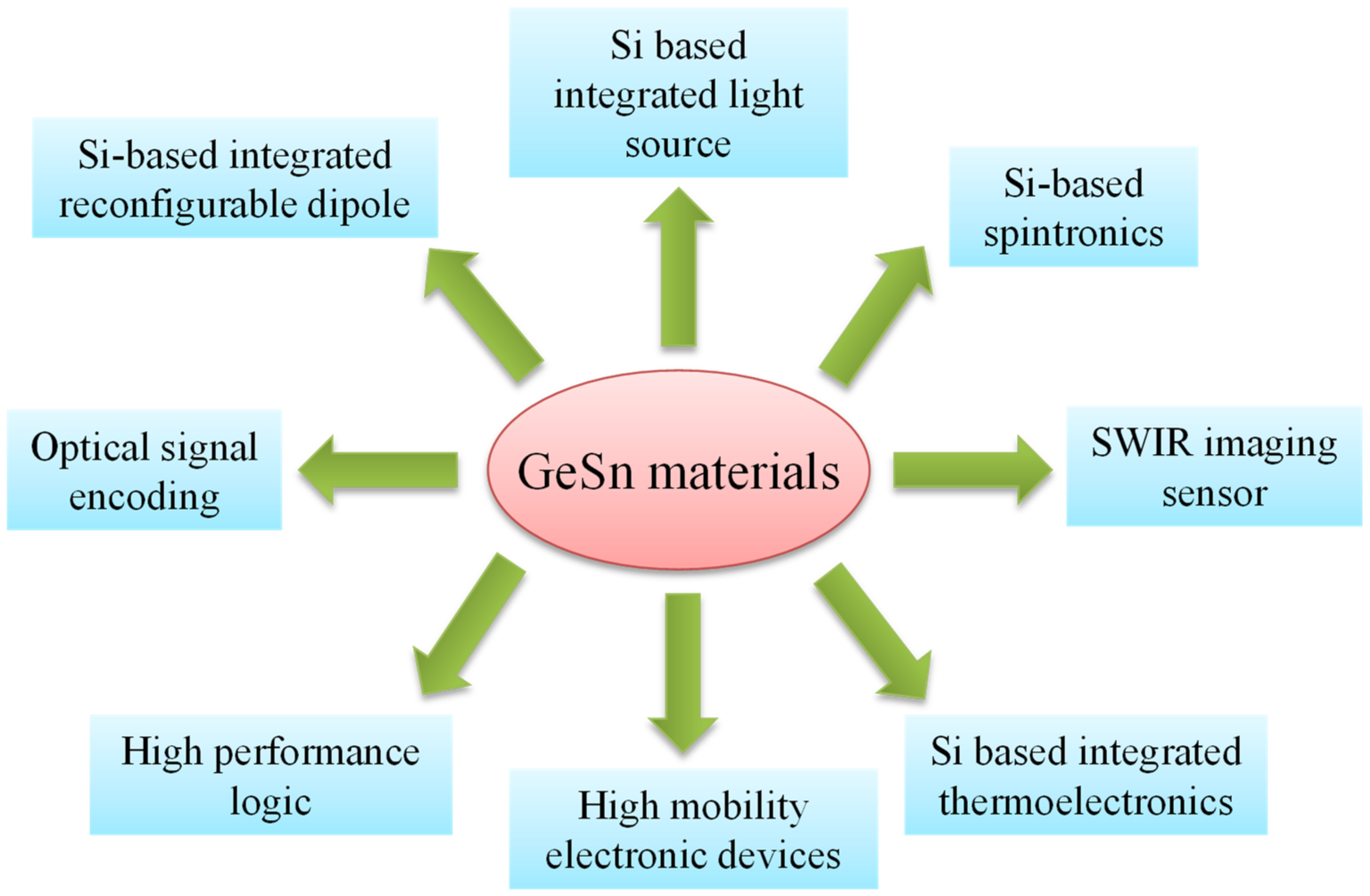
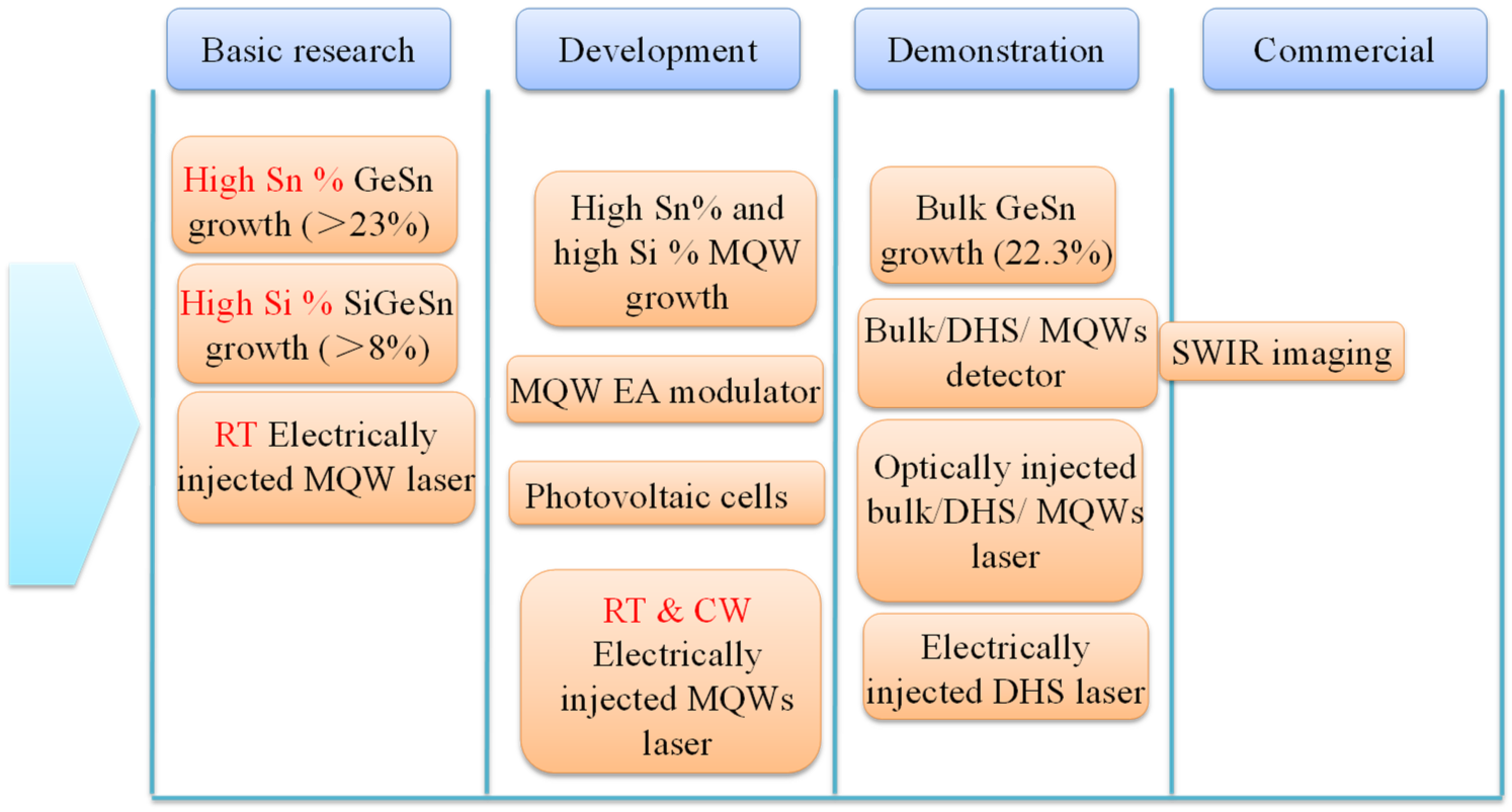
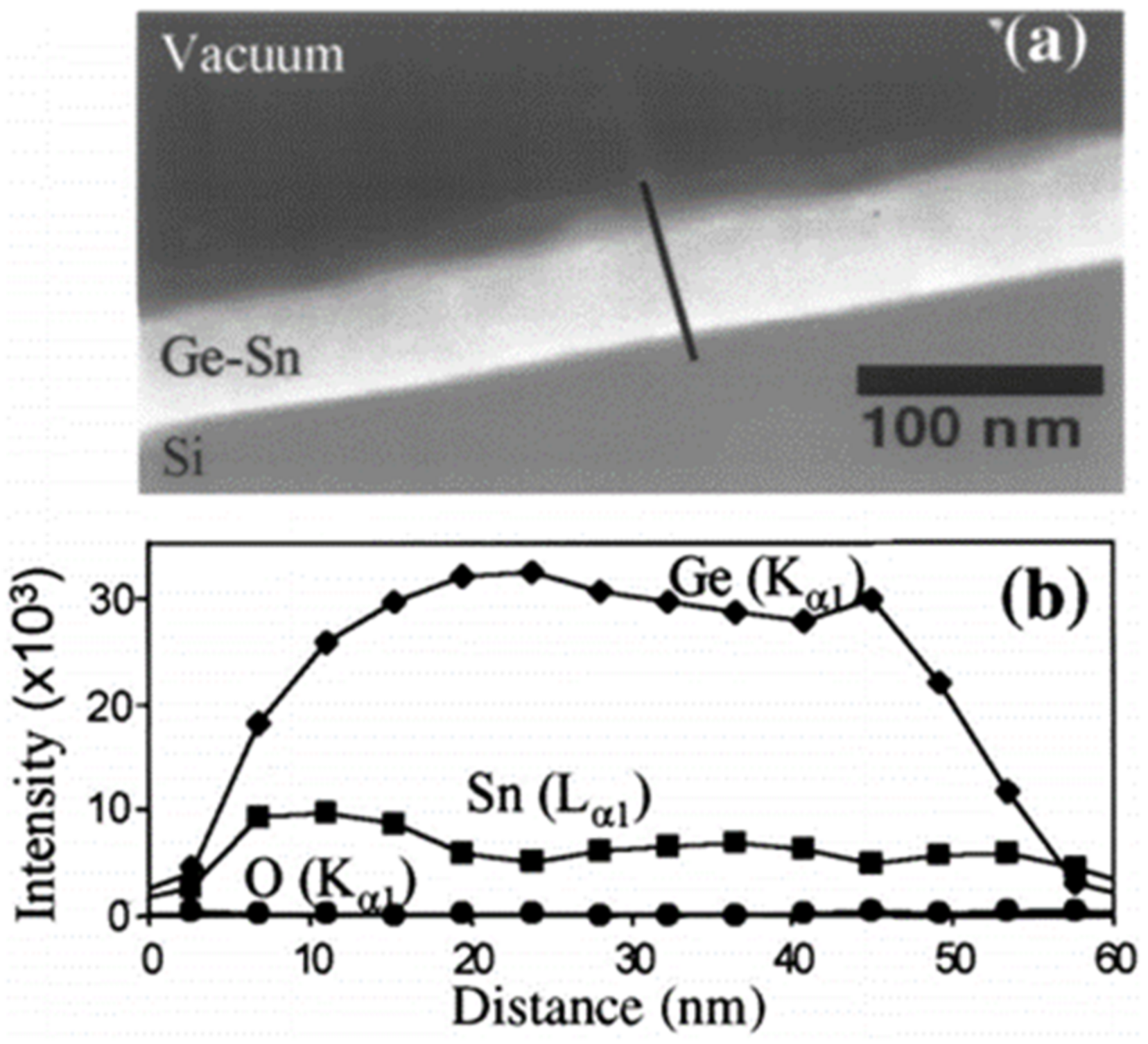
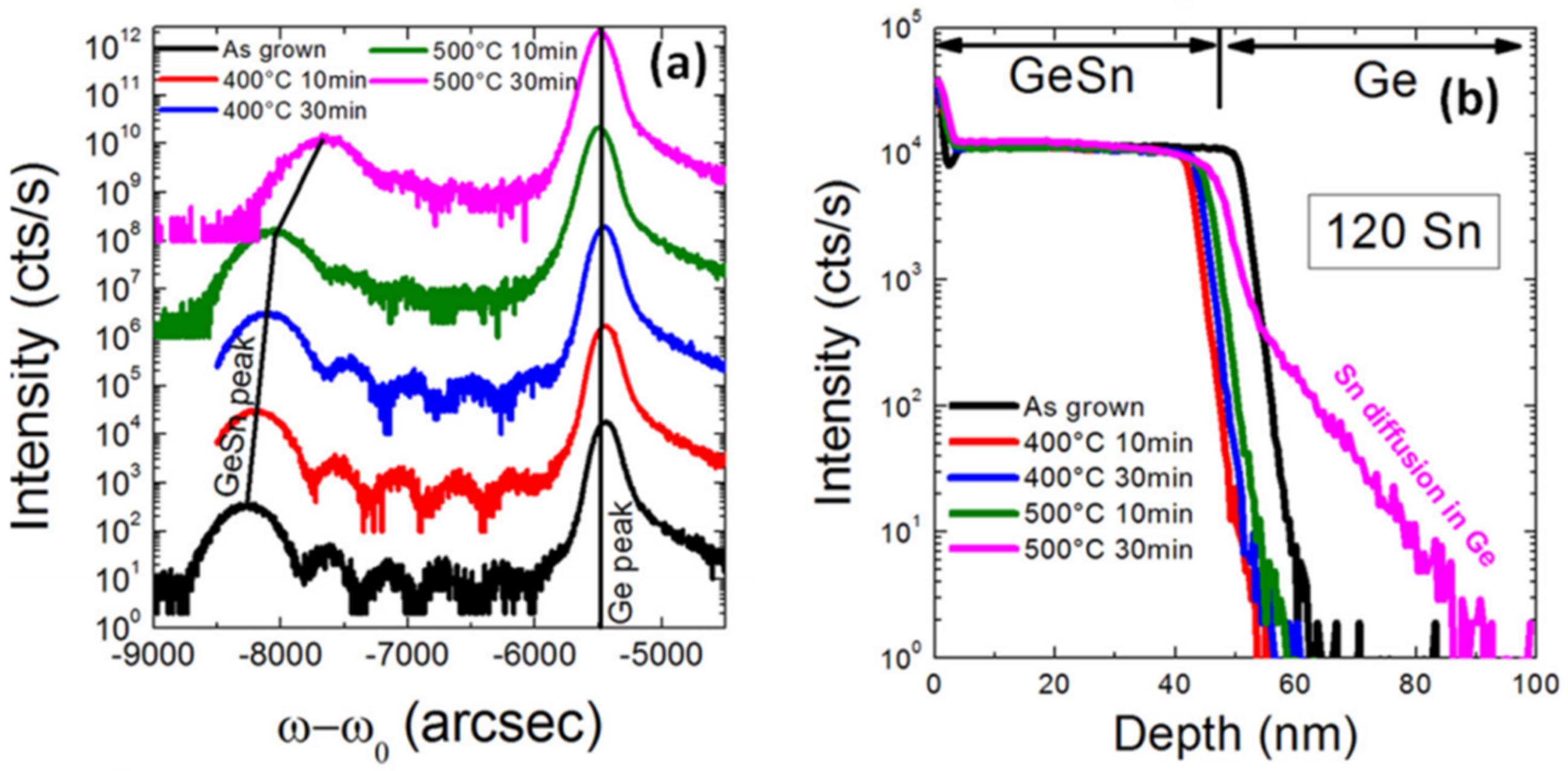
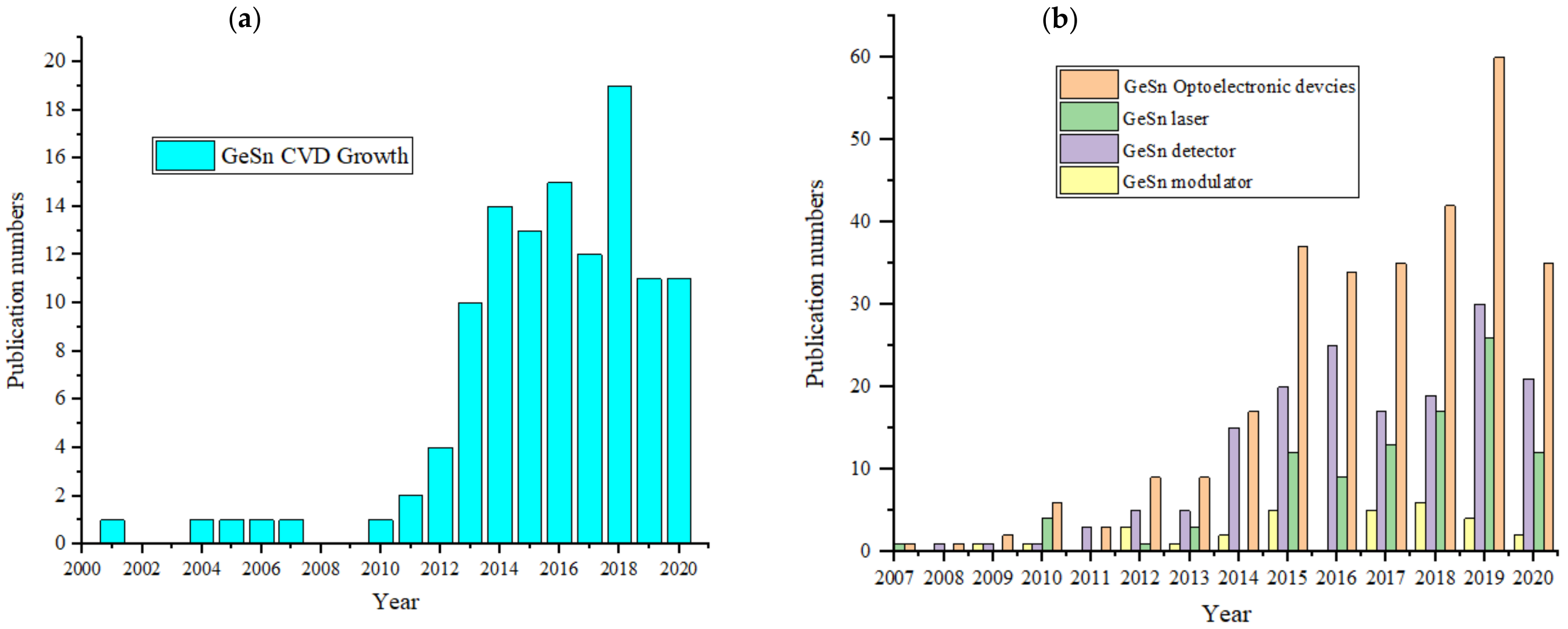
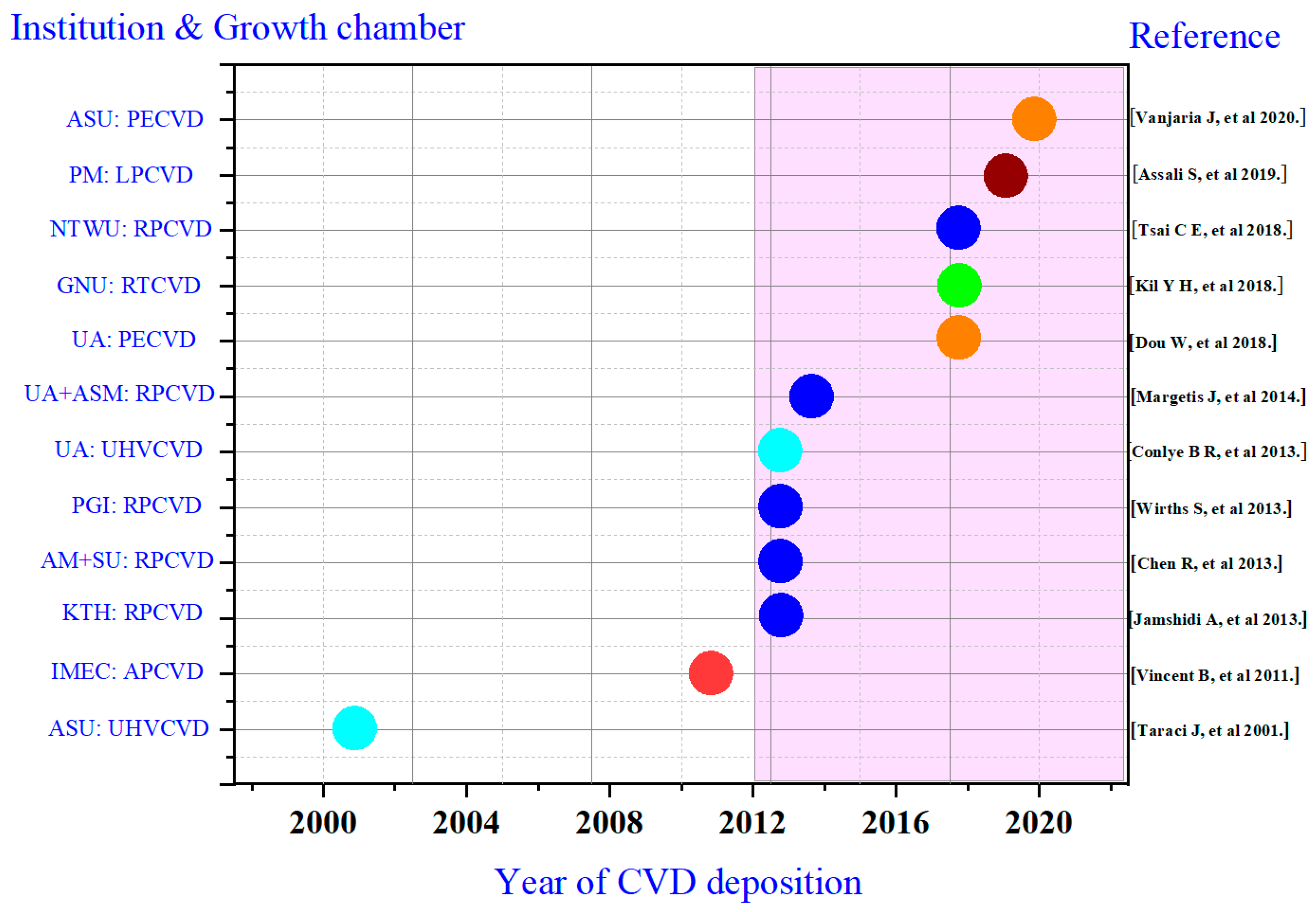
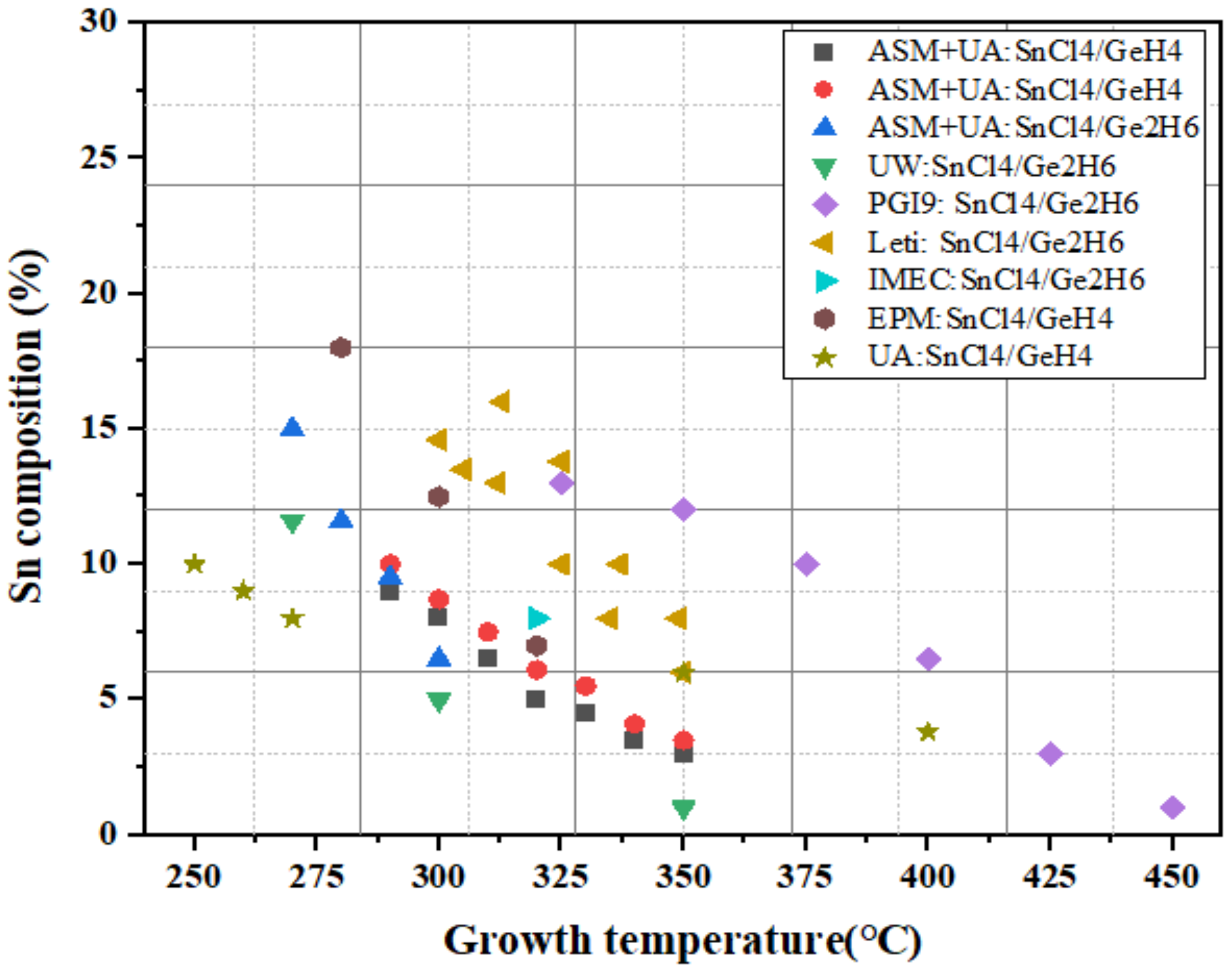
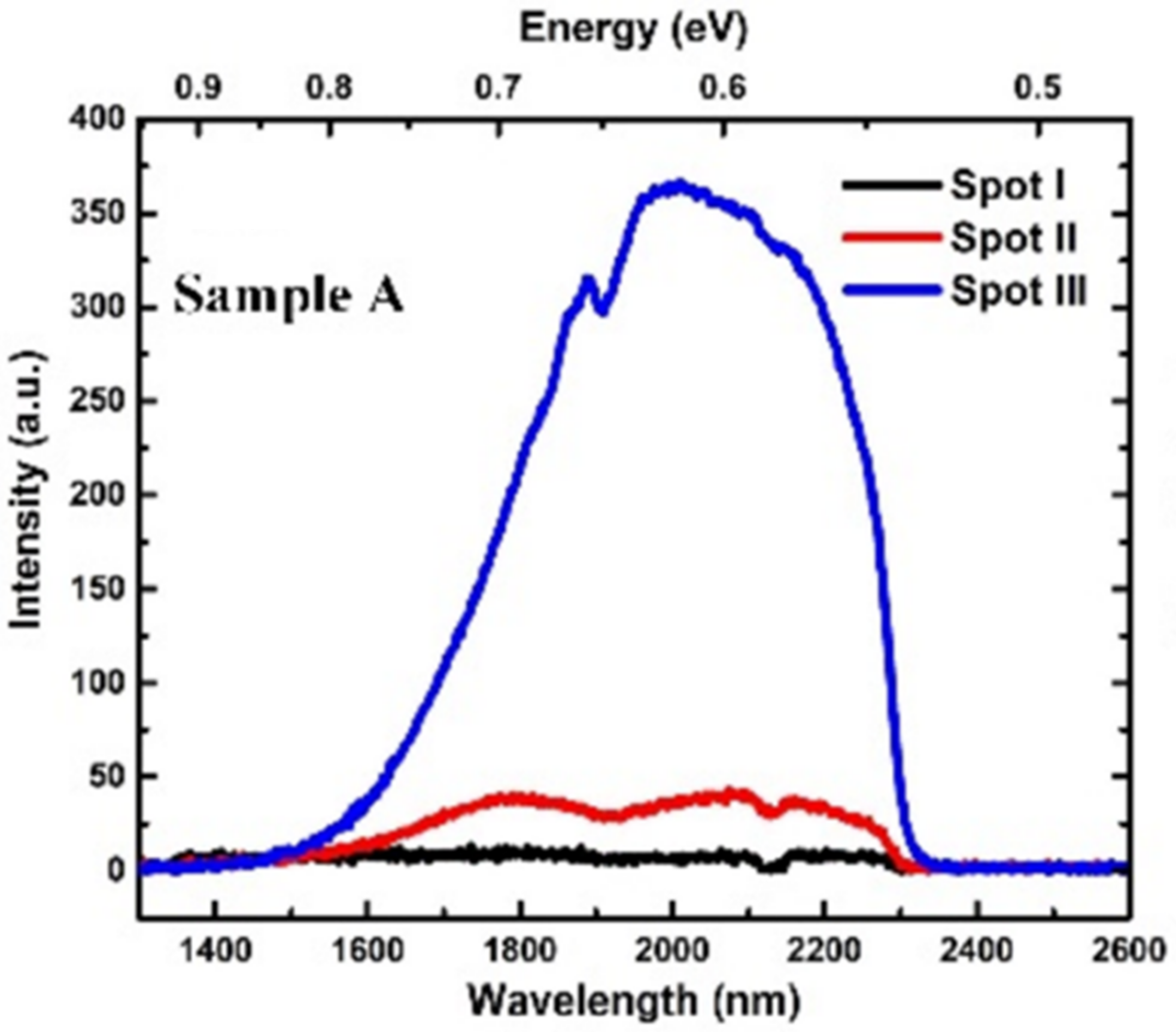
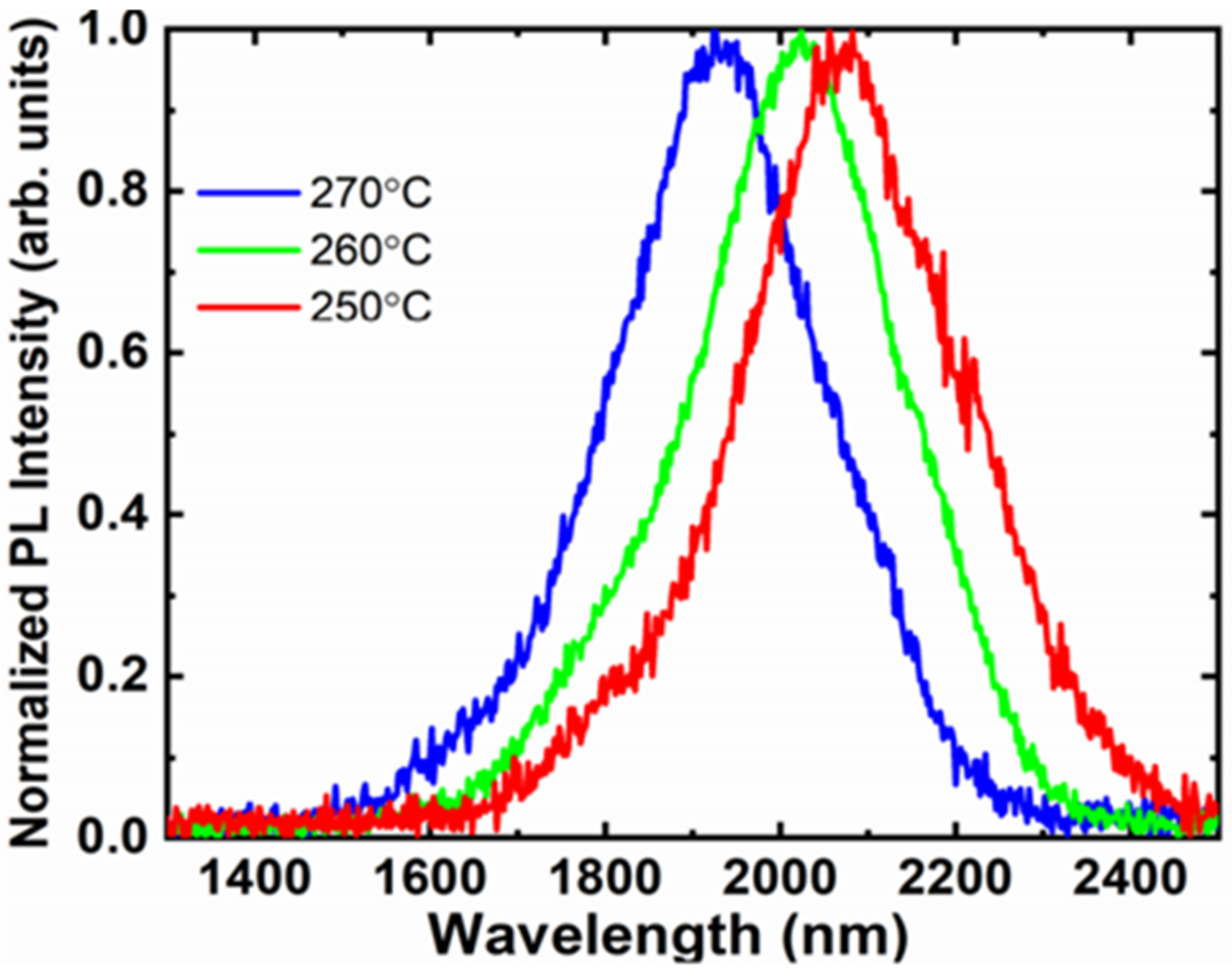

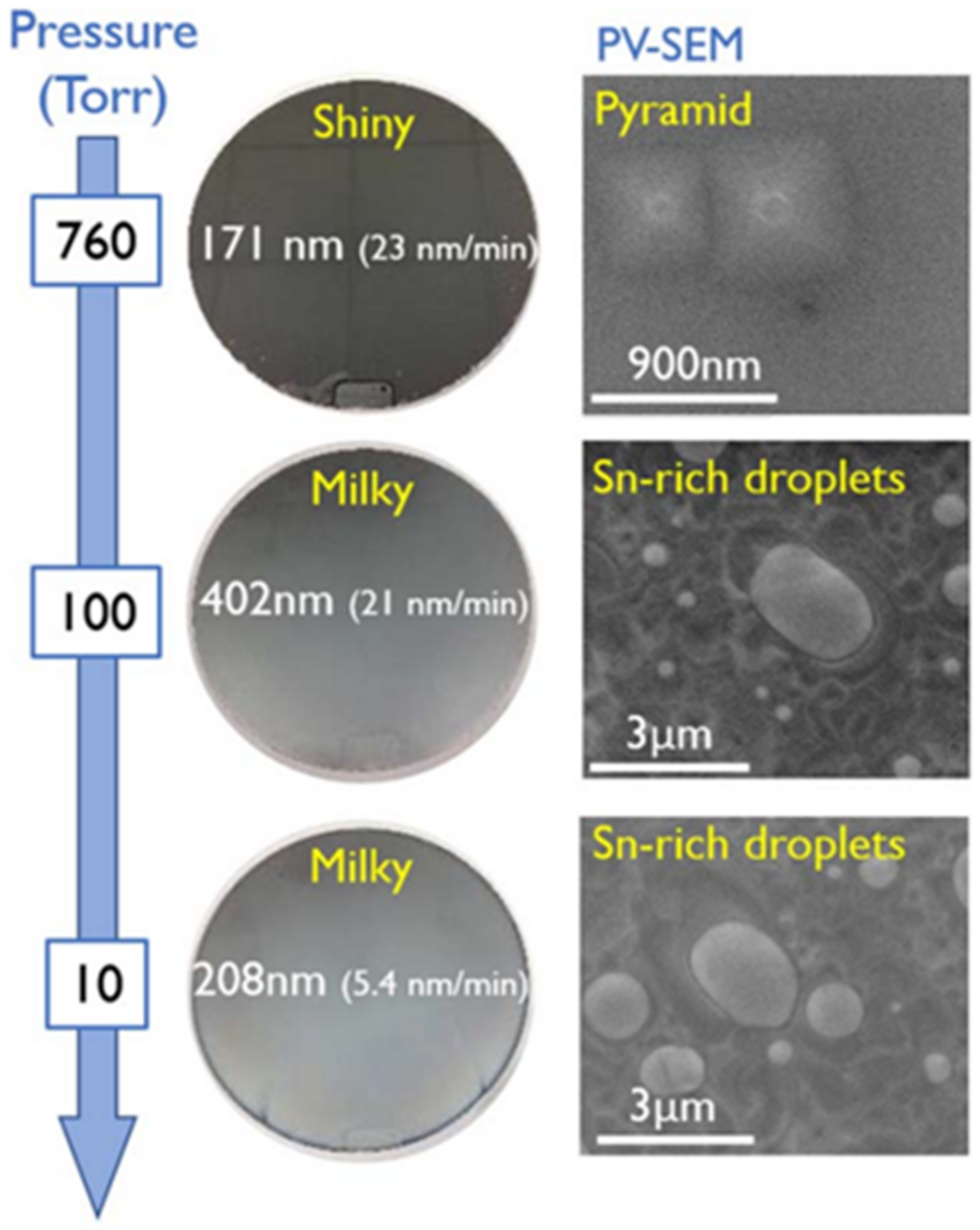
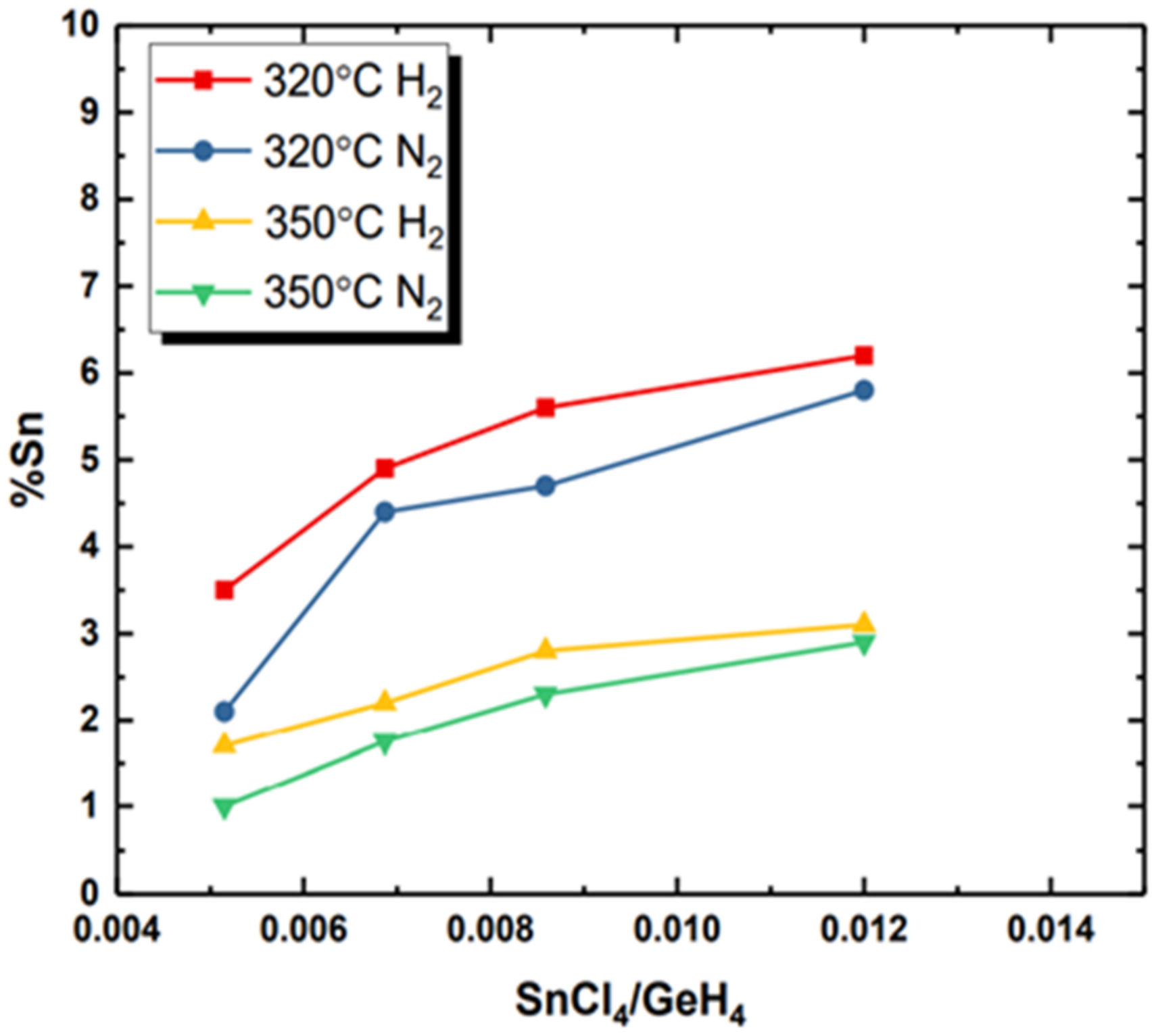
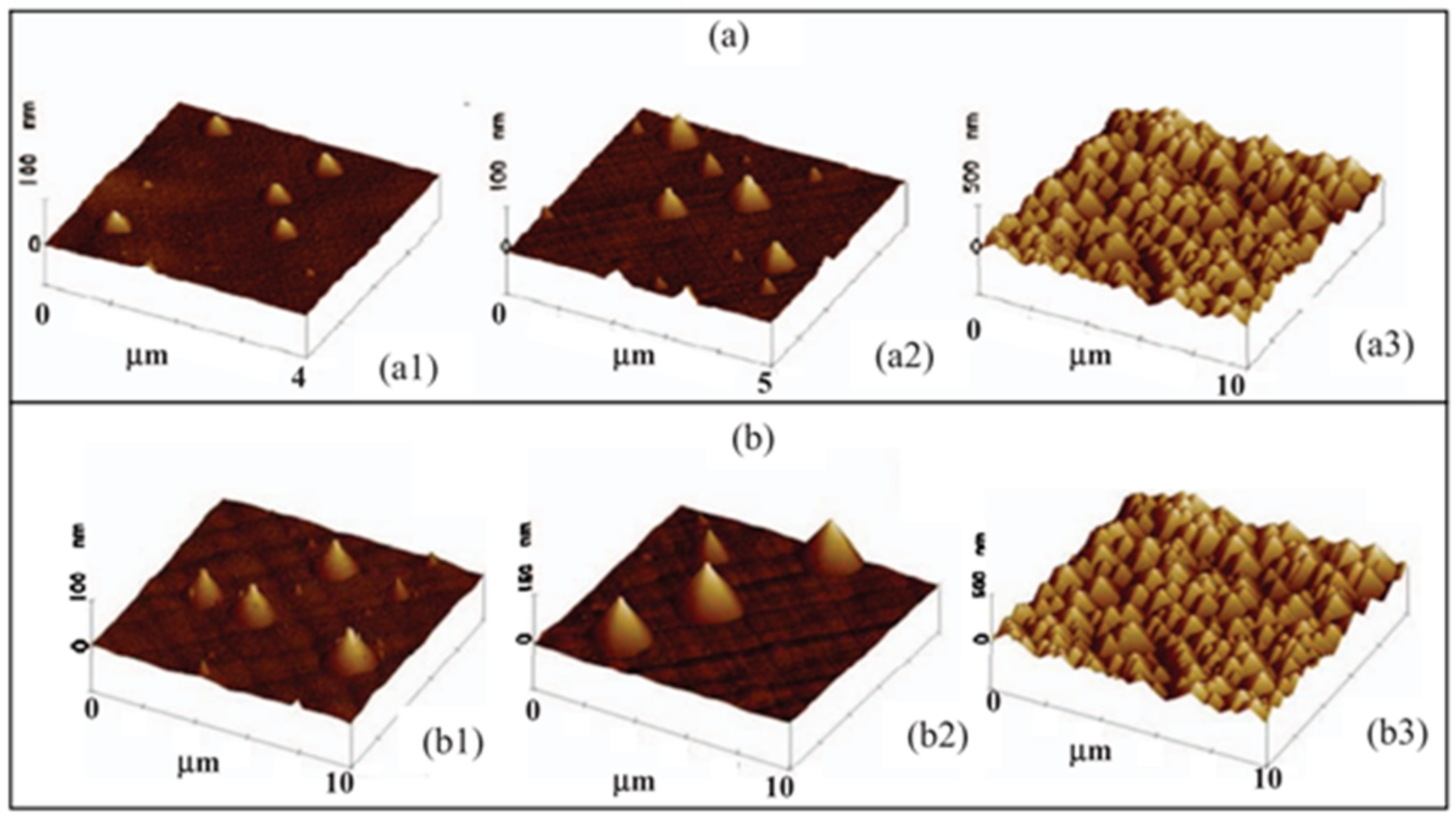
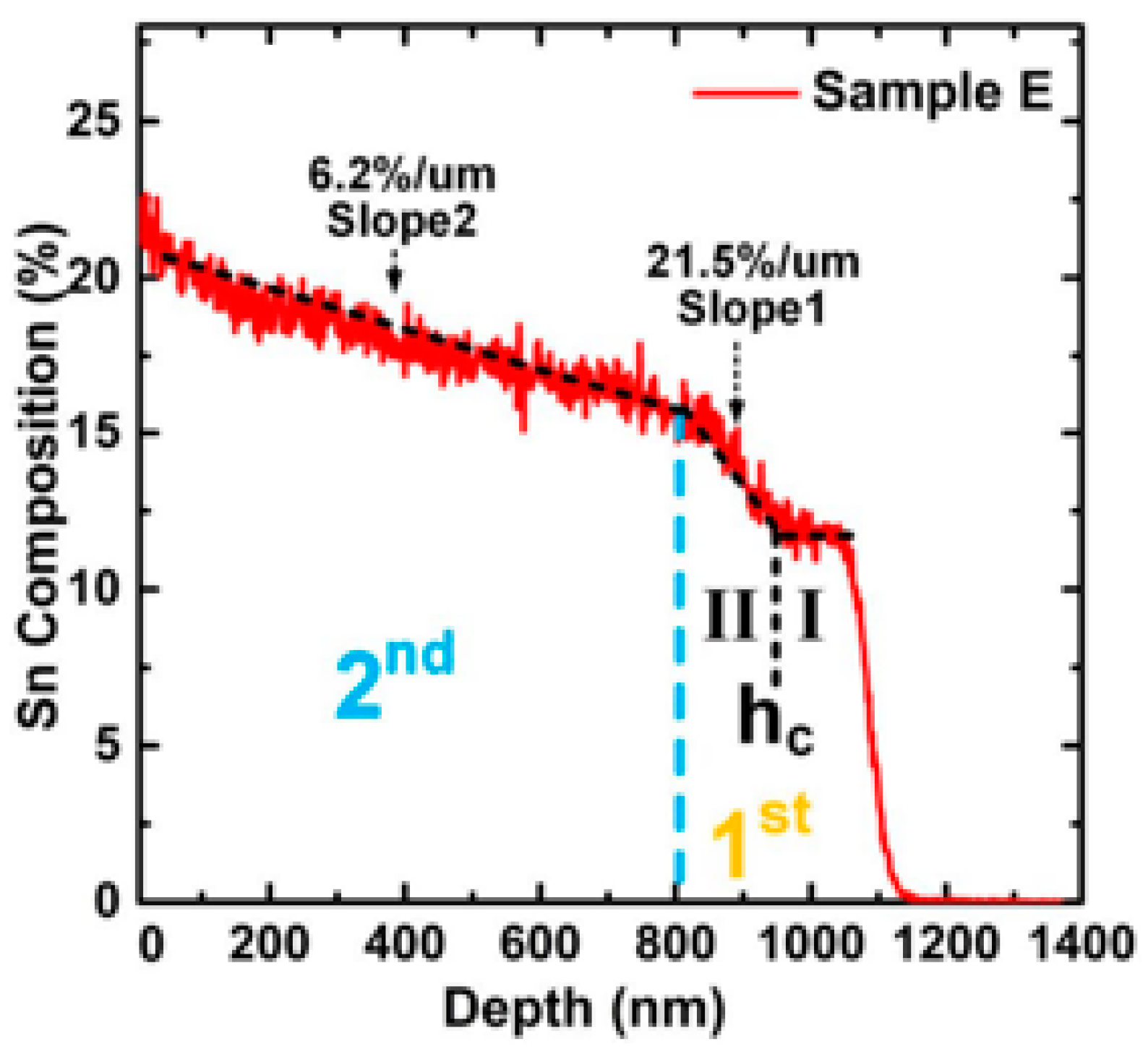

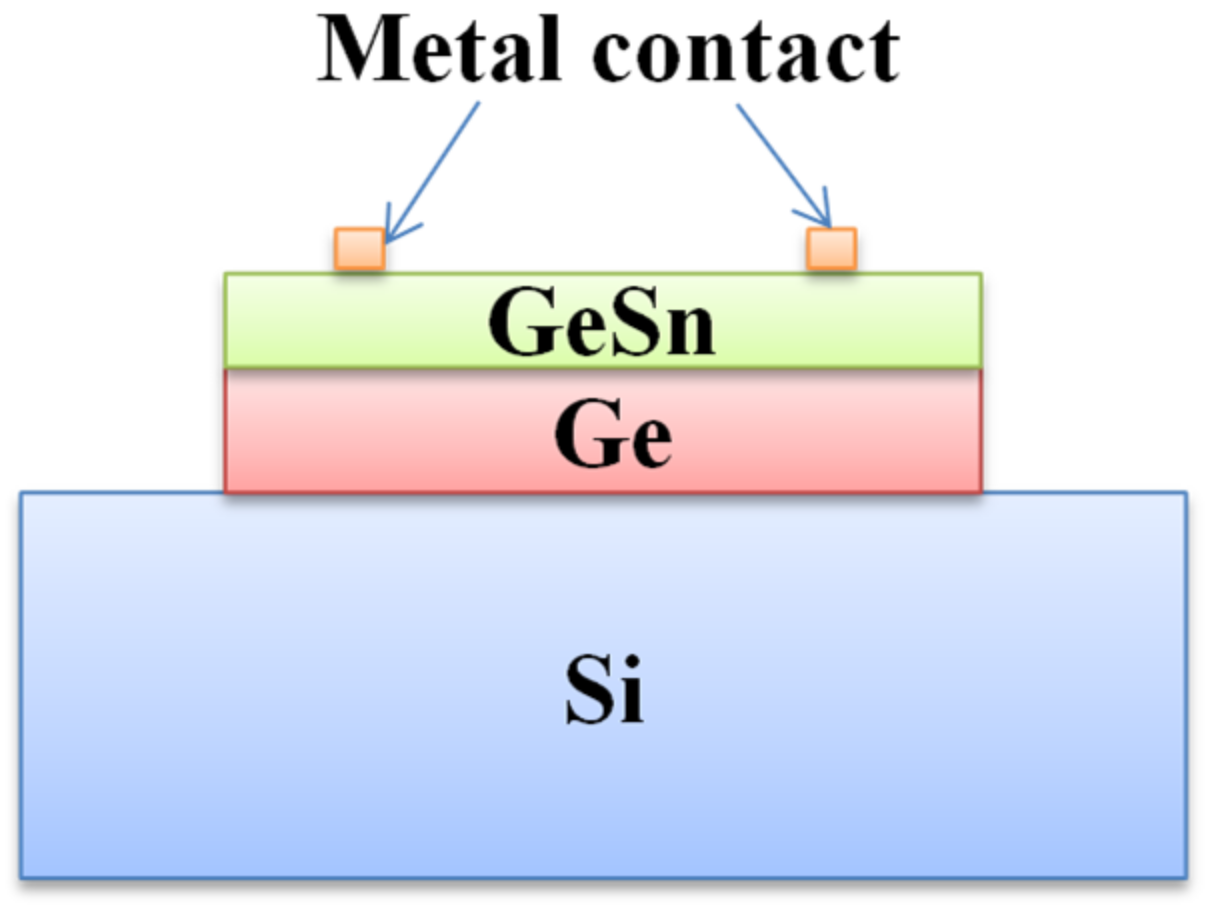
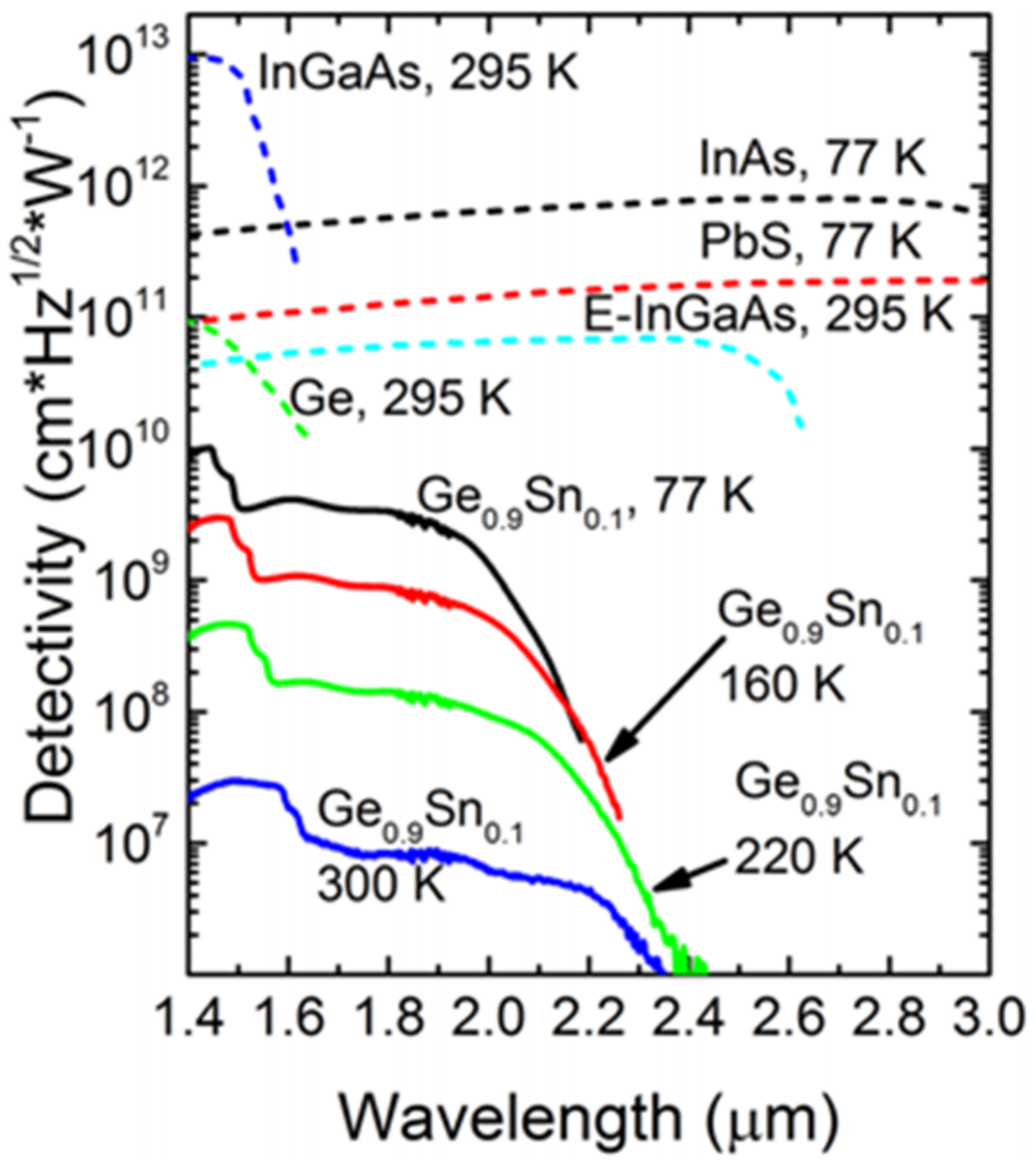

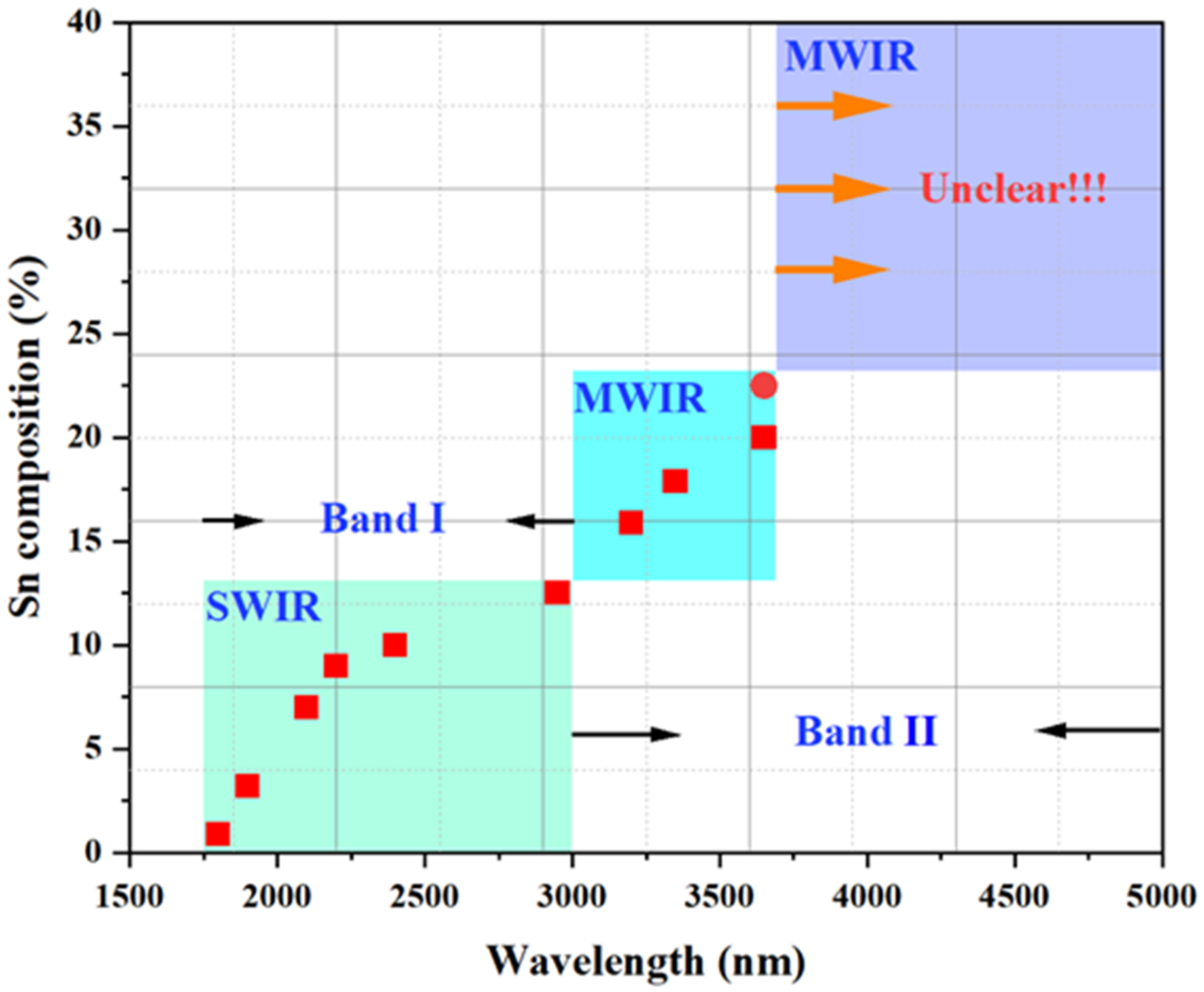
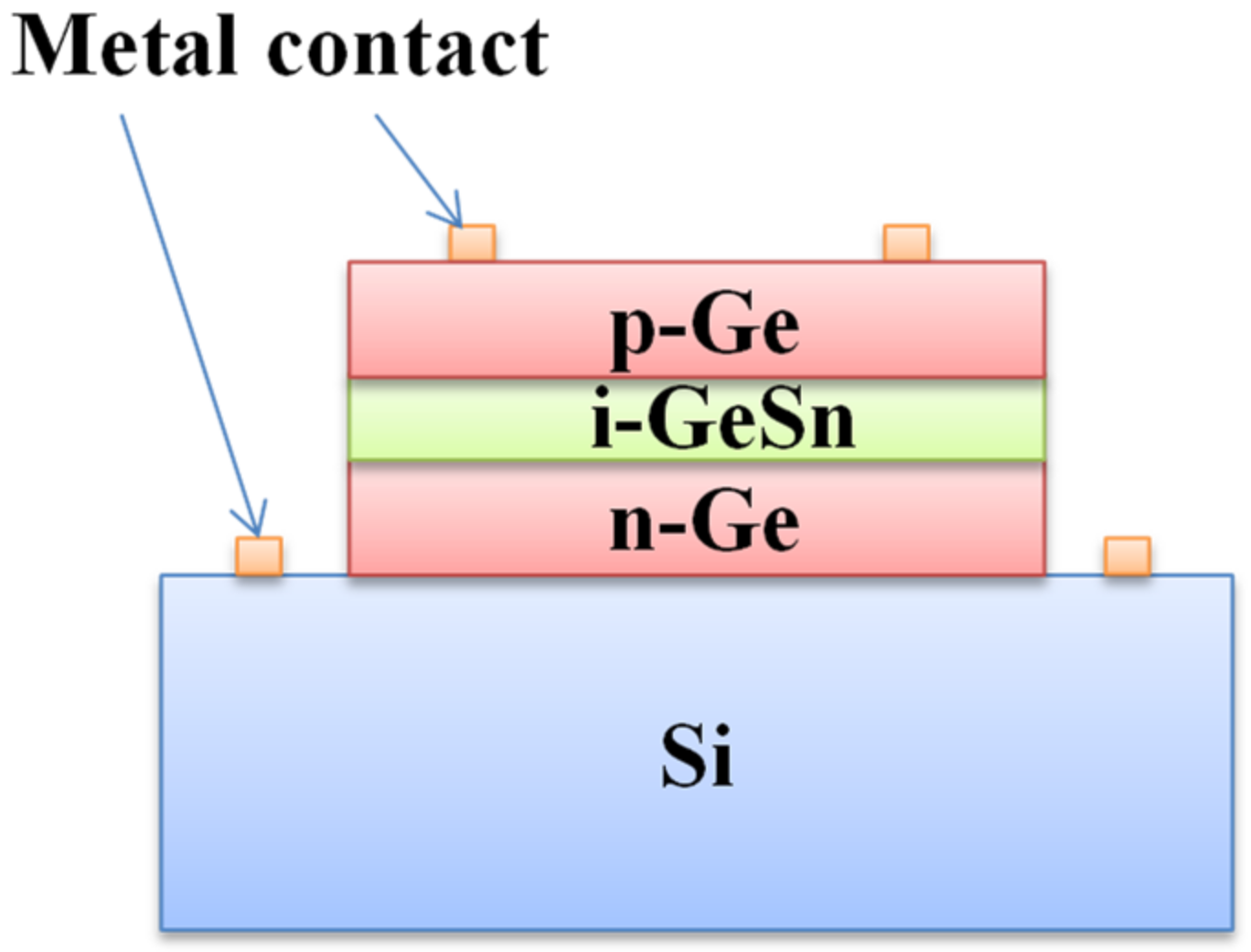
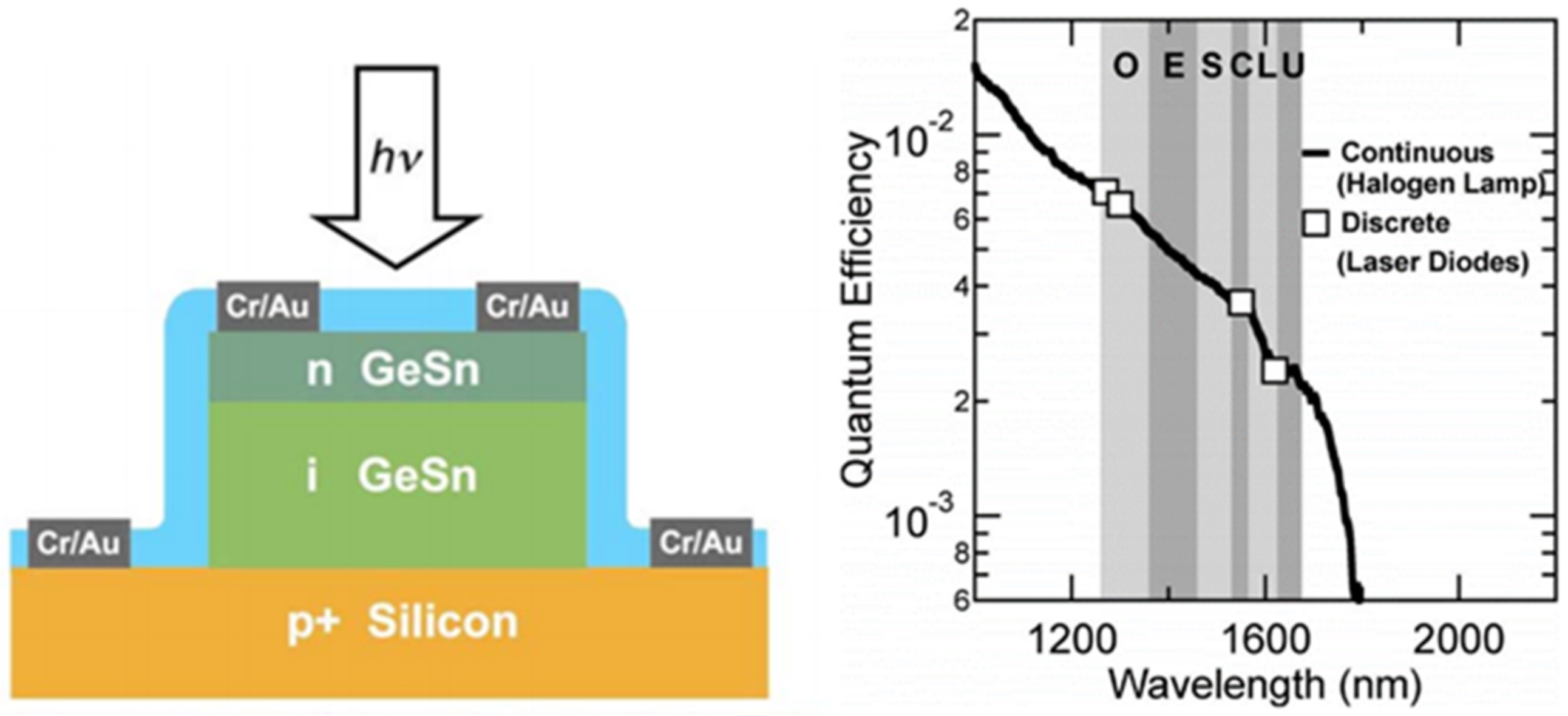
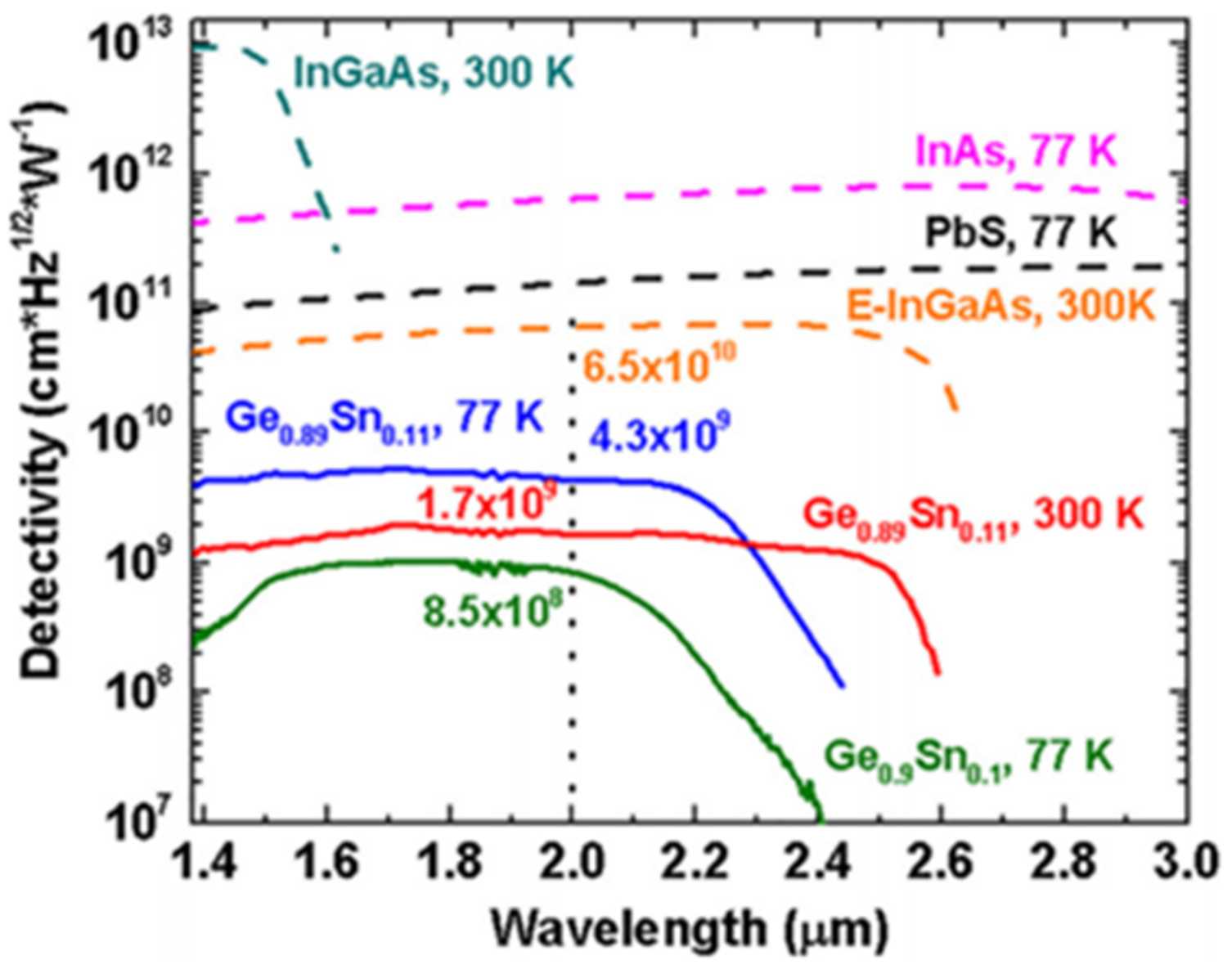

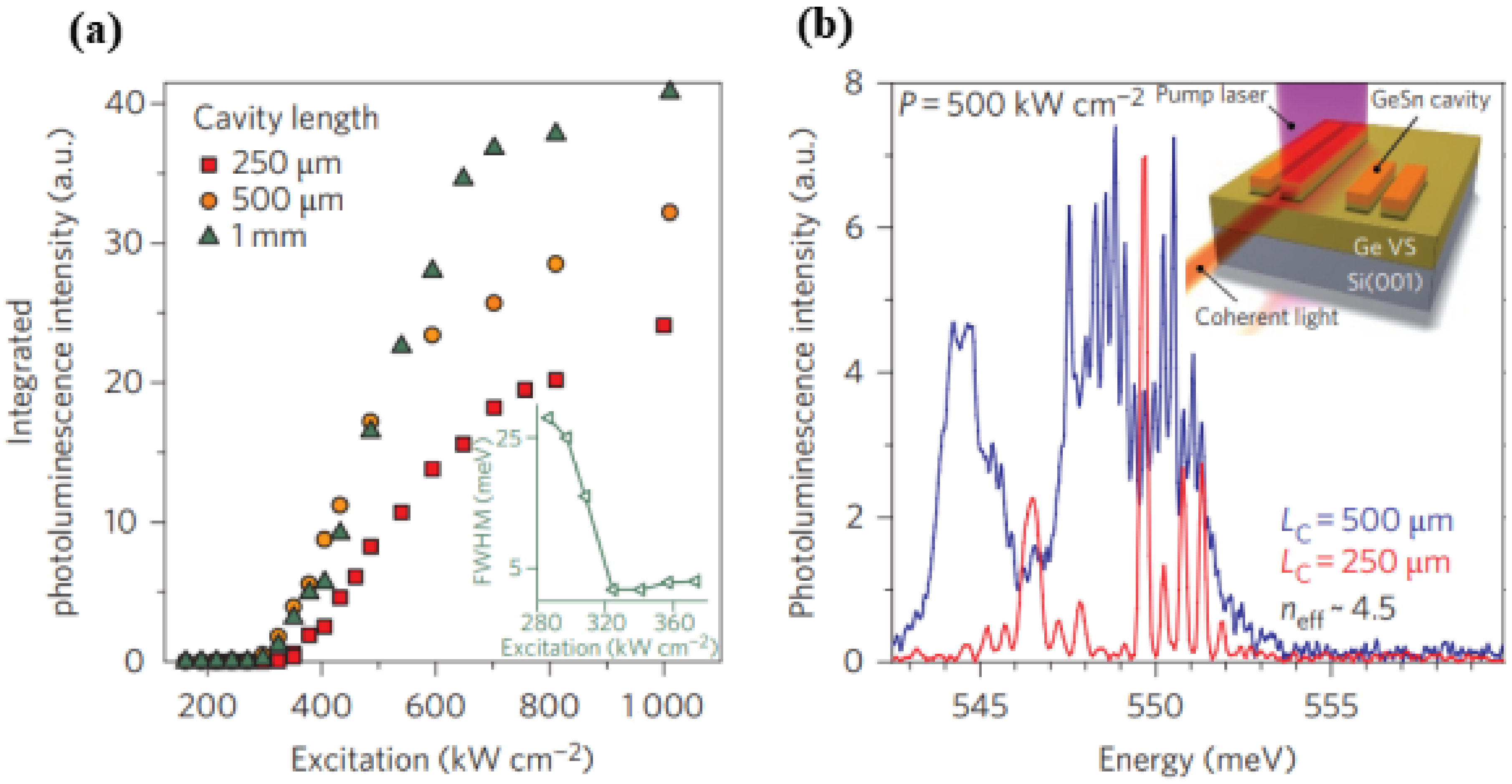
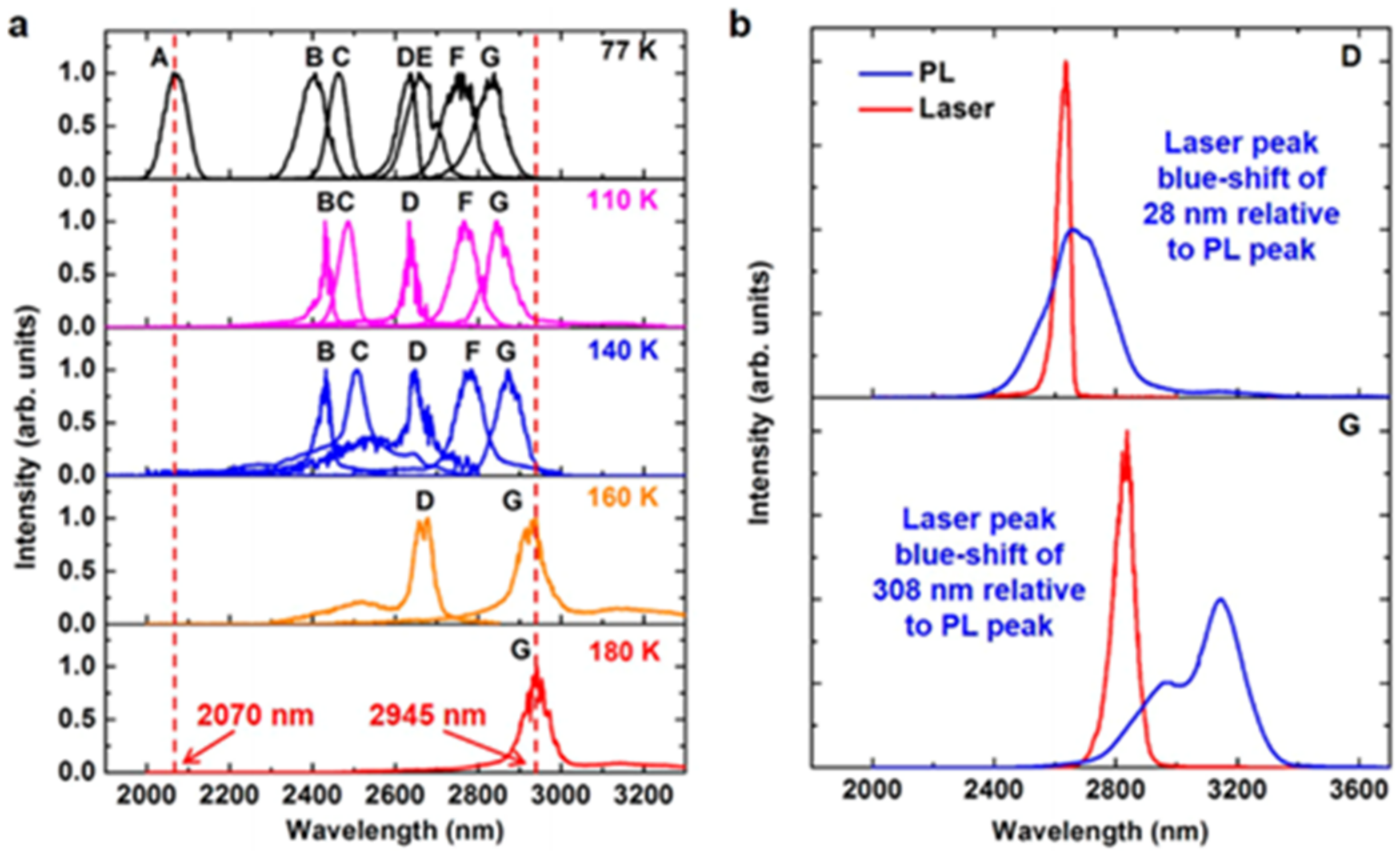
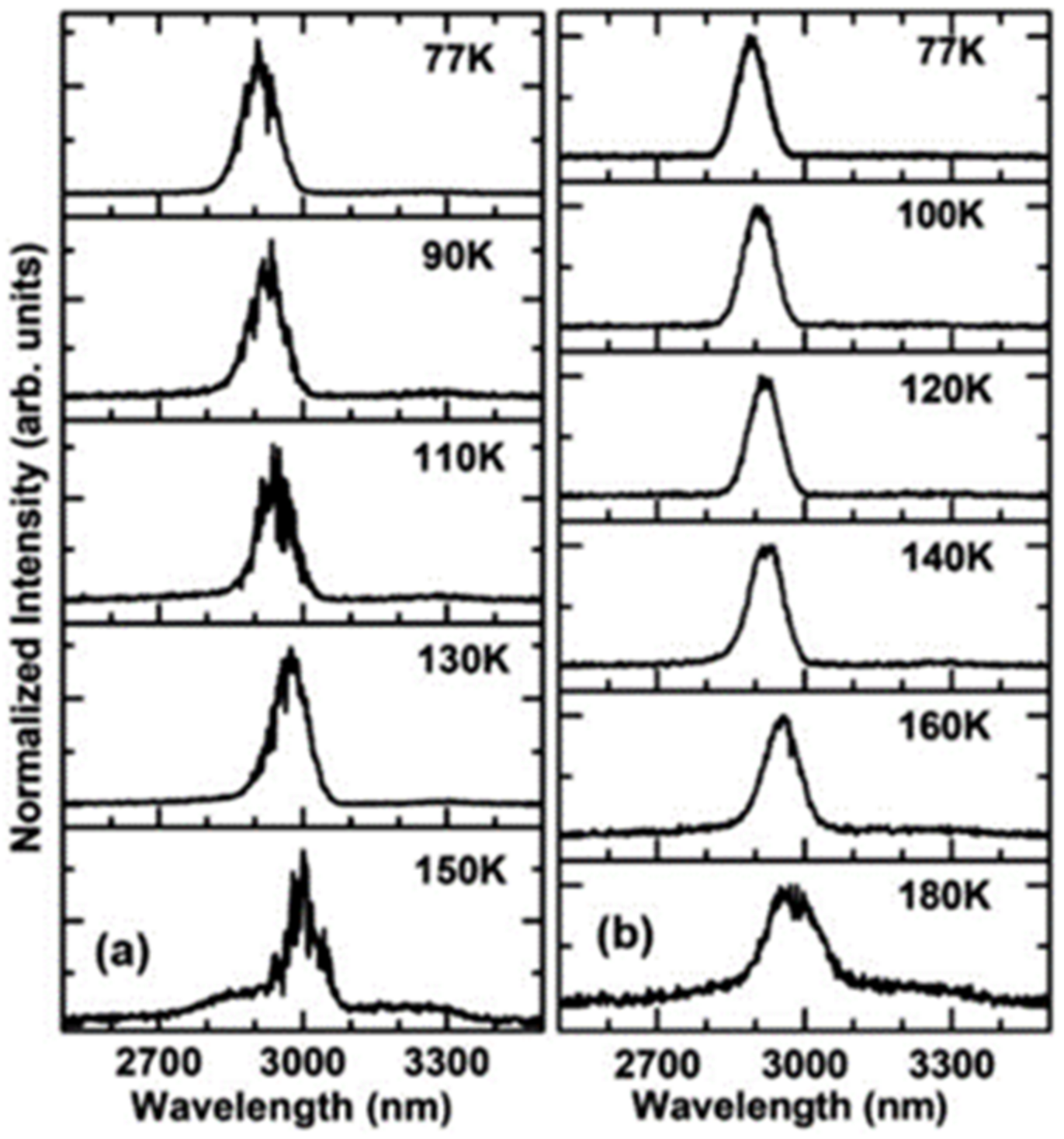
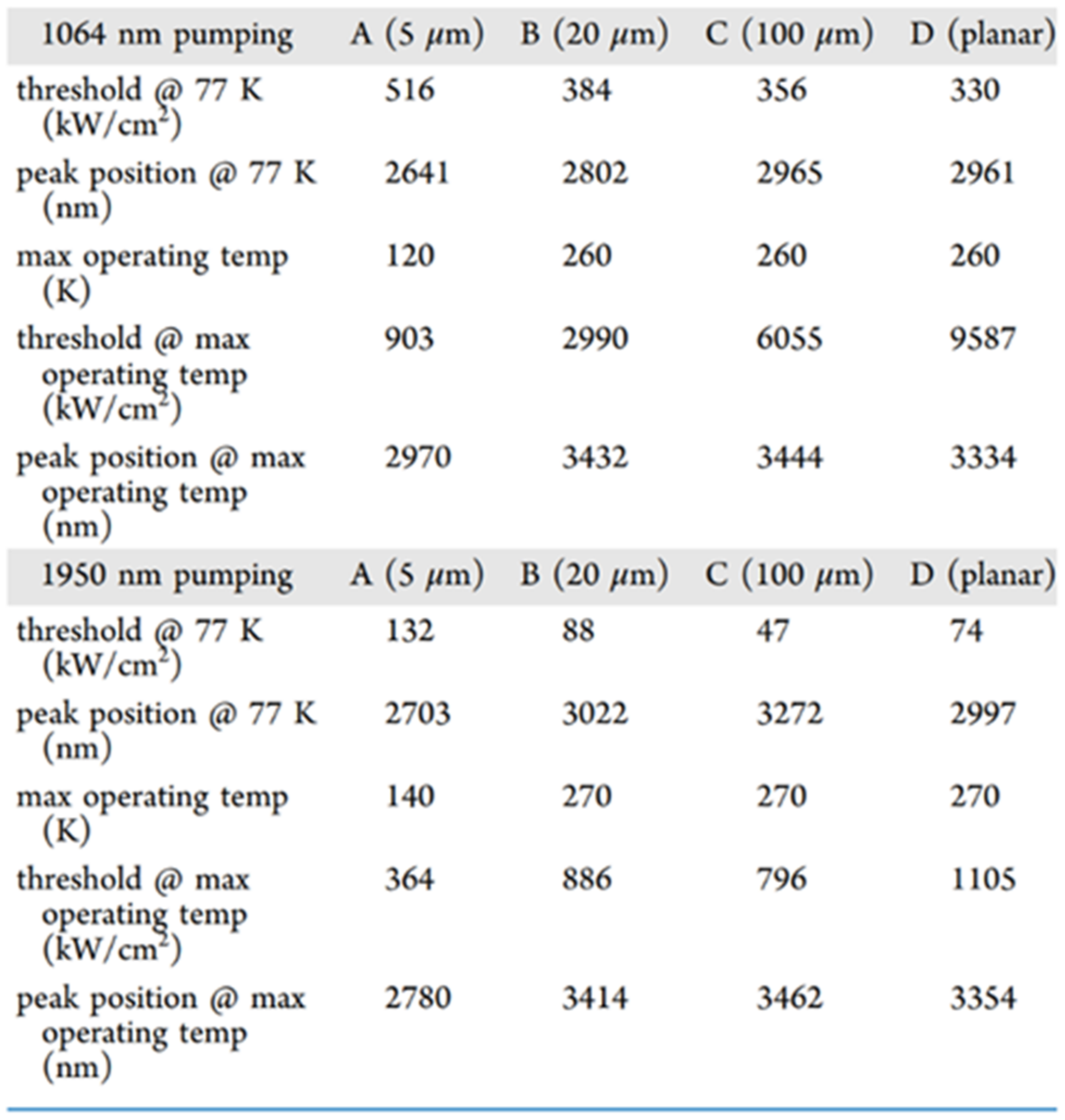
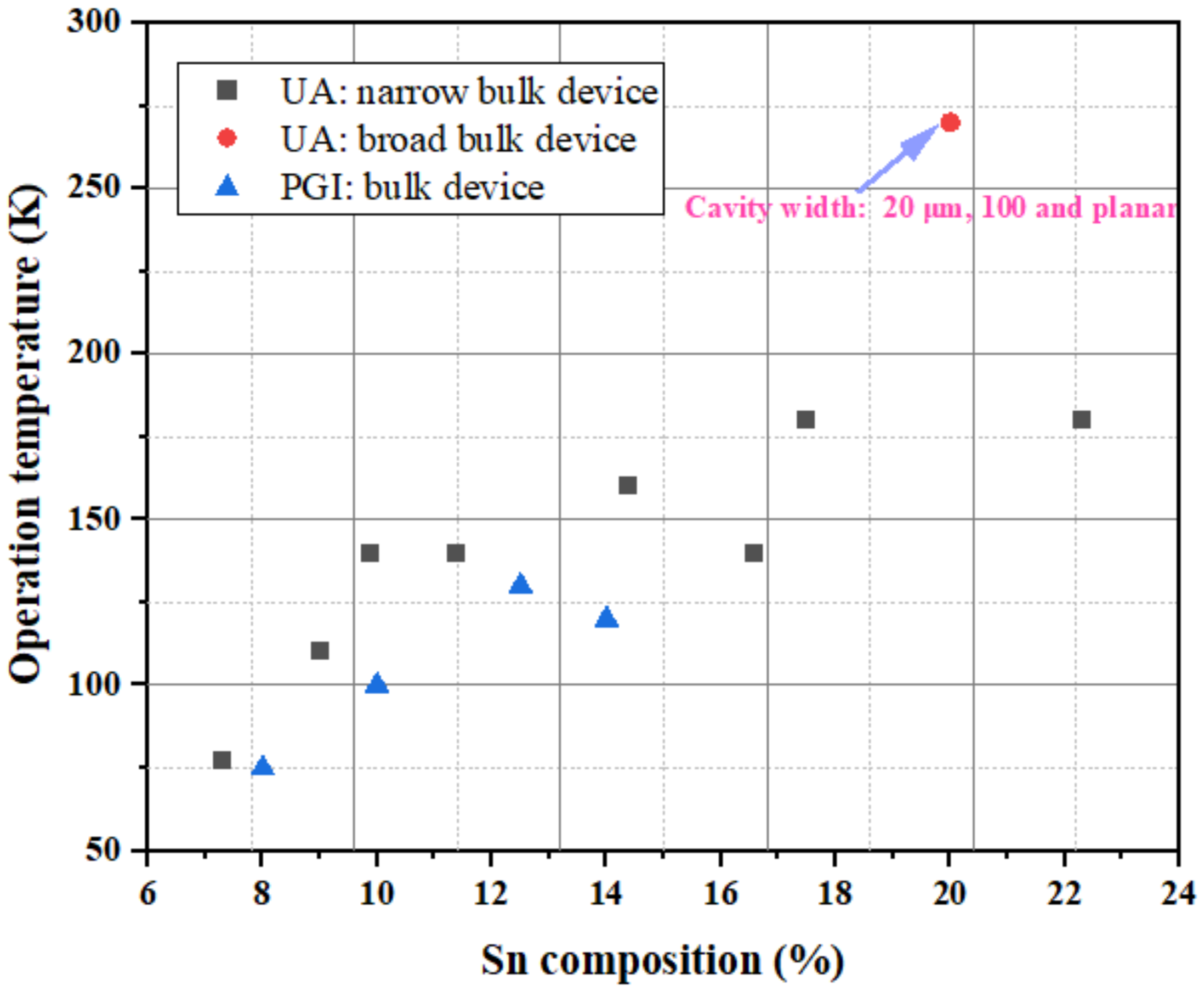
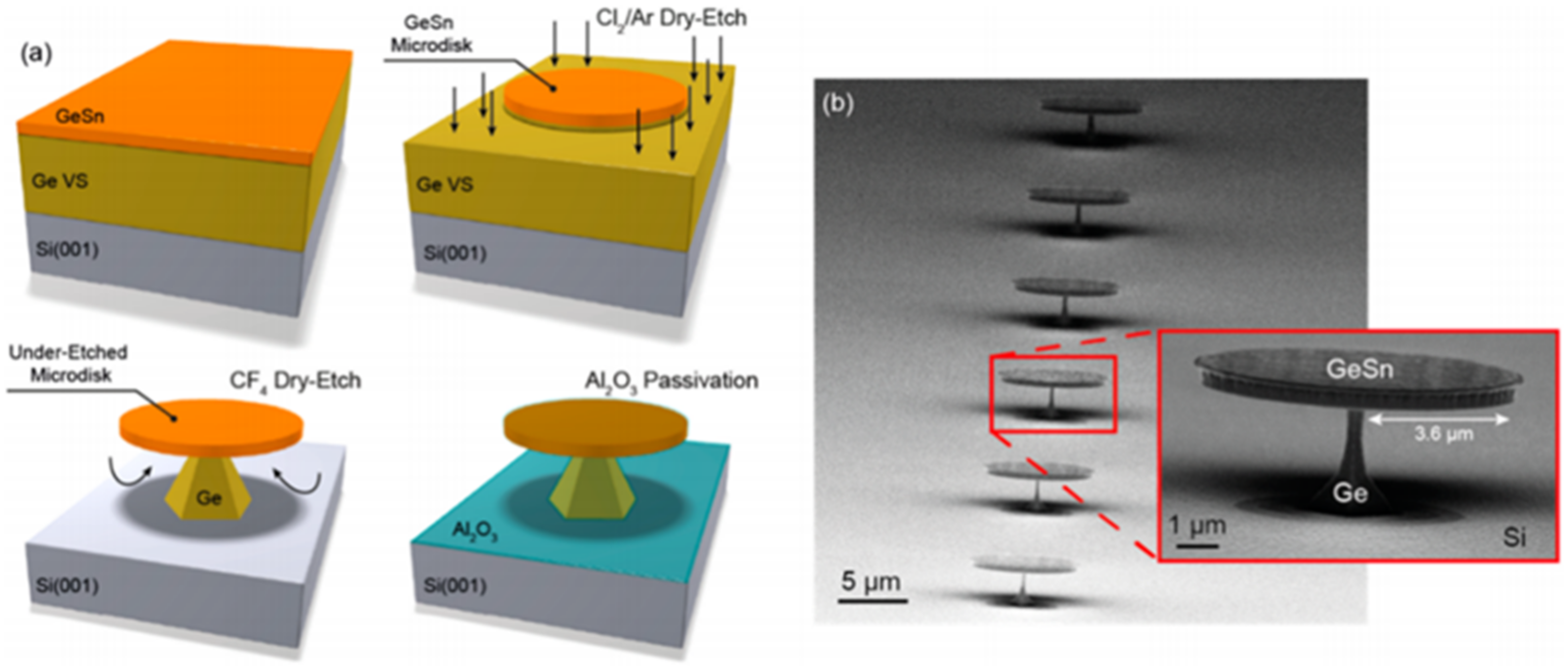
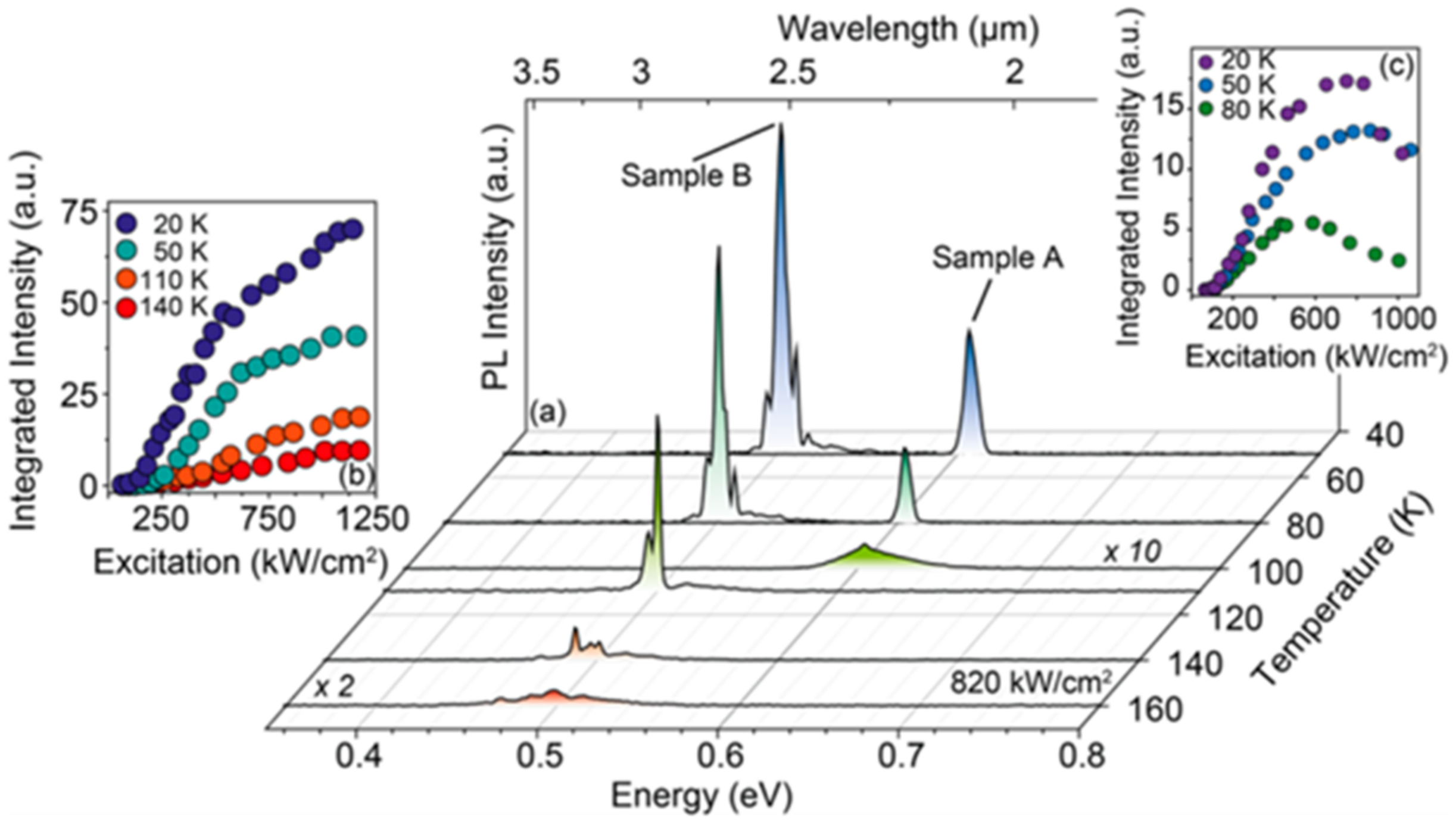


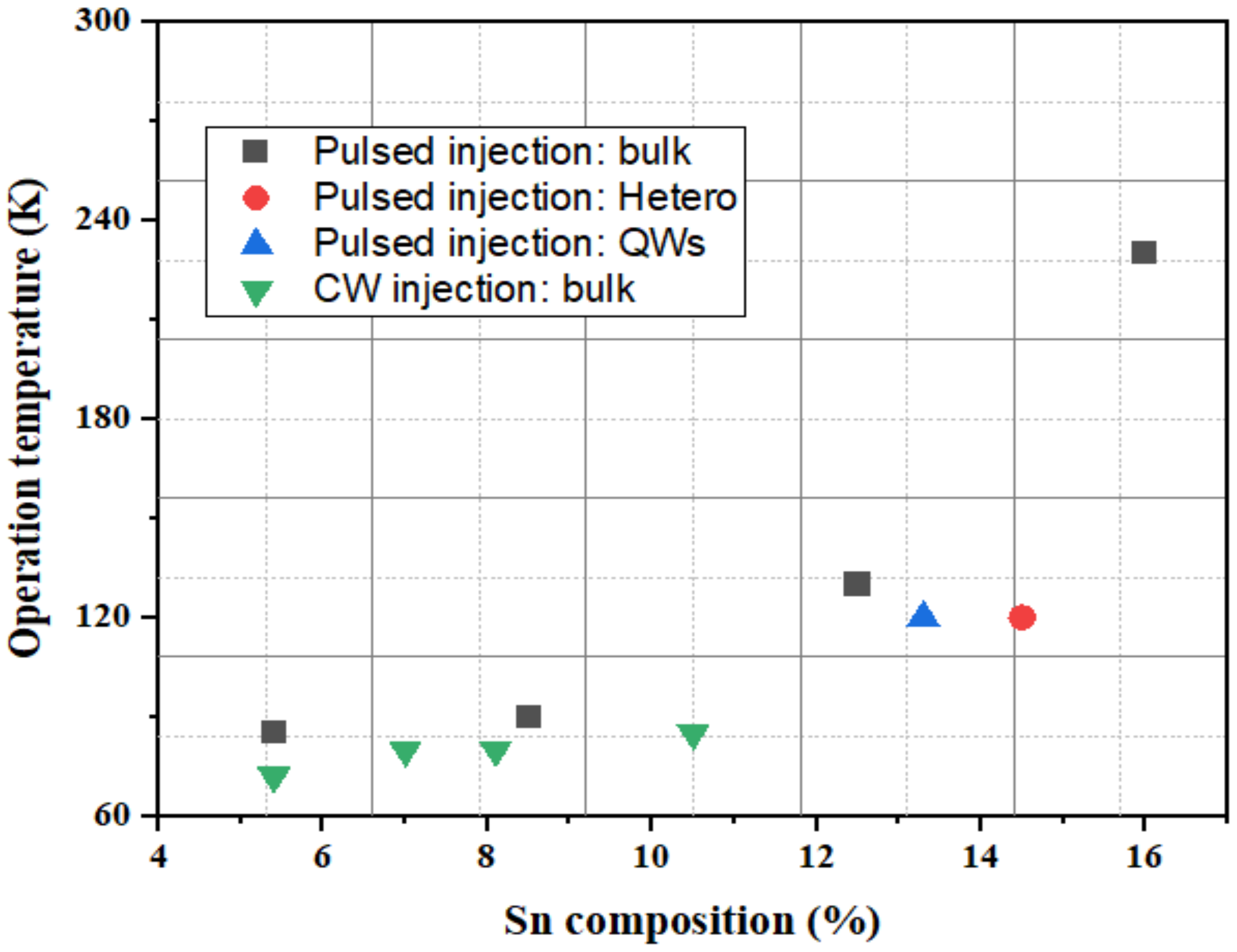


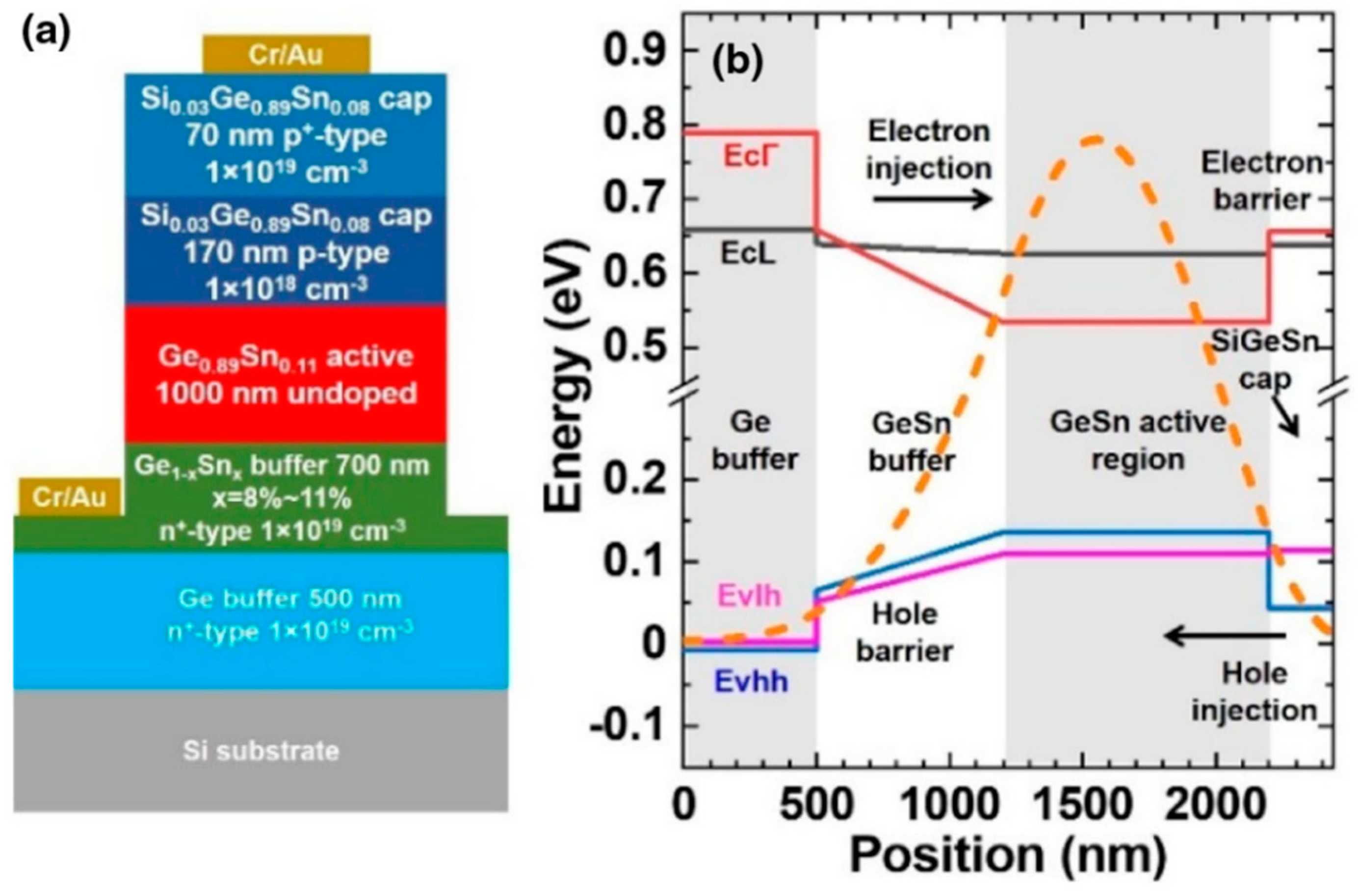
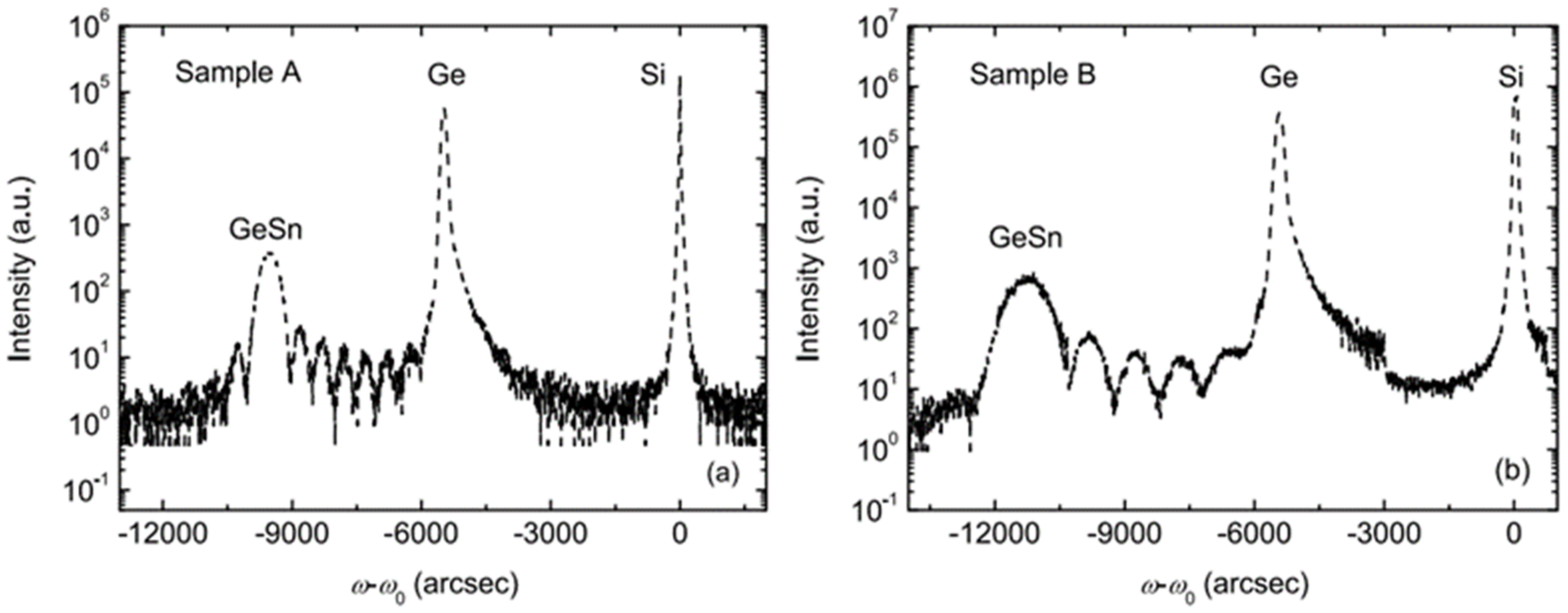
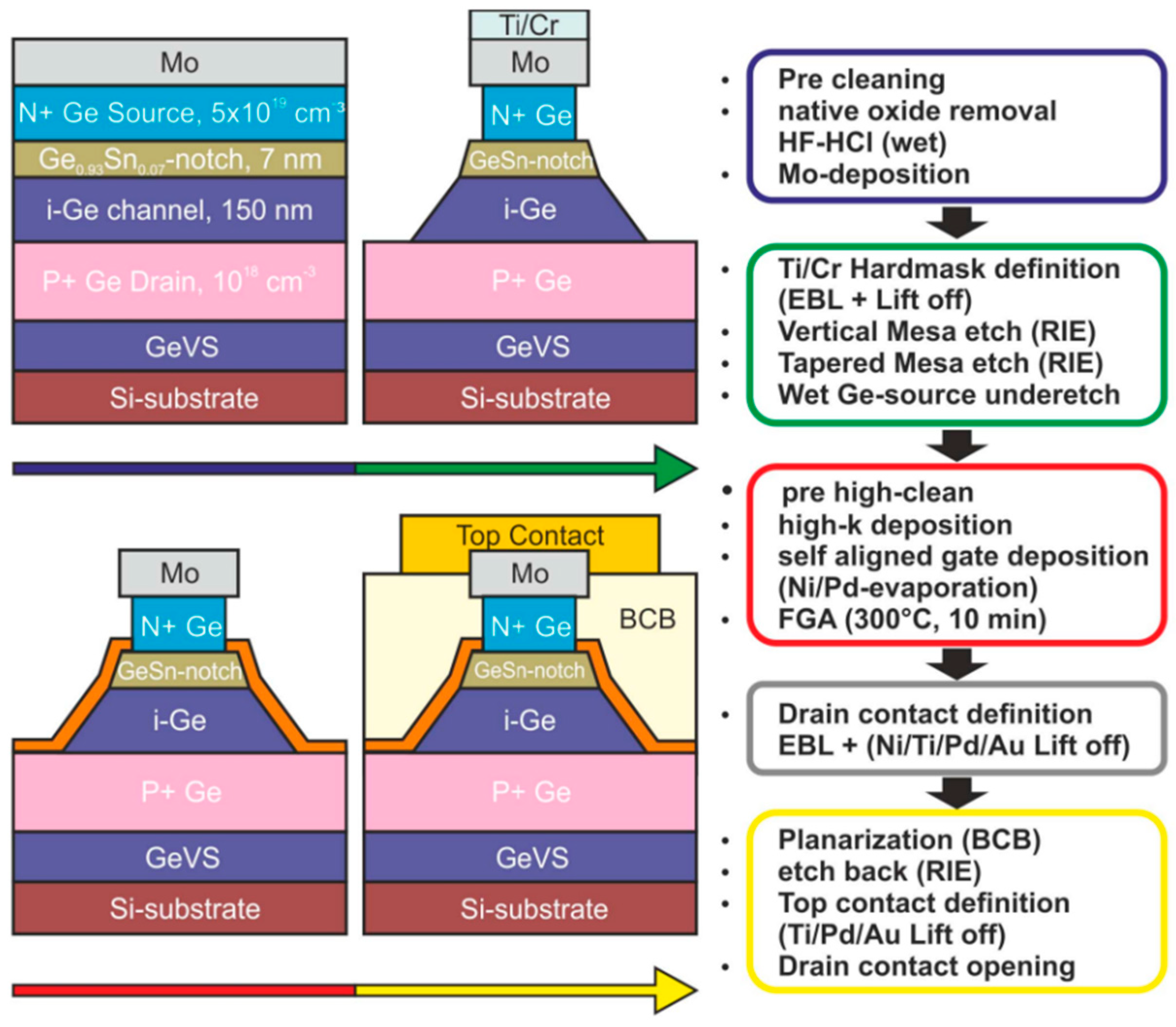
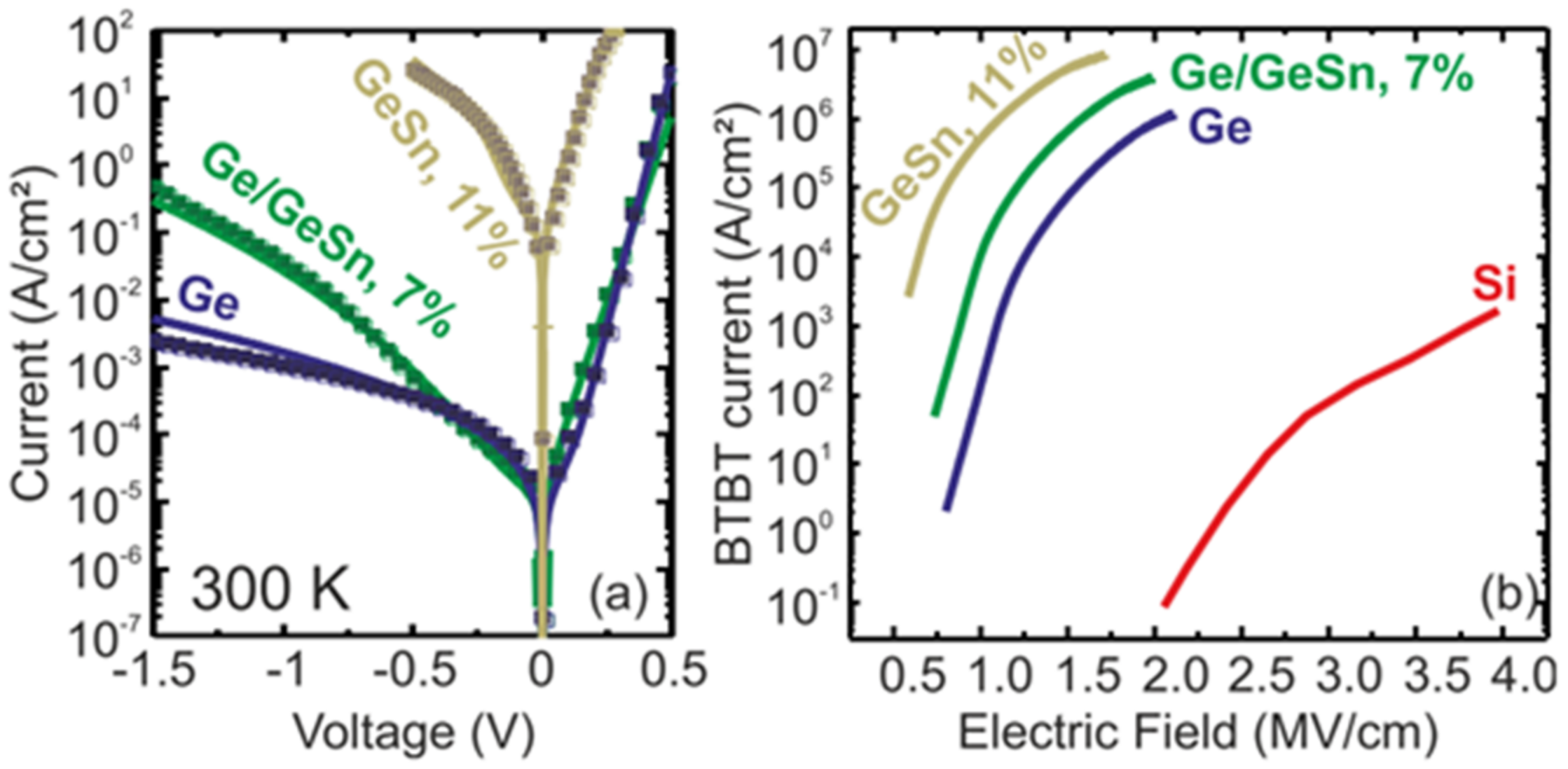
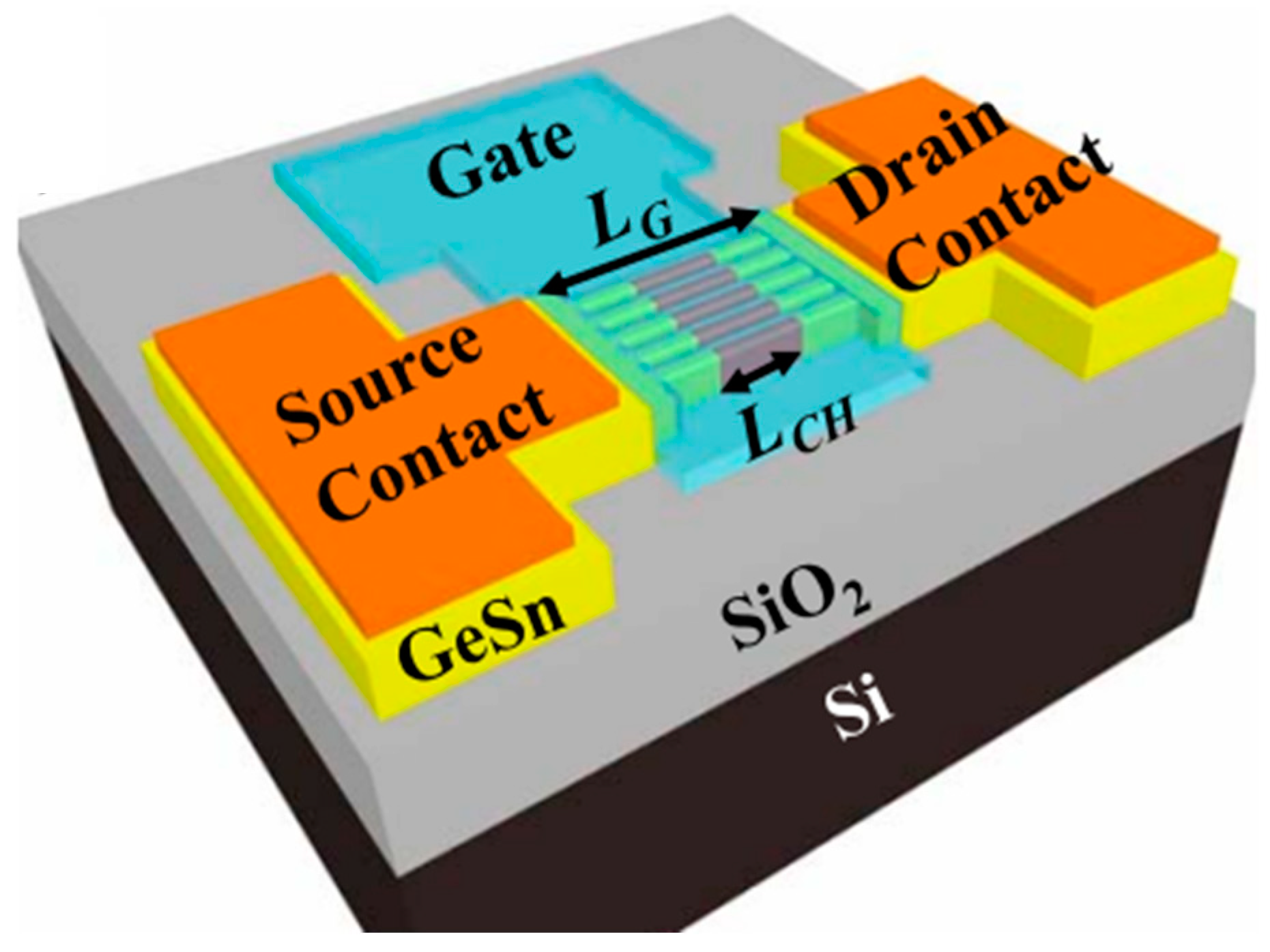
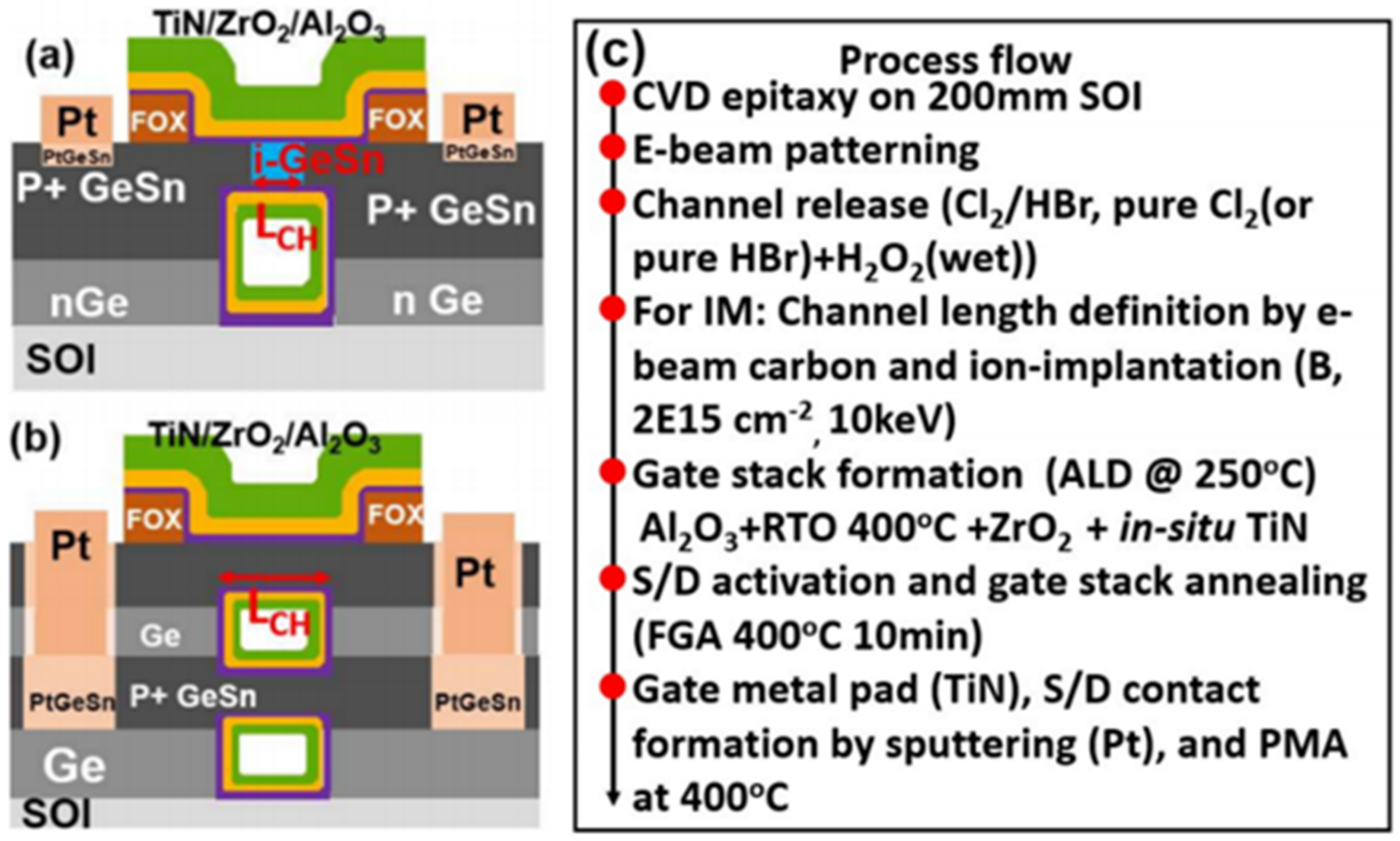
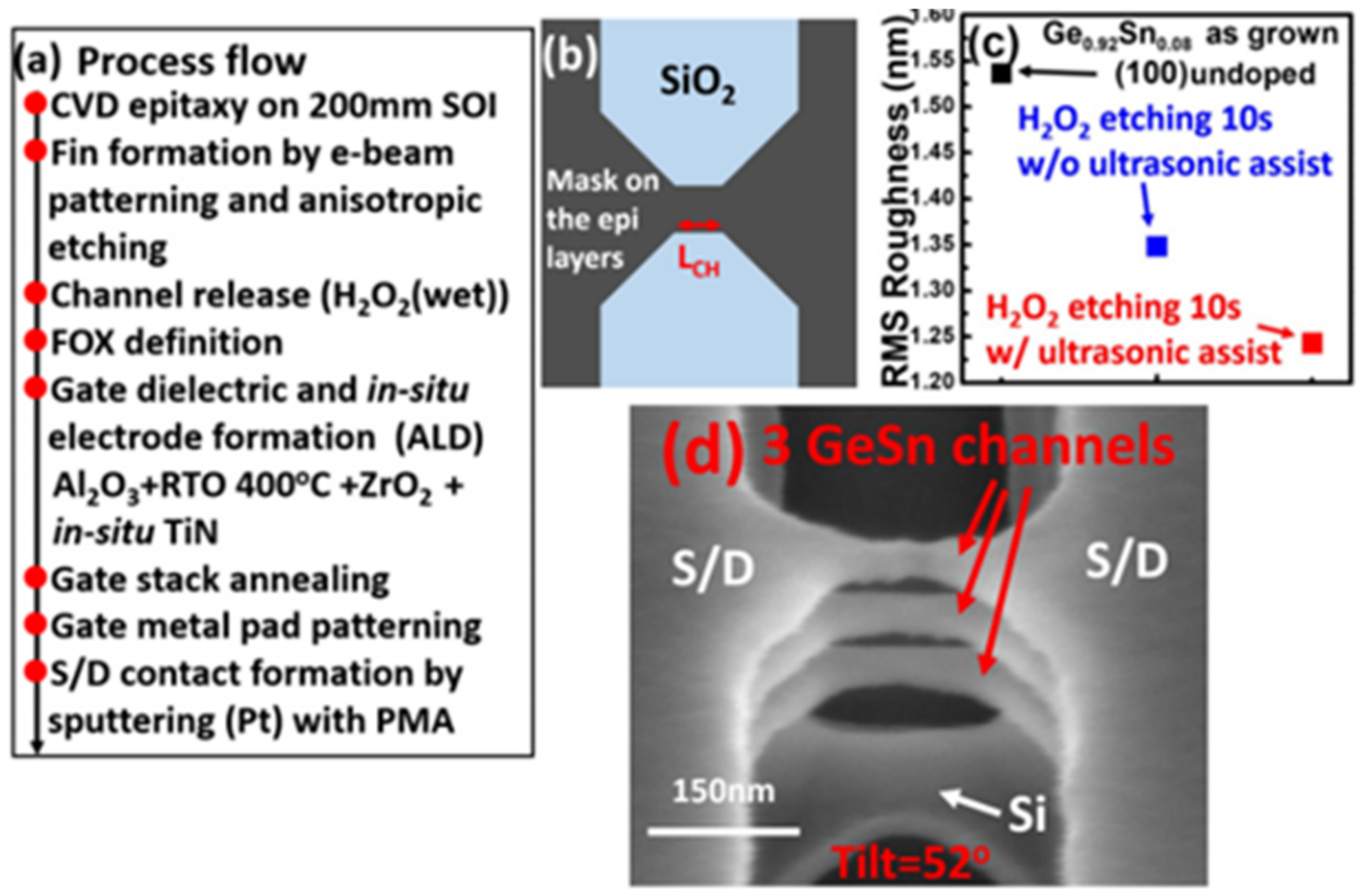
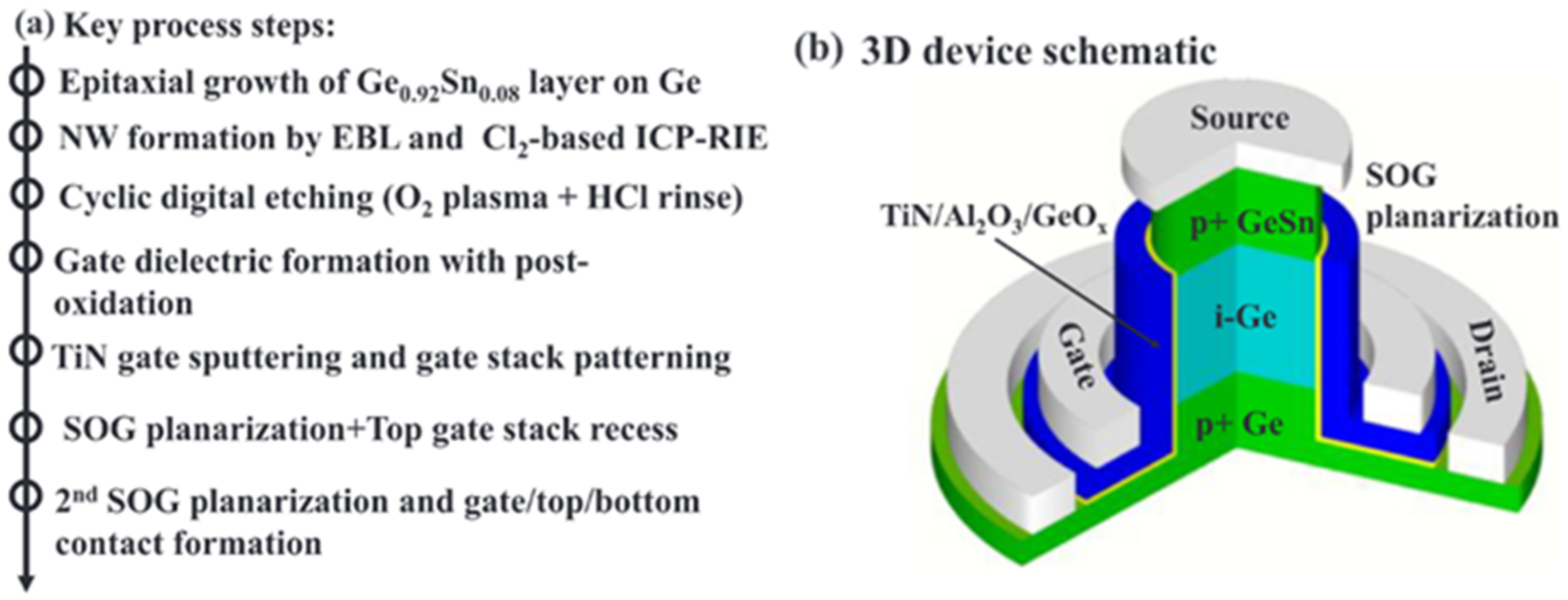
| Year | Institution | Sn Content (%) | N-Type | P-Type | Doping Concentration (cm−3) | Activation Temperature (°C) | Contact Metal | Ref. |
|---|---|---|---|---|---|---|---|---|
| 2011 | Nagoya University | 2–13 | —— | √ | B: 8 × 1019 | 350–550 | Ni | [163] |
| 2011 | CAS-IOS | 3 | —— | √ | BF2+: —— | 400 | Al | [164] |
| 2012 | NUS and CAS-IOS | 2.4 | √ | —— | P: 2.1 × 1019 | 400 | Al | [165] |
| 2012 | NUS and CAS-IOS | 4.2 | √ | √ | P: 1 × 1021 BF2+: —— | 400 | Ni | [166] |
| 2012 | NUS and CAS-IOS | 3–5.3 | —— | √ | BF2+: >1 × 1020 | 300–500 | —— | [167] |
| 2013 | NUS | 2.4 | √ | —— | P: 2.1 × 1021 | 400 | Al | [168] |
| 2013 | NUS | 4.2 | √ | √ | P: >1 × 1020 BF2+: >1 × 1020 | 400 | Ni | [169] |
| 2013 | NUS | 4.2 | √ | —— | P: —— | 450 | Ni | [170] |
| 2013 | NUS | 4.2 | √ | —— | P: —— | 400 | Ni | [171] |
| 2013 | NUS and CAS-IOS | 5.3 | —— | √ | BF2+: —— | 350 | Ni and Ni–Pt | [172] |
| 2013 | NUS and CAS-IOS | 4.1 | —— | √ | BF2+: —— | —— | —— | [173] |
| 2013 | Stanford University | 7 | √ | √ | P: —— BF2+: —— | 400 | Ti/Ni | [174] |
| 2014 | NUS and AM | 2.4 | √ | —— | Hot P+: >1 × 1020 | 450 | Ti/Ni | [175] |
| 2014 | NUS and AM | 2.6 | √ | —— | P: >1 × 1020 | —— | —— | [176] |
| 2015 | CAS-IOS | 3.2 | √ | —— | P: 7.64 × 1020 | 500 | Ni/Al | [177] |
| 2016 | Xidian University | 4 | —— | √ | BF2+: —— | —— | Ni | [178] |
| 2016 | CAS-IOS | 8 | —— | √ | B: —— | 300 | Ni/Al | [179] |
| 2017 | Xidian University | 4 | —— | √ | BF2+: —— | —— | Ni | [180] |
| 2017 | National Taiwan University | 8 | √ | —— | P: —— | 300–350 | Ni | [181] |
| 2019 | CAS-IOS | 6 | —— | √ | BF2+: —— | 450 | Ni/Al | [182] |
| 2020 | CAS-IOS | 9 | √ | √ | B: —— P: —— | 500 | Ni Al/Ti/Au | [183] |
| 2020 | National Chiao Tung University | 2.8 | —— | √ | BF2+: —— | 400 | Al | [184] |
| Year | Sn Composition | GeSn Thickness | Structure | Cutoff | Responsivity | Ref. |
|---|---|---|---|---|---|---|
| 2012 | 9% | 13 or 20 nm | GeSn/Ge 3QWs | 2200 nm | 0.1 A/W at 5 V | [58] |
| 2014 | 0.9% | 327 nm | Bulk | 1800 nm | —— | [59] |
| 3.2% | 76 nm | 1900 nm | —— | |||
| 7.0% | 240 nm | 2100 nm | 0.18 A/W at 10 V | |||
| 2014 | 10% | 95 nm | Bulk | 2400 nm | 1.63 A/W at 50 V | [60] |
| 2015 | 10% | 95 nm | Bulk | 2400 nm | 0.26 A/W | [61] |
| 2019 | 12.5% | 140 and 660 nm | Bulk | 2950 nm | 2 A/W | [63] |
| 15.9% | 250 and 670 nm | 3200 nm | 0.044 A/W | |||
| 15.7% | 165, 585, and 254 nm | 3400 nm | 0.0072 A/W | |||
| 17.9% | 310, 550, and 260 nm | 3350 nm | 0.0038 A/W | |||
| 20% | 450 and 950 nm | 3650 nm | 0.0067 A/W | |||
| 22.3% | 380 and 830 nm | 3650 nm | 0.0032 A/W |
| Year | Sn Composition | GeSn Thickness | Structure | Cutoff | Responsivity | Ref |
|---|---|---|---|---|---|---|
| 2009 | 2% | 350 nm | n–GeSn/i–GeSn/P-Si | 1750 nm | - | [57] |
| 2016 | 7% | 200 nm | p–Ge/i–GeSn/n–Ge | 2200 nm | 0.15 A/W at 1 V | [62] |
| 10% | 200 nm | 2600 nm | 0.07 A/W at 1 V | |||
| 2018 | 11% | 700 nm | p–Ge/p–GeSn/i–GeSn/n–GeSn/n–Ge | 2650 nm | 0.32 A/W | [65] |
| 2019 | 8% | 25 nm | p+–Ge/i-QWs/n+–Ge | 2000 nm | 0.2 A/W | [66] |
| Year | Structure | Sn (%) | Thickness (nm) | Cavity Width (μm) | Pumping | Tmax (K) | Threshold (kW/cm2) | Ref |
|---|---|---|---|---|---|---|---|---|
| 2015 | Bulk | 12.6 | 560 | 5 | Pulsed 1064 nm | 90 | 1000 at 90 K 325 at 20 K | [70] |
| 2016 | Hetero | 11 | 260 and 760 | 5 | Pulsed 1064 nm | 110 | 68 at 10 K 166 at 90 K 398 at 110 K | [71] |
| 2017 | Bulk | 7.3 | 210 and 680 | 5 | Pulsed 1064 nm | 77 | 300 at 77 K | [73] |
| 9.9 | 280 and 850 | 140 | 117 at 77 K | |||||
| 11.4 | 180 and 660 | 140 | 160 at 77 K | |||||
| 14.4 | 250 and 670 | 160 | 138 at 77 K | |||||
| 15.9 | 210 and 450 | 77 | 267 at 77 K | |||||
| 16.6 | 160, 680, and 290 | 140 | 150 at 77 K | |||||
| 17.8 | 310, 550, and 260 | 180 | 171 at 77 K | |||||
| 2018 | Bulk | 22.3 | 380 and 830 | 5 | Pulsed 1064 nm | 150 | 203 at 77 K 609 at 150 K | [75] |
| Pulsed 1950 nm | 180 | 137 at 77 K | ||||||
| 2018 | QWs | 13.8 | 22 (4×) | —— | Pulsed 1950 nm | 20 | —— | [83] |
| 14.4 | 31 (4×) | —— | 90 | 25 at 10 K 480 at 90 K | ||||
| 2019 | Bulk | 20 | 450 and 970 | 5 | Pulsed 1064 nm | 120 | 516 at 77 K | [76] |
| 20 | 260 | 384 at 77 K | ||||||
| 100 | 260 | 356 at 77 K | ||||||
| planar | 260 | 330 at 77 K | ||||||
| 5 | Pulsed 1950 nm | 140 | 132 at 77 K | |||||
| 20 | 270 | 88 at 77 K | ||||||
| 100 | 270 | 47 at 77 K | ||||||
| planar | 270 | 74 at 77 K |
| Year | Structure | Sn (%) | Thickness (nm) | Disk Size (μm) | Pumping | Tmax (K) | Threshold (kW/cm2) | Ref |
|---|---|---|---|---|---|---|---|---|
| 2016 | Bulk | 8.5 | 800 | 8 | Pulsed 1064 nm | 90 | 125 at 50 K | [74] |
| 12.5 | 560 | 8 | 130 | 220 at 50 K | ||||
| 2018 | Hetero | 16 | 418 | 20 | Pulsed 1064 nm | 230 | 134 at 15 K | [78] |
| 375 at 135 K | ||||||||
| 640 at 190 K | ||||||||
| 790 at 230 K | ||||||||
| 2018 | Hetero | 14.5 | 380 | 8 | Pulsed 1064 nm | 100 | 300 ± 25 at 20 K 250 at 50 K | [84,86] |
| Pulsed 1550 nm | 120 | 420 ± 10 at 20 K | ||||||
| MQW-A | 13.3 | 22 (10×) | Pulsed 1064 nm | 100 | 35 ± 4 at 20 K | |||
| Pulsed 1550 nm | 120 | 45 ± 3 at 20 K | ||||||
| MQW-B | 13.5 | 12 (10×) | Pulsed 1064 nm | No lasing | ||||
| Pulsed 1550 nm | 20 | —— | ||||||
| 2020 | Bonded bulk | 5.4 | 40 | 9 | Pulsed 1064 nm | 85 | 0.8 at 25 K | [80] |
| 12 | 100 | |||||||
| 9 | CW 1550 nm | 72 | 1.1 at 25 K | |||||
| 2020 | Low TDD bulk | 7 | 500 | 7 | CW 1550 nm | 80–95 | 10 | [81,82] |
| 8.1 | 6 | 8 | ||||||
| 10.5 | 5 | 8.9 at 25 K | ||||||
| 8 | 11.6 at 25 K | |||||||
| Year | Institution | Transistor Type | Sn Composition (%) | SS (mV/dec) | Ion/Ioff | VDS (V) | Refs |
|---|---|---|---|---|---|---|---|
| 2017 | University of Notre Dame | Ge/GeSn p-type TFETs | 11 and 12.5 | 215 | 9.2 × 103 | −0.5 | [99] |
| 2017 | NUS | GeSn FinFET on GeSnOI | 8 | 79 | >104 | −0.5 | [93] |
| 2017 | National Taiwan University | Vertically Stacked GeSn Nanowire pGAAFETs | 6 and 10 | 84 | - | −1 | [214] |
| 2017 | National Taiwan University | GeSn N-FinFETs | 8 | 138 | 103 | - | [94] |
| 2018 | National Taiwan University | GeSn N-Channel MOSFETs | 4.5 | 180 | - | - | [215] |
| 2018 | National Taiwan University | Vertically Stacked 3-GeSn- Nanosheet pGAAFETs | 7 | 108 | 5 × 103 | −0.5 | [91] |
| 2020 | PGI 9 | Vertical heterojunction GeSn/Ge gate-all-around nanowire pMOSFETs | 8 | 130 | 3 × 106 | −0.5 | [216] |
Publisher’s Note: MDPI stays neutral with regard to jurisdictional claims in published maps and institutional affiliations. |
© 2021 by the authors. Licensee MDPI, Basel, Switzerland. This article is an open access article distributed under the terms and conditions of the Creative Commons Attribution (CC BY) license (https://creativecommons.org/licenses/by/4.0/).
Share and Cite
Miao, Y.; Wang, G.; Kong, Z.; Xu, B.; Zhao, X.; Luo, X.; Lin, H.; Dong, Y.; Lu, B.; Dong, L.; et al. Review of Si-Based GeSn CVD Growth and Optoelectronic Applications. Nanomaterials 2021, 11, 2556. https://doi.org/10.3390/nano11102556
Miao Y, Wang G, Kong Z, Xu B, Zhao X, Luo X, Lin H, Dong Y, Lu B, Dong L, et al. Review of Si-Based GeSn CVD Growth and Optoelectronic Applications. Nanomaterials. 2021; 11(10):2556. https://doi.org/10.3390/nano11102556
Chicago/Turabian StyleMiao, Yuanhao, Guilei Wang, Zhenzhen Kong, Buqing Xu, Xuewei Zhao, Xue Luo, Hongxiao Lin, Yan Dong, Bin Lu, Linpeng Dong, and et al. 2021. "Review of Si-Based GeSn CVD Growth and Optoelectronic Applications" Nanomaterials 11, no. 10: 2556. https://doi.org/10.3390/nano11102556
APA StyleMiao, Y., Wang, G., Kong, Z., Xu, B., Zhao, X., Luo, X., Lin, H., Dong, Y., Lu, B., Dong, L., Zhou, J., Liu, J., & Radamson, H. H. (2021). Review of Si-Based GeSn CVD Growth and Optoelectronic Applications. Nanomaterials, 11(10), 2556. https://doi.org/10.3390/nano11102556








